Join our Adventure: Get all my insider tips for motorhoming & road trips
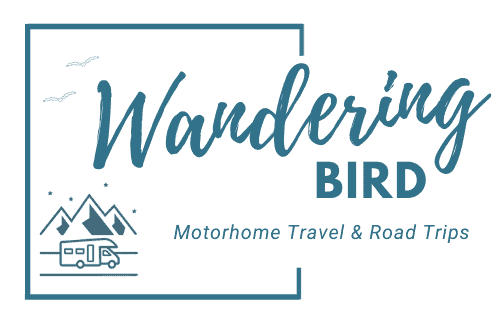

Motorhoming and Campervanning in Ireland- The Ultimate Guide
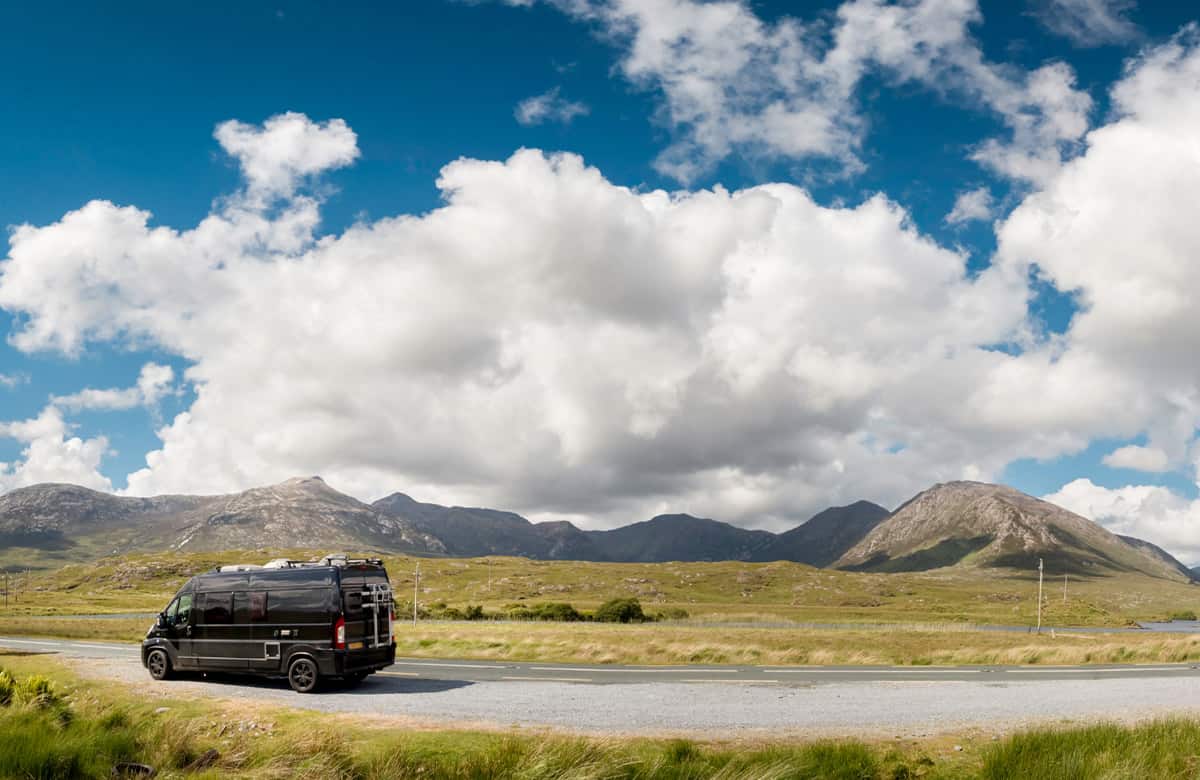
Planning to visit Ireland with a motorhome or campervan? Want to get some tips for places to visit, where to stay, routes to take and more? Here’s everything you need to know about motorhoming or campervanning in Ireland.
Don’t forget to download your FREE motorhome travel checklist below to help you plan your Irish road trip.
*We work hard to make this the best motorhome travel blog and road trip website possible, full of helpful content for you. The website is supported by our readers, so if you buy through links on this site we may earn a commission- at no extra cost to you. All opinions remain our own .
If you find this post useful, you can also treat us to a coffee – we promise to enjoy it while creating more useful content like this- we might even indulge in a biscuit (or two!)
JUMP AHEAD TO...
Campervanning in Ireland – why you should go!
As I write this, I’m sitting in my motorhome by a beach in the Republic of Ireland. Sure, it’s rainy, but that’s not detracting from the beauty of this country. It’s not called the Emerald Isle for nothing!
Put simple, Ireland is a beautiful place for a road trip. There’s so much history, beautiful roads and places to explore and plenty of hospitable places to find food and entertainment, both in Northern and Southern Ireland (which they prefer to call the Republic.)
You can of course explore Ireland using public transport, but it’s so much better if you have your own vehicle- whether that’s a motorhome or campervan (our preferred options), or a car, caravan or even motorbike.
One of the best things about being able to explore Ireland on a motorhoming holiday is that you can see the differences between the regions and really get a feel for the country in a short space of time. It can also make your trip cheaper if you can buy and prepare your meals instead of having to buy them all- not to mention being able to stay overnight at some breathtaking locations.
In this guide, we’re going to share with you everything you need to know to go motorhoming or campervanning in Ireland, including getting to Ireland from the UK (or elsewhere), planning your route, where to stay (motorhome campsites, alternatives or wild camping with your camper), some road trip ideas and places to visit, driving tips and other practical advice to help you have an amazing Irish road trip.
Don’t forget to grab your free motorhome travel checklist which will help you plan and organise everything you need.
New to motorhoming?
Feeling a bit overwhelmed.
It can be hard to start a new hobby. Let us show you how it all works so you can travel with confidence
This form subscribes you to our mailing list. Join over 15,000 others in our tribe and get our best motorhoming tips and tricks in our weekly newsletter.
We hate spam and spammers are the worst.
You can unsubscribe at any time.
Motorhoming in Ireland- When to go
Like most of the UK, the best time for a road trip is probably between April and October if you’re just considering the weather.
However, remember that it’s called the ‘Emerald Isle’ because it’s so green… and it’s green because it rains. A lot. Expect rain at any time of the year (yet another reason to be glad of your own vehicle… you can hide inside if the weather turns!) Of course, there are some sunny days as well, and you’re most likely to get those during the summer.
July and August are the main school holidays, so everything will be a lot busier then AND prices for everything will be higher- ferries, campsites and even some attraction fees.
Other major events in Ireland include the Rugby Six nations at the beginning of the year (which is mainly centred on Dublin), The Gathering- a traditional dancing and music festival held each February in Kilkenny and St Patricks Day on 17th March each year- the entire country celebrates it with a passion (celebrations often last a week!)
There’s also the Galway Food Festival in April, the Taste of Dublin food festival in June and National Heritage Week at the end of August, as well as many others.
So there’s never a ‘bad’ time to visit Ireland. If you’re able to travel outside of school holidays we highly recommend it, and you’ll never forget a St Patrick’s Day in Dublin! (Actually, that’s not strictly true; friends of mine moved to Dublin with their kids and I’ve spent many St Patrick’s Days there- I can’t seem to remember much of them at all… ? )
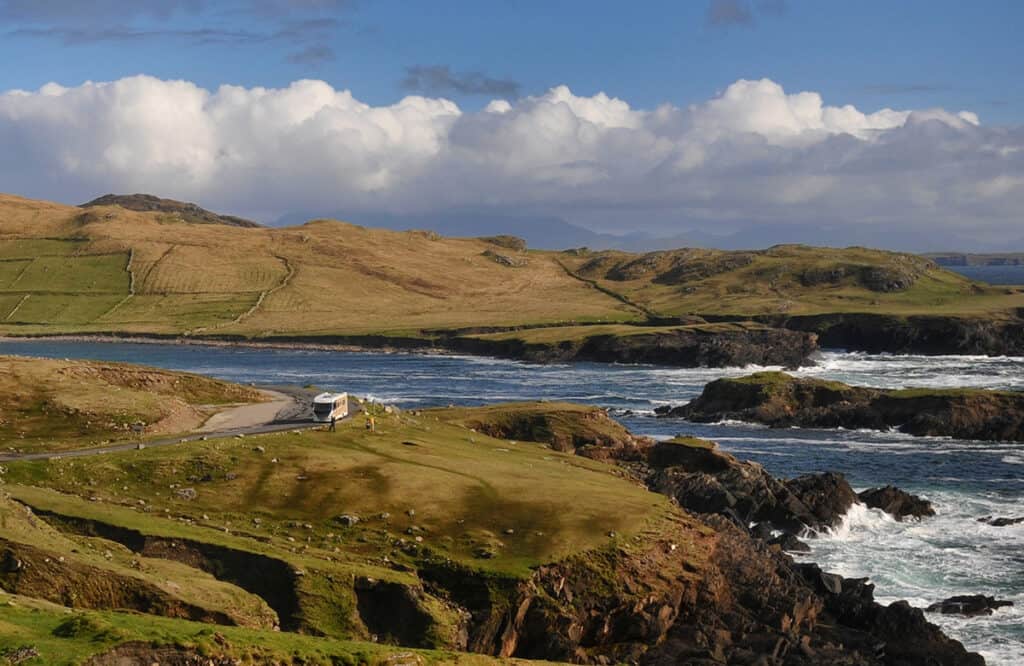
Highlights of an Ireland campervanning holiday
Some of the best places to visit in Ireland with a campervan or motorhome include:
- Cliffs of Moher – unbelievably dramatic
- The Wild Atlantic Way- 1700 miles of dramatic coastline and traditional Irish culture
- Giants Causeway (Northern Ireland)
- Dark Hedges road- famous as a Game of Thrones filming location . You can drive down it, but not in a motorhome!
- Dublin- one of our favourite cities in Europe
- The Ring of Kerry- one of the best road trips in Ireland
- The Rock of Cashel- Ireland’s most visited Heritage site
- Blarney Castle and the Blarney Stone
- Dunmore Head- mainland Ireland’s most westernmost point
- Torc waterfall- one of the best waterfalls in Europe
Talking of TV shows and movies, here are some of the biggest which were shot in Ireland:
- Harry Potter and the Half-Blood Prince (Cliffs of Moher, Lemon Rock)
- Star Wars: The Force Awakens/The Last Jedi (Skellig Michael island)
- Braveheart (yes, I know it’s about Scotland!)- Bective Abbey, Curragh Plains, Trim Castle)
- Saving Private Ryan Ballinesker Beach- the setting for the D-Day landings in opening 20 minutes
- The Princess Bride (Cliffs of Moher)
- Game of Thrones (see some guided tours here )
Of course, there are MANY other incredible locations and places to visit in Ireland- we can’t possibly list them all.
If you enjoy reading books before a trip, here are some we recommend:

See more fun and practical motorhoming books we recommend reading
Getting to Ireland from Britain with a motorhome or camper
Ok, before we go any further, let’s clear up the confusion.
- Northern Ireland IS part of the UK. The Republic of Ireland is not
- The Republic of Ireland is in the EU. Northern Ireland is not
- Great Britain (or Britain) refers to the landmass of England, Scotland and Wales
- The British Isles is the UK AND the Republic of Ireland (plus the Channel Islands, Scilly Isles and thousands of other small islands.) There’s an excellent article explaining it all here
However, even knowing all that, many people (myself included!) incorrectly say going from the UK to Ireland, when they mean from Britain. So, my apologies should I make that error elsewhere.
Crossing from Northern Ireland to Southern Ireland
To get to Republic of Ireland from Northern Ireland you… drive across the border. It used to be incredibly easy- it’s now a little harder thanks to BREXIT, but it’s still just a matter of driving south. There will be a border to cross and you’ll need to carry all the correct documents. Depending on your route, there may be a toll charge.
Getting to Ireland by Ferry from rest of the UK
For the rest of the UK (otherwise known as Britain!), if you want to take your own motorhome or campervan across to Ireland, you’ll need to get on a ferry. There are a few ferry routes to choose from:
- Holyhead to Dublin (Irish Ferries)
- Pembroke to Rosslare (Irish Ferries)
- Liverpool to Dublin (P&O Ferries)
- Cairnryan to Larne (P&O Ferries)
- Cairnryan to Belfast (Stena Line)
- Liverpool to Belfast (Stena Line)
- Holyhead to Dublin (Stena Line)
- Fishguard to Rosslare (Stena Line)
Getting to Ireland from France
There are also ferries which go directly from France to Ireland.
- Cherbourg to Dublin which usually runs 3 times weekly (Irish Ferries)
- Cherbourg to Rosslare once per week (Brittany Ferries)
- Roscoff to Cork twice weekly (Brittany Ferries)
- Roscoff to Rosslare once weekly (Brittany Ferries)
- Cherbourg to Rosslare which runs three times a week (Stena Line)
Travelling around Ireland
Once you’re over in Ireland, whether it’s North or South, the road system is very good and easy to navigate. We’ll talk more about the rules, speed limits and other things to know shortly.
New to motorhome or camper travel in Europe? You might find these posts helpful:
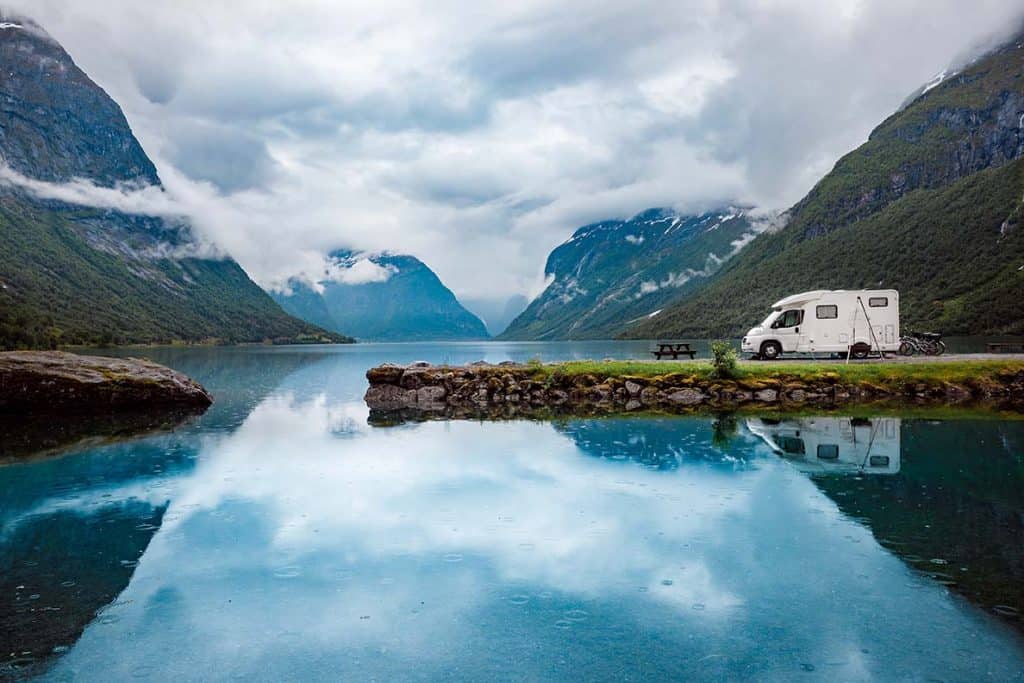
See all our Europe motorhoming posts here
NEED GEAR? If you need any kit or essentials for motorhoming in Europe, here’s what we recommend and where to find it
Hiring a motorhome to tour Ireland
Of course, if you don’t have or want to pay to take your vehicle to Ireland, or you’re travelling from further away, the easiest option is to fly in to Ireland and rent a motorhome or campervan to use during your stay. Just make sure to ask how to get from the airport to the rental agency- not all of them are at the airport itself and you might need to book a taxi.
The biggest airports in Ireland are:
- Dublin Airport – east coast
- Cork Airport – south coast
- Shannon Airport – west coast (near Limerick)
- Knock Airport – mid/ north West (but still in the Republic of Ireland)
- Belfast Airport – in Northern Ireland
To rent a vehicle in Ireland you must:
- be at least 21 years old, although many hire car companies have a minimum age of 25 (certain car categories may require older)
- There may be restrictions for over 70s as well
- have had a driving licence for more than one year
- show identification (identity card for EU citizens or a valid passport for other nationalities)
You can expect to pay around £100/ day for a campervan in June out of peak season- be sure to ask the right questions so you know what to expect from your motorhome or campervan rental
Bear in mind that you might need to pay an additional fee to drive from the Republic of Ireland into Northern Ireland (or vice versa) so check with your hire company before you book.
Don’t forget, it is YOUR responsibility to make sure the vehicle has the required safety equipment. The on-the-spot fines apply to you as the driver, not the company. Check in advance with the company what kit they will provide with the vehicle and what you will need to bring.
Take a list of what is legally required with you and check it off one by one as you are given the handover. Do not drive until you are happy you comply with the local laws.
Want to rent a vehicle for your road trip?
These might help:
- Discover incredible deals for motorhome/ camper rentals
- Find the best deals for car rental
READ: 10 essential questions to ask before you rent a motorhome
Campervan rules in Ireland- what gear you need to carry
Things you need to carry to legally drive in ireland.
You’ll be pleased to know that, unlike motorhoming in France or much of the rest of Europe, Ireland is similar to the rules in the UK, so there are very few things you LEGALLY have to carry (although we recommend them anyway.) There are:
- UK sticker attached to the back of vehicle or reg plates (and trailer if you have one)
- A spare wheel (and tools to change it!), or a tyre repair kit.
- If you wear glasses you MUST carry a spare pair
- Crash helmets are mandatory for motorbike/ moped riders and passengers
NOTE: Hi-vis reflective jackets , Warning triangles and Headlight beam converters (if you have a UK vehicle) are not required in Ireland. If you have a European vehicle (ie- you normally drive on the right), you will need headlight converters.

CONCERNED ABOUT SECURITY?
Want to protect your motorhome or campervan while travelling & at home?
Motorhome & campervan theft is sadly on the rise. Don’t be part of that statistic.
Grab our FREE guide when you join our mailing list and get the best security tips to start protecting your vehicle today
Join 15,000+ others in our motorhome & road trip tribe. We share tips, itineraries, mistakes and helpful guides like this. We never spam (yuck) and you can unsubscribe at any time.
What documents do you need to road trip in Ireland?
If you’re driving in Ireland, you need to carry the following documents:
- Passport (or identity card)
- Driving licence (check it is in date!)
- Motorhome Insurance documents- check you are covered for driving in Europe
- Breakdown cover
- Vehicle V5 logbook (which must show your correct address)
- Vehicle must be legally taxed and MOT’d
- Trailer certification
- Green card (get from your vehicle insurer)
- International Driving Permit if required
- Personal travel insurance
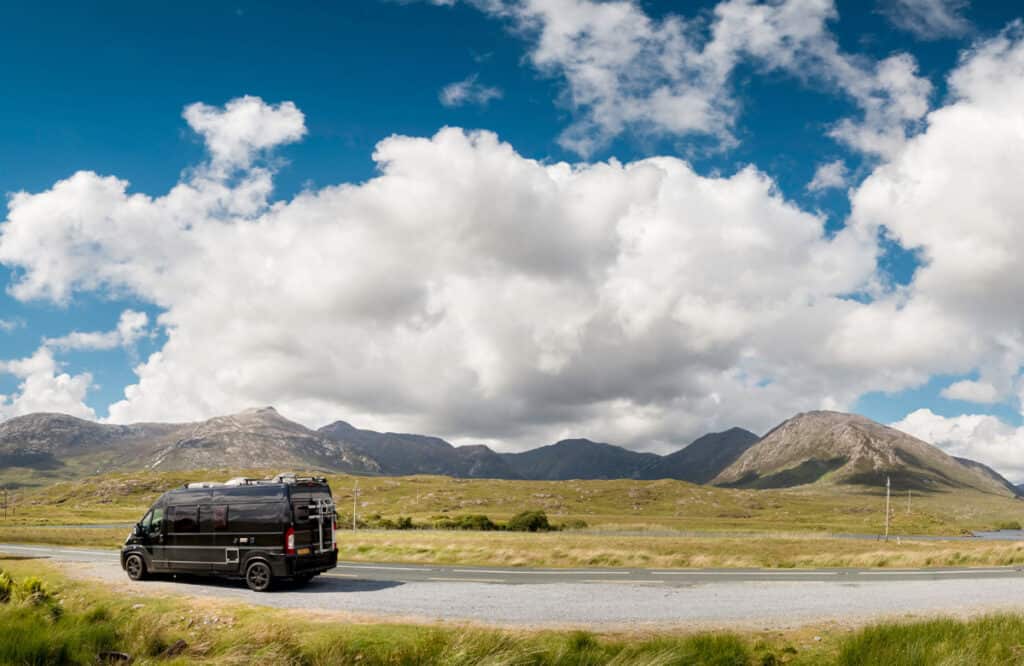
Do I need an international driving permit to drive in Ireland?
Most UK citizens do not need an IDP to drive in Ireland, as long as you have a card driving licence issued in the UK (in date, of course!)
You might need one if you have:
- a paper driving licence only
- a licence issued in Gibraltar, Guernsey, Jersey or the Isle of Man
(If you do need an IDP, here’s an in-depth guide on how to get an International Driving Permit and which one(s) you need from a UK post office.
Touring Ireland in a campervan- Other useful things you might need
We’ve been touring Europe in our motorhome for several years. We’ve tried all sorts of kit- some useful, some not so much.
Here is a list of things we highly recommend when motorhoming in Ireland, but which are NOT essential:
- Motorhome WiFi – learn our favourite way to get internet on the road
- Toll pass (see below)
- TV- If you’d like TV in your motorhome or camper , here’s how to get it.
- Motorhome sat-nav – get one you can enter your motorhome dimensions into, like these
- Motorhome security camera – this thing is GOLD for allowing us to go exploring and leave the van for a short time.
- Solar panel- perfect if you want to wild camp in Ireland with your motorhome
- Inverter- a motorhome wild camping essential
- An awesome motorhoming logbook to record and remember your adventures!
Motorhome Stopovers and Overnight camper parking in Ireland
Like most countries in Europe, there are several types of places where you can stop with your motorhome or campervan overnight in Ireland.
- Free/ approved motorhome parking schemes
- Wild Camping (we’ll talk more about the legality of that shortly)
Motorhome Campsites in Ireland
Campsites in Ireland are much like other campsites anywhere around the UK or Europe. Some are all-singing and dancing, with pools, entertainment and more, while others are more basic (and usually cheaper!) It’s pretty easy to find a campsite near to you or near to where you are going, especially if you’re a member of club or have a book!
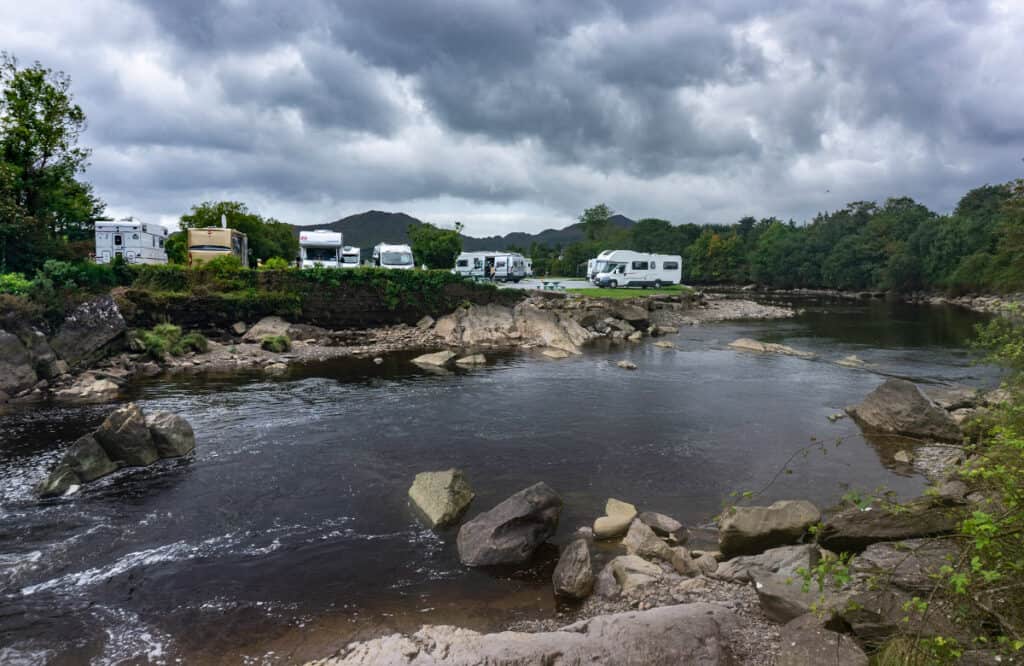
You normally don’t need to book in advance unless you’re visiting in peak season or during a festival (or over St Patrick’s weekend. Also, if you’re a member of one of the UK’s biggest motorhome clubs , they have some sites in Ireland which you can book through their systems.
Be aware that many campsites close for winter, some as early as September and don’t re-open until Easter. So do your research, especially if you’re travelling out of season.
TOP TIP: If you can travel outside peak times, use your ACSI Camping Card to reduce the cost of campsite stays
Aires in Ireland
Ireland, like the UK, does not have ‘aires’ in the same way you might be used to if motorhoming in France , Germany or Italy.
An aire is just an approved overnight motorhome parking area which isn’t a campsite. Ireland DOES have many places where motorhomes and campervans can stay overnight- with permission. But they don’t work in the same way as aires.
Approved overnight motorhome parking
There are several schemes which connect motorhomers and campervanners who don’t want to stay in campsites every night to businesses and places happy to allow overnight parking (usually without facilities). This is in exchange for you buying some of their products or services, such as a meal in a restaurant.
Safe Nights Ireland
One such scheme is Safe Nights Ireland – which has over 350 locations around Northern and Southern Ireland. You can join the scheme for just 15€ a year and get access to any places which are part of the scheme.
Pub Overnight Stops in Ireland
Pubs are a great option for a free overnight parking stop if you’re already going to eat at them. Many of them will allow motorhomes and campervans to stay overnight in their car parks (some even allow caravans). Obviously, this is only for the night- you probably wouldn’t be able to stay there for a week, although I suppose there’s no harm in asking!
READ MORE: How we find places for free overnight motorhome stopovers
Wild camping in Ireland for motorhomes and campers
Is wild camping for motorhomes and campervans allowed in Ireland? The legal answer is no- you’re not allowed to stay anywhere with a motorised vehicle apart from on approved campsites, unless you have the landowners permission.
However, in reality, many people do motorhome wild camping all over Ireland and rarely have a problem.
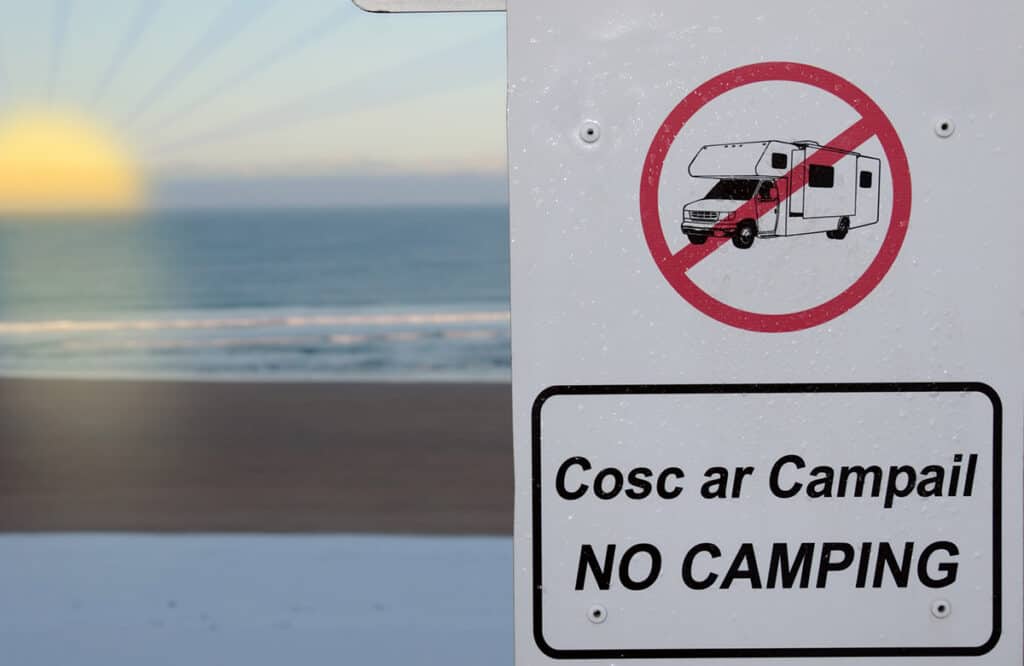
There is a difference between ‘camping’ and ‘overnight parking’. Many people (us included) incorrectly refer to parking up overnight somewhere as motorhome wild camping, instead of overnight parking.
Overnight parking is parking up for one night and then moving on again in the morning. No awnings, outdoor furniture, BBQs, motorhome generators , washing lines or anything OUTSIDE the vehicle. In many remote places, if you arrive late in the afternoon and leave early-ish in the morning, you’ll be absolutely fine to stay overnight, unless there’s a clear sign banning motorhomes or campers overnight.
For tips on how to park overnight without upsetting local residents or drawing unwanted attention, read our complete guide to motorhome overnight parking (which we call wild camping. Sorry)
Wild Camping is a different matter, and is forbidden in Ireland. You will probably be asked to move on and/ or fined by the Police if you look like you are camping with your van.
Remember, you can always ask if you’re allowed to stay. The Irish are incredibly hospitable and if you’re polite and respectful, they’re very likely to allow you to stay without issue (especially if you’ve just paid money to them for something!)
Motorhome wild camping guides for the UK & Europe
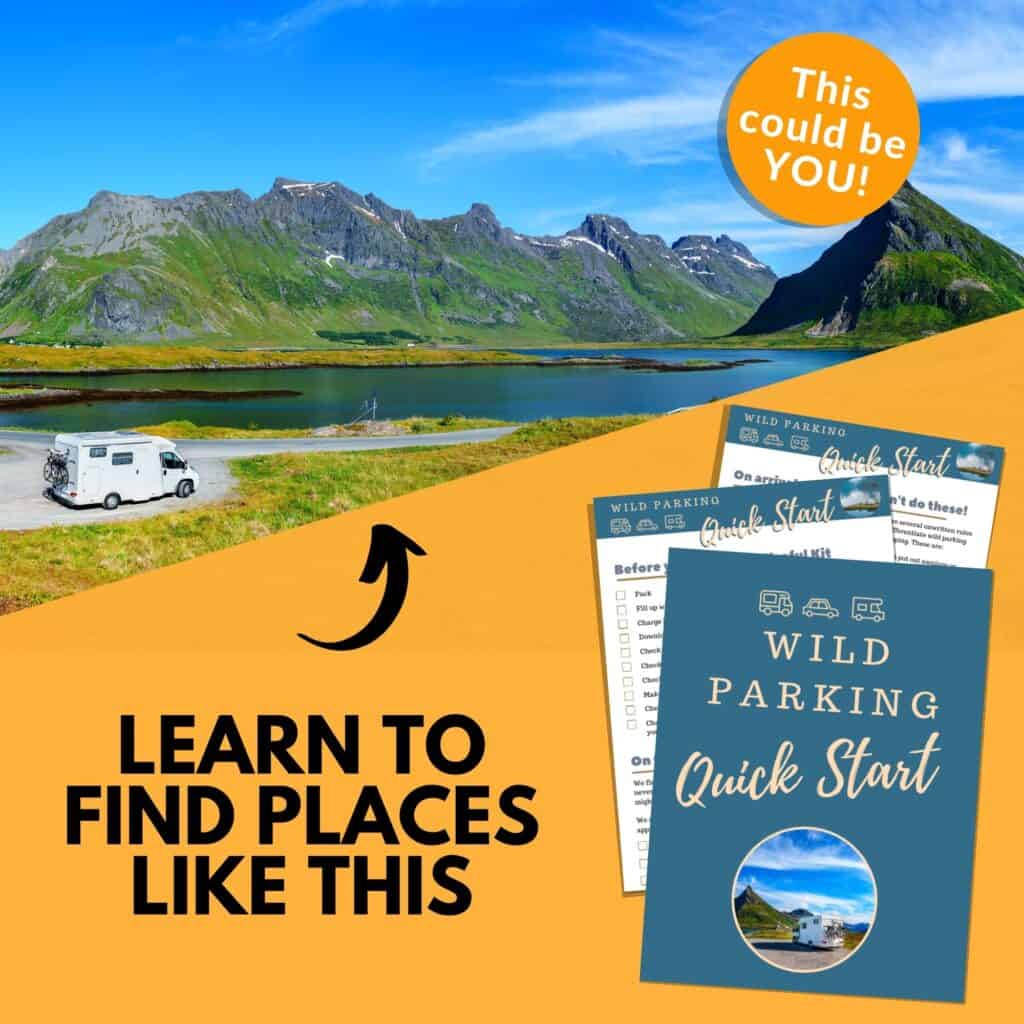
For information on how to find good wild camping places, WHAT to do when you’re there and how to stay safe, check out our step-by-step guide for motorhome wild camping in the UK and Europe, complete with database of 250+ overnight spots we’ve stayed with our motorhome.
Don’t forget to grab your free wild camping checklist here
Motorhome and campervan service points in Ireland
Unlike in Europe, there are very few places to discharge waste and water and refill with fresh water apart from on the campsites. For this reason, it’s worth booking into a campsite for a night every few days, in order to use its services.
Some campsites will allow you to pay a small fee and use the services without paying for an overnight stop- you’l have to ask as you go.
Driving tips for Ireland
Some useful tips for driving in Ireland, whatever your vehicle. Ireland has a fairly good road network, especially around the major towns and cities. However, some of the smaller rural roads can be VERY narrow and many are marked as unsuitable for larger vehicles, like motorhomes.
Often, these small roads are single track, and have passing places. These are places to pull in to let another vehicle go past from the other direction, NOT somewhere to park up and go for a walk.
Also, expect slow-moving farm vehicles on these roads- it can take a while to get anywhere and no-one in Ireland is in much of a hurry. So don’t over-estimate how far you can travel in one day. Also, expect sheep, cows and other animals to wander out into the road in front of you at any moment.
- Drive on the left (like in the UK, the opposite to most of Europe)
- Stay to the left on roads with more than one lane and overtake on the right.
- At roundabouts and junctions, traffic already on the road and coming from the right has priority.
- Motorways are marked with an ‘M’
- Seatbelts are compulsory for front and rear passengers
- All children up to 135 cms in height or up to 12 years of age, must use a suitable child seat (Northern Ireland)
- Handsfree kits are required if using a mobile phone
- Devices warning of speed cameras are forbidden
- Dipped headlights are to be used during poor visibility.
- Motorcycles must use dipped headlights during the day at all times.
Speed Limits in Ireland
IMPORTANT: The Republic of Ireland drives in km/h (like most of Europe). Northern Ireland drives in mph (like the rest of the UK). If you change the settings on your motorhome sat-nav , remember to change it if you cross the border!
Breaking the speed limit in either Northern or Southern Ireland will result in a fixed penalty and/ or penalty points on your driving licence.
On the spot fines are rare, but it is possible to be pulled over by the police force for speeding and given a fixed penalty notice and/ or plus a £100 fine.
Republic of IRELAND
Speed Limits for vehicles under 3.5t are as follows (unless otherwise signed!)
- Motorways- 120km/h (74mph)
- National roads/ dual carriageways- 100 km/h (62 mph)
- Regional roads- 80km/h (50mph)
- Built up areas- 50 km/h (31 mph)
Speed limits for vehicle OVER 3.5t
- Motorways/ – 90 km/h (55 mph)
- National roads/ dual carriageways- 80 km/h (50 mph)
Speed limits in Northern Ireland
- Motorways/ – 70 mph (
- National roads/ dual carriageways- 60mph
- Built up areas- 30 mph (50kph)
Speed cameras in Ireland
There are both static and mobile speed cameras in Ireland. The mobile ones are mostly in vans which are moved around as the Irish police force (Garda Síochána) see fit.
Drink driving laws
The Republic of Ireland has stricter drink driving laws than Northern Ireland, only allowing 50 milligrammes of alcohol in 100 millilitres of blood (the UK and Northern Ireland is 80). As always, don’t drink and drive. If you are a new or a professional driver, the levels are even lower.
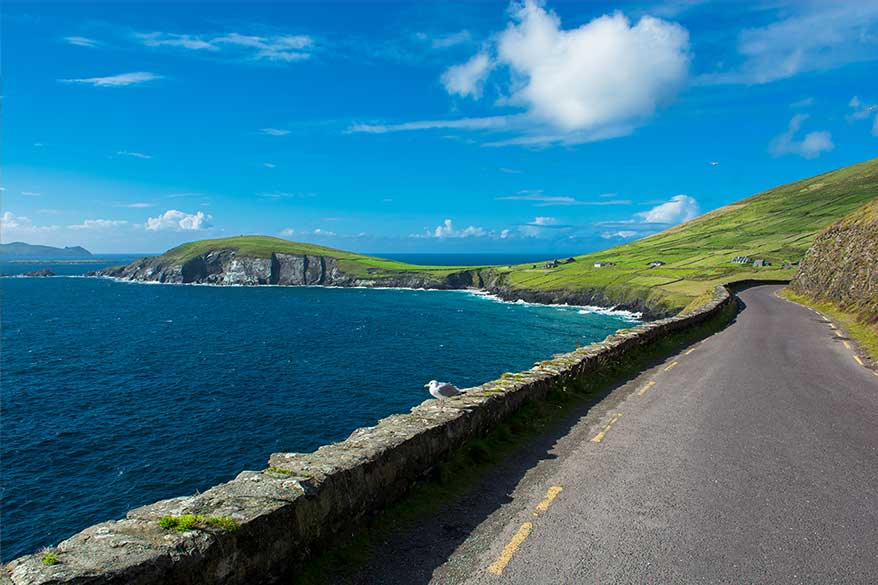
Tolls in Ireland
There are currently no toll roads in Northern Ireland.
There are 11 toll roads in the Republic of Ireland- not as many as you might be used to in France (and luckily not as expensive as Norway! ) You can see where they are here .
You can pay for the tolls using cash at the toll plazas (cards are accepted at a few but not all). Alternatively, you can sign up for a TollTag account and that will charge you as you drive.
The only road where you cannot pay as you drive is the M50. The M50 works a bit like a Dartford Tunnel- you need to pay for using it by 8pm the following day. You can pay at many garages and shops in the area, but the easiest way is online here.
If you are renting a vehicle, you will need to ask them how to pay for tolls/ the M50 but its common for you to need to pay yourself.
Petrol/ Diesel in Ireland
There are plenty of fuel stations across Ireland. As with everywhere, you’ll find the prices slightly higher on the motorways.
Petrol is Unleaded (95 / 98) – Green handles on pump
Diesel has black or yellow handles on pump
Some places are 24h pay at the pump, but may require you to go into the shop and pay the cashier either in advance or after you’ve filled up- there will be a sign to tell you what to do. (Leave your car in front of the pump and make a note of the pump number.)
You can pay using cash or a credit card. Many places do NOT take American Express. You can use your UK cards without a problem.
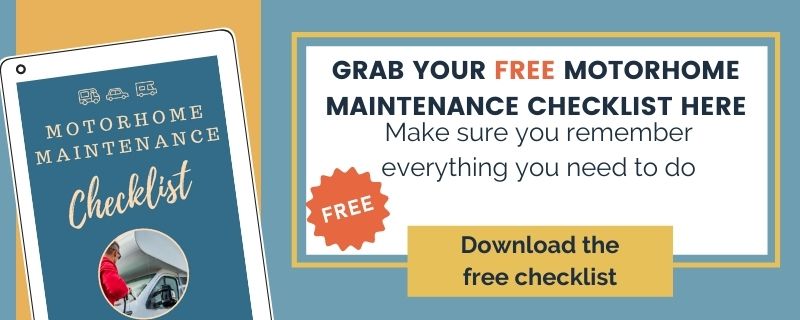
Parking in Ireland
Many places which allow parking during the day or night require payment. Usually you need to pay at the ticket machine display your parking ticket in the windscreen. Not doing this is likely to result in a fine.
Parking is prohibited when the road is marked with a red line or a double yellow line.
A disadvantage of a campervan in Ireland is that parking in cities and towns can be tough- many places have height barriers of around 2.5m (and most vans and motorhomes are taller than that!) Therefore, you would need to find on-street parking in the town, which can be difficult. Alternatively, park up or use a campsite nearby and use public transport to get in.
Getting LPG in Ireland
LPG (GPL) can be found at selected petrol stations and at autogas stations. If buying from a petrol station, you may need to wait for an attendant to turn the system on for you.
You can find places which sell LPG using MyLPG.eu Ireland mostly uses the ACME connector.
LEARN MORE: Learn how we find LPG in Europe for our motorhome
More useful things to know when campervanning in Ireland
Some more tips to help you enjoy your time touring in Ireland.
Emergency Numbers: 112 will get you everything. 999 works as well.
Language – Irish Gaelic and English
Currency – Euros in the Republic of Ireland, GBP (British Pound) in Northern Ireland
Cards – most major credit and debit cards are accepted. American Express is only taken in large stores (often not at fuel stations)
Timezone – GMT (or the same as Britain) Ireland follows Britain in terms of moving forwards or backwards for summer time
Mobile Phone and Internet – You should be able to use your UK mobile and data without any issue in Ireland. If in doubt, check with your provider before you travel.
Tipping- It’s normal to leave around 10-15% of your bill as a tip after eating a meal in a restaurant. A tip for a barman is always appreciated (and can get you access to some hidden whiskies!) Tips for cab drivers and other services are also appreciated.
Shops – Neither Northern Ireland or the Republic of Ireland are particularly expensive in terms of food or goods- it’s about on par with the rest of the UK and you’ll see many of the same shops, especially in Northern Ireland. Tesco and Lidl are common.
The Republic of Ireland is staunchly Catholic and you may find many shops closed on Sundays and religious days. Some of the larger supermarkets and garages may be open for a few hours. Most shops close between 5pm-7pm during the week- supermarkets may be open as late as 10pm.
Northern Ireland follows the UK, so shops are often open 10-4pm on Sundays and close between 5pm-7pm during the week.
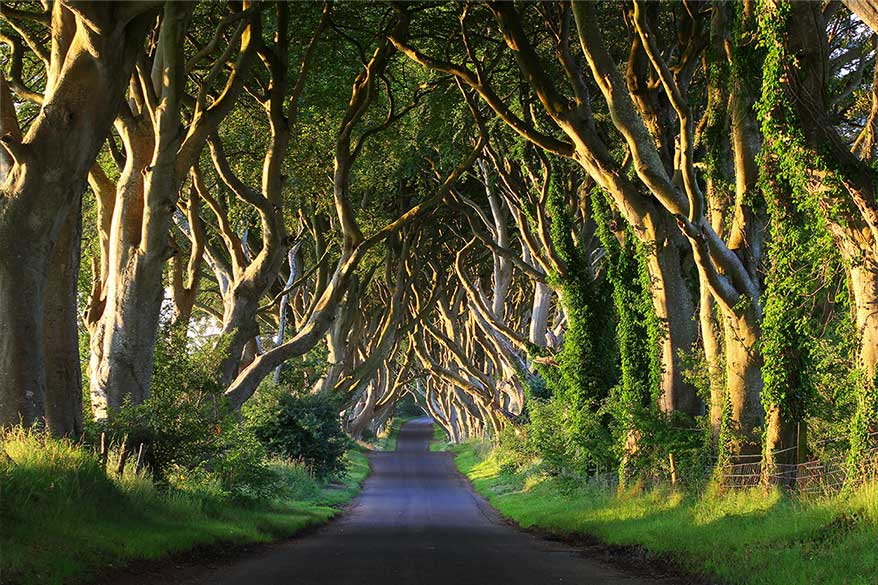
Campervanning in Ireland- security
Ireland, like the UK, has good areas and not-so-good areas in terms of crime rates. Vehicle break-ins do happen, as do petty theft and pickpocketing.
We highly recommend paying extra attention to your motorhome security when travelling in Ireland. You might even wish to fit an extra camper habitation door lock and never leave your vehicle unattended in an unsecure area.
READ MORE: Essential tips for protecting your van at home and on the road
Touring Ireland with a dog
Sadly, both Northern and the Republic of Ireland are not particularly dog-friendly, although some areas are better than others. Most places do not allow dogs into restaurants, cafes or pubs, although they do allow you to sit outside.
You might be allowed to take them on a train, but most buses ban all but the smallest lap dogs. They are allowed on beaches out of season, but during summer they are banned.
Having said all that, there are some INCREDIBLE places to walk your dog, so if you’re not fussed about eating out or using public transport, then you’ll have no problem with your dog in Ireland.
Getting to Ireland from Britain with a dog
Now that BREXIT has been and gone, the rules for entering Ireland with a dog have changed.
In order for your dog to travel into Ireland, you will need:
- A Microchip
- A rabies vaccination (you must wait 21 days before travel)
- An Animal Health Certificate (or Pet Passport for European pets)
- A Tapeworm treatment, administered 1-5 days before travel by an approved vet. (Note: you do NOT need tapeworm for going from Ireland to Britain)
You shouldn’t need to do anything to take your pet from Northern Ireland into the Republic of Ireland, or vice versa. For the most up-to-date information, check the Deara website
Using a Drone in Ireland
You can use a drone in Ireland, but there are certain things you need to do first.
READ MORE: What’s the best travel drone (and how to choose)
To use your drone in Ireland you need to register here (unless your drone weighs less than 250g!) If you do not do that, you must not fly higher than 15 meters.
Drones and similar remote-controlled flying devices must be kept at least a minimum 30m from people, vehicles and buildings that are not connected with the drone operator. Flying must happen in daylight only, below 120m and never fly closer than 5km to airports. The drone must always remain within the sight of the operator.
Please check for local regulations and military or other special restricted areas where all the aforementioned activities are forbidden by law.
Other posts you might find useful:
- Tips for motorhoming in Scotland
- Motorhoming in Europe- complete guide
- The best logbooks to record and remember your road trip
- Essential motorhome checks to do before you travel
See all our Europe travel tips and ideas
See all our UK road trip tips
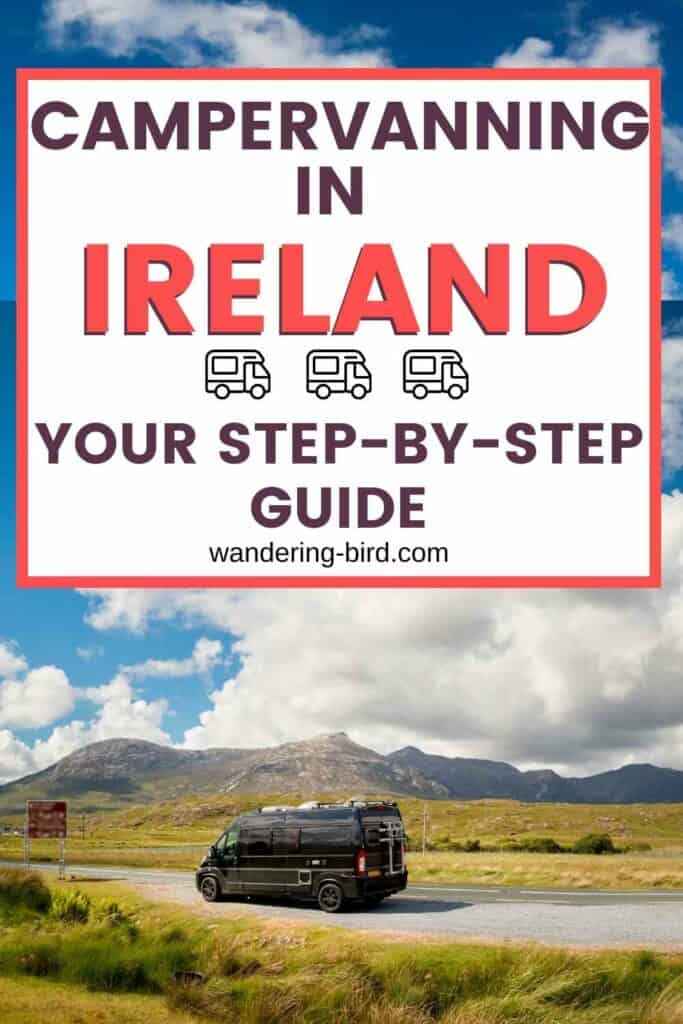
Kat never planned to buy a motorhome. She also never planned to quit her job as an air traffic controller, go touring around Europe in said motorhome, start one of the UK’s largest motorhome travel websites… or get a cocker spaniel.
Find out how she went from stuck in the rat race to being a digital nomad and inspiring thousands of people to have their own epic adventures here.
If you’d like to connect with Kat, send her an email or follow her adventures on social media.
Last update on 2024-05-14 / Affiliate links / Images from Amazon Product Advertising API
Sharing is caring!
Similar Posts
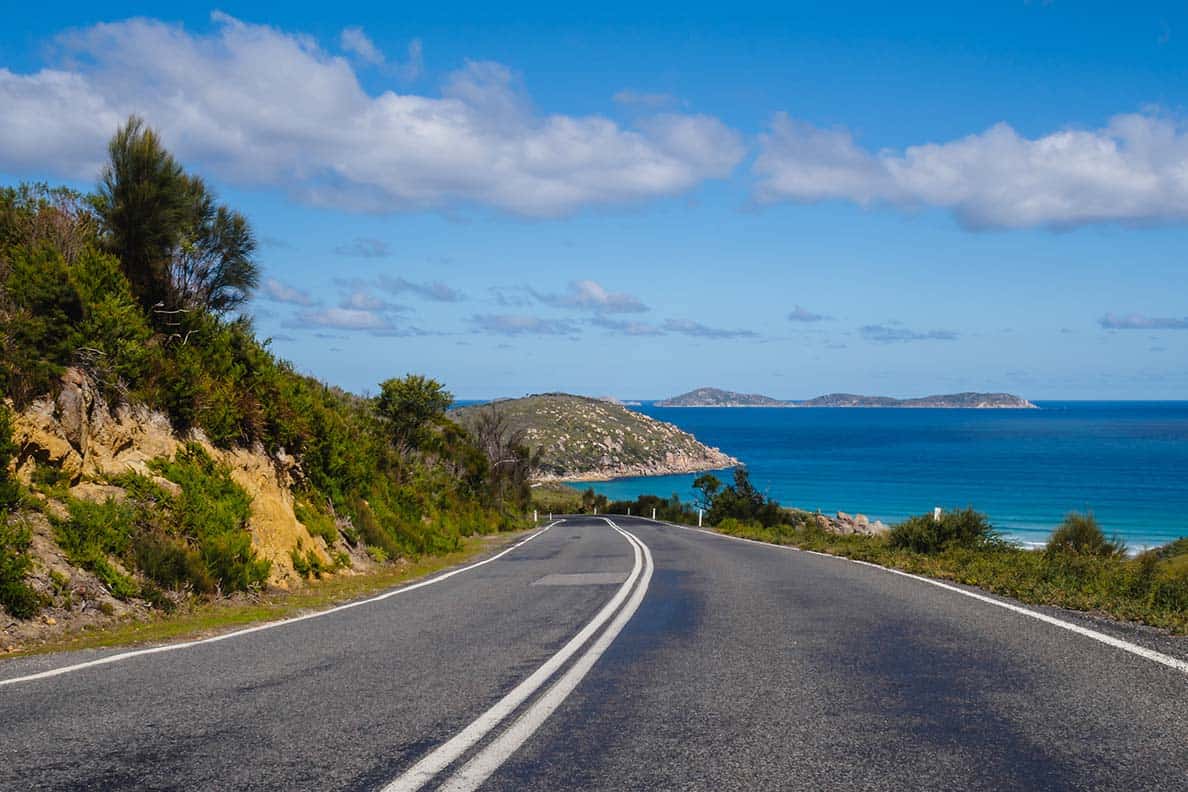
Motorhome Travel & Driving in Europe after BREXIT- 10 essential things to know
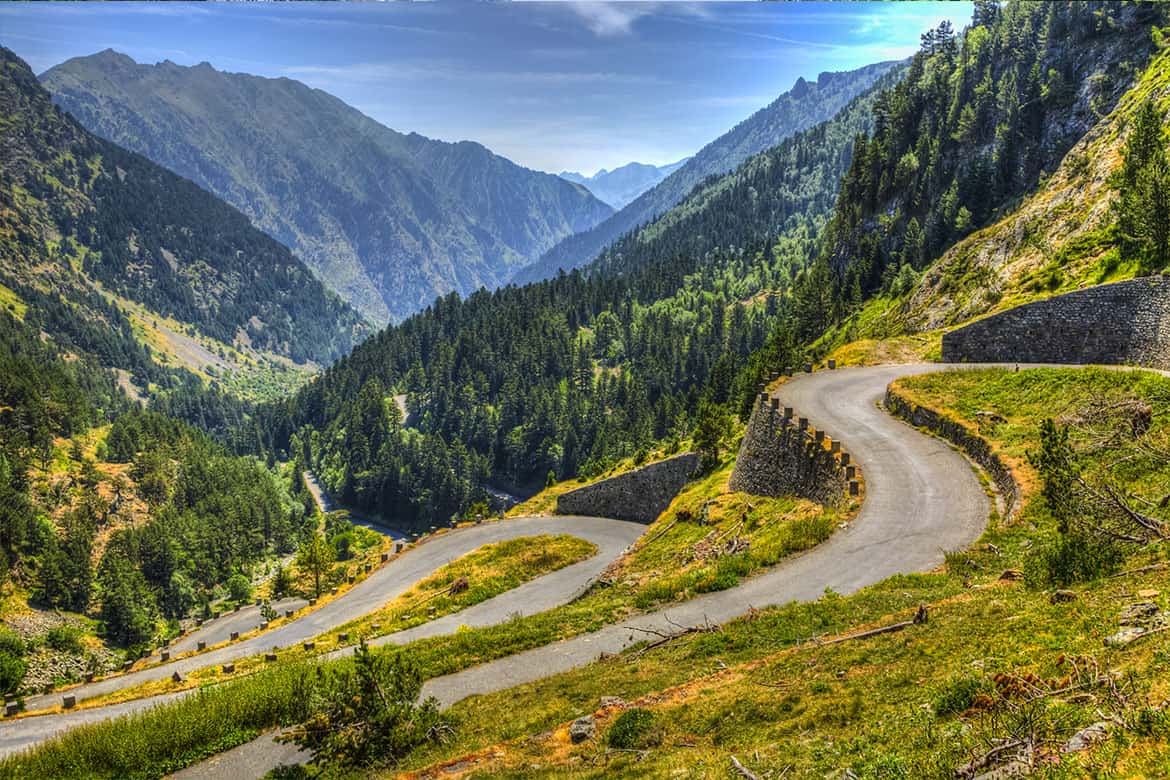
France route planner- best route to Italy (with maps)
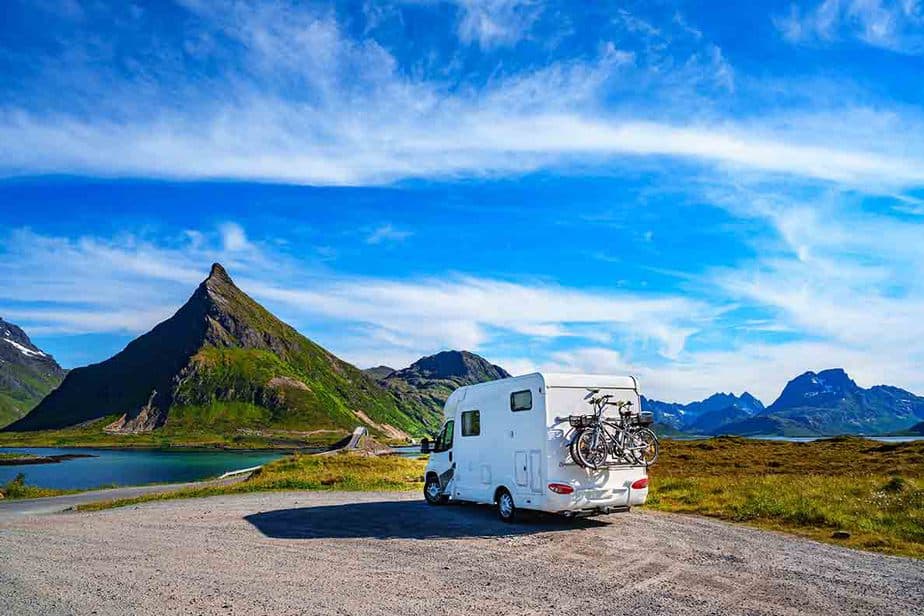
Motorhome rental UK & Europe- 10 essential things to check
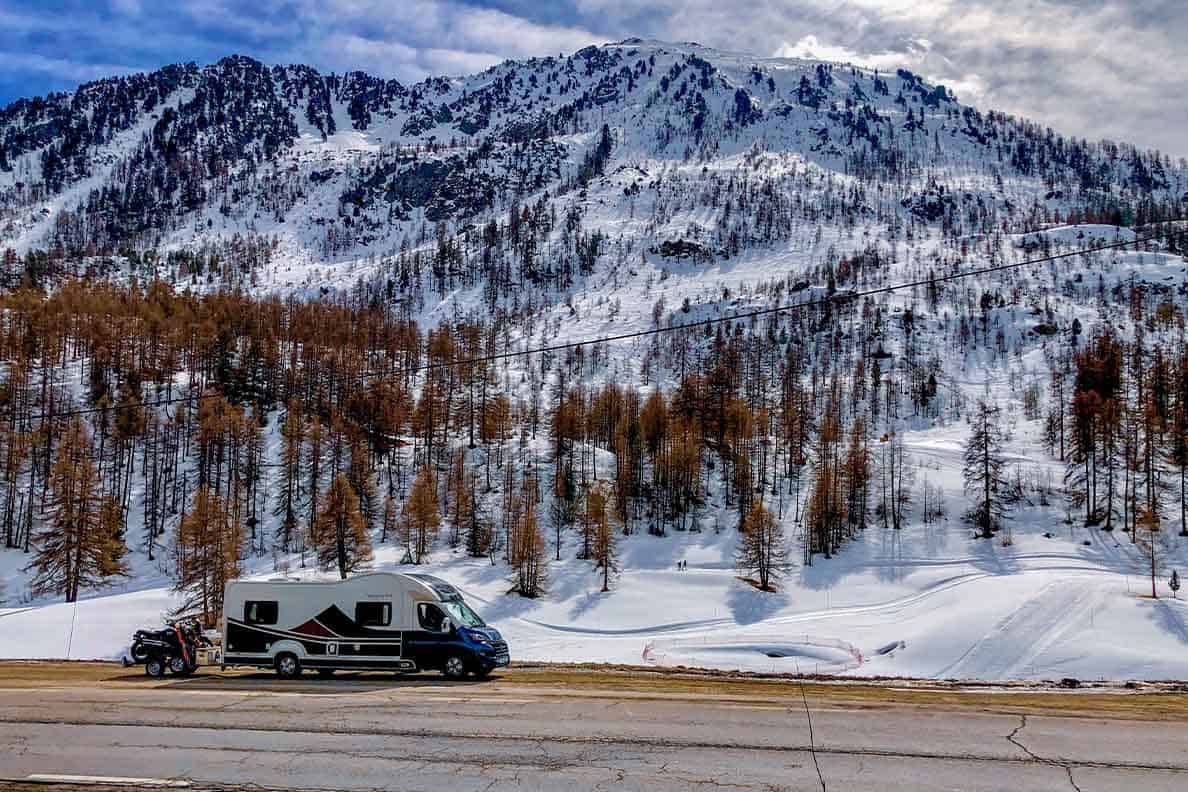
Motorhome Skiing & winterising your van- 10 ESSENTIAL tips you need to know
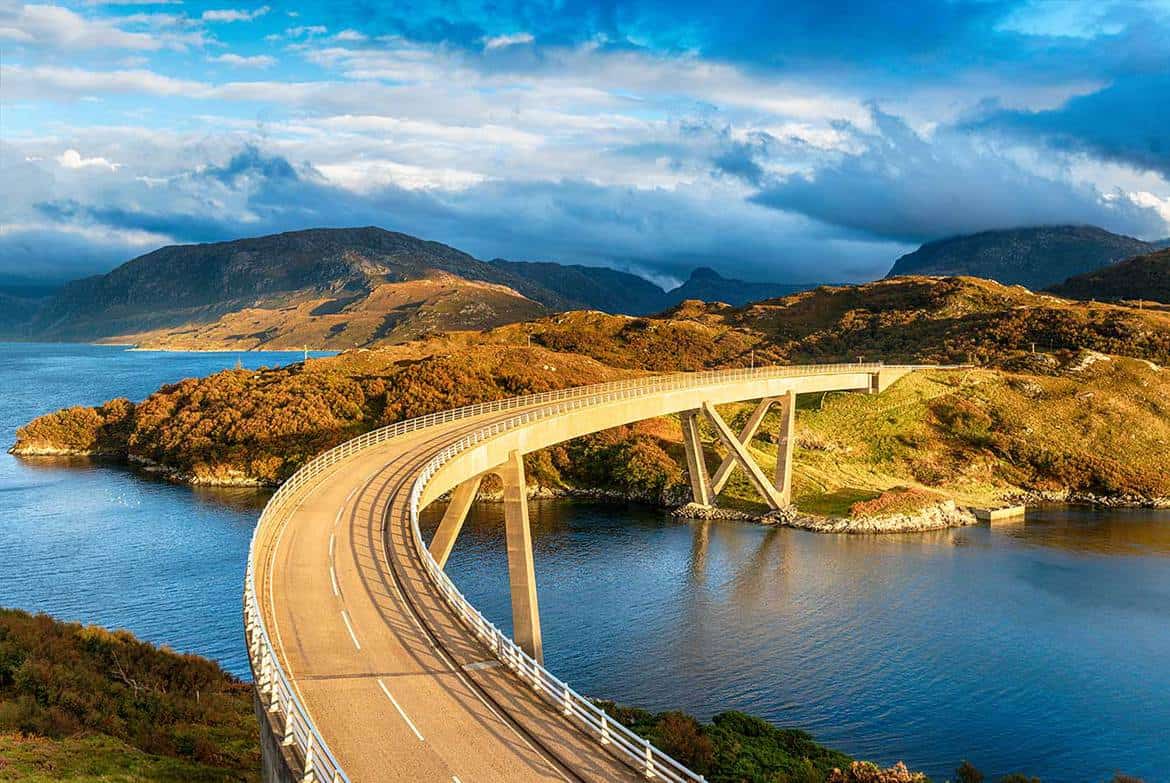
How to get an International Driving Permit (and do you even need one?!)
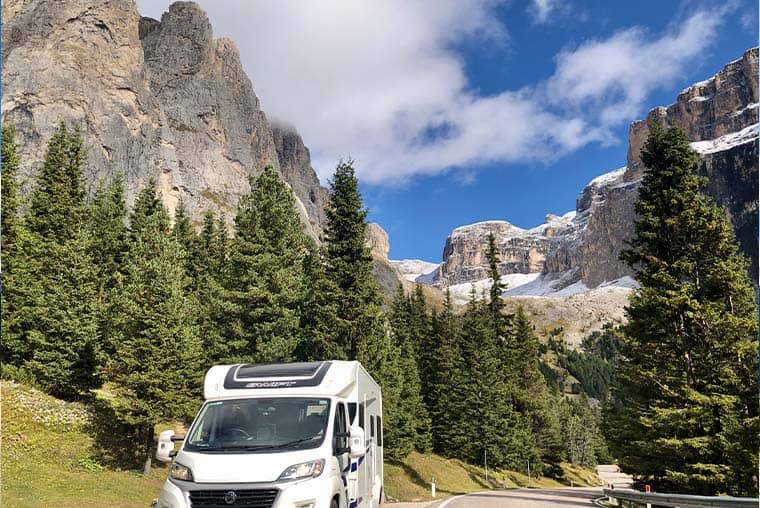
Dolomites with a Motorhome | Itinerary, Route & travel blog
Leave a reply cancel reply.
Your email address will not be published. Required fields are marked *
Save my name, email, and website in this browser for the next time I comment.

Motorhoming in Ireland – A Complete Guide
This post may contain affiliate links, from which we earn an income.
Motorhome & Campervan Travel in Ireland
Ireland is a fantastic non-Schengen option for motorhome travel. Easily accessible from the UK or Northern Ireland, this understated country packs a punch of lush rolling hills, dramatic coastlines, rich heritage and entertaining cities.
In this guide, you’ll find lots of practical and helpful information about getting around Ireland in a motorhome, and how to manage campervan and motorhome life there.
From tips about driving, where to stay overnight and wild camping, to motorhome services and a round-up of the best motorhome destinations, you’ll find all the information you need for an amazing road trip in Ireland.
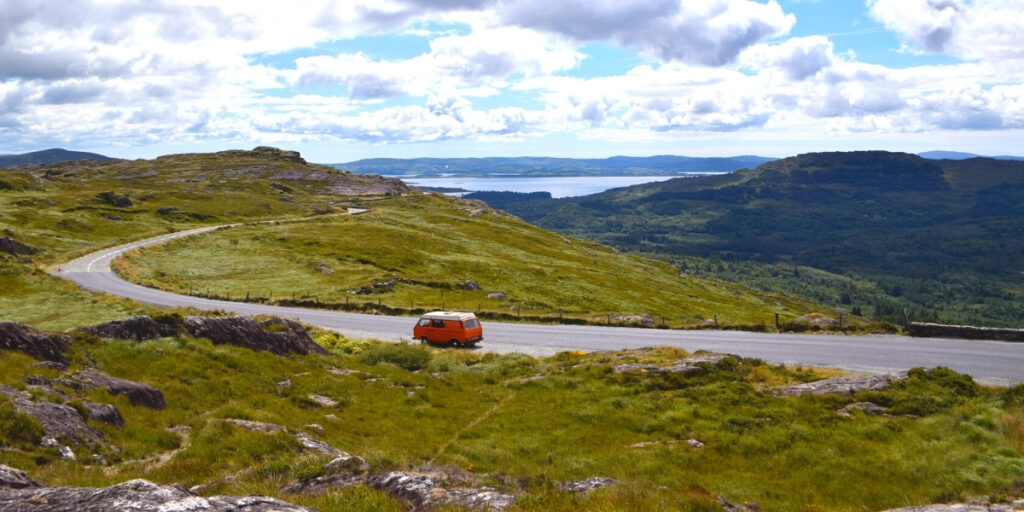
Motorhome Routes to Ireland
Crossing the irish sea, liverpool to dublin.
The only England to Ireland crossing is the Liverpool to Dublin option, where P&O offer four crossings per day. With both day and night crossings available and taking eight hours, you can choose to arrive refreshed and ready to start your motorhome tour.
Holyhead to Dublin
From the northern tip of Anglesey in Wales , the Holyhead to Dublin route is provided by both Irish Ferries and Stena Line, offering seven crossings a day between them.
This is a quick crossing of just three and a half hours, and a great option if you live in central England.
Pembroke & Fishguard to Rosslare
From Pembroke in the south of Wales, Irish Ferries sails to Rosslare twice a day. Stena Line also offers a twice daily service to Rosslare from Fishguard, a bit further up the Welsh coast.
From Pembroke the crossing takes five hours and from Fishguard, you’ll arrive in four hours and fifteen minutes.
These are the best options to get to Ireland if you live in southern England.
England to Northern Ireland
Stena Line operate the Liverpool Birkenhead to Belfast route twice a day. There are options of day and night crossings, both taking eight hours.
Scotland to Northern Ireland
The are two Scotland to Ireland crossings.
Cairnryan to Belfast, operated by Stena Lines, crosses six times and day and takes just two and a quarter hours on their ‘Superfast’ ships.
Cairnryan to Larne (north of Belfast), operated by P&O takes around two hours and also operates six times a day.
Crossings from Stranraer to Northern Ireland stopped in 2012 due to the need for a deep water port required for the larger more efficient ferries coming into service.
France to Ireland
Rosscoff to cork/ringaskiddy.
If you’re planning on touring into Europe from Ireland, or vice versa, Stena Line offer a twice a week fourteen hour overnight crossing between the two ports.
Cherbourg/Roscoff to Rosslare
Brittany and Stena offer four weekly overnight sailings between them on the Cherbourg route, both taking eighteen hours.
Stena also provide a once a week 16 hour overnight crossing on the Roscoff route.
Spain to Ireland
Bilbao to rosslare.
A mammoth 30 hour crossing, Brittany Ferries leaves both Bilbao and Rosslare twice a week. A good option for a longer European tour or for those living in Spain or southern France. Use
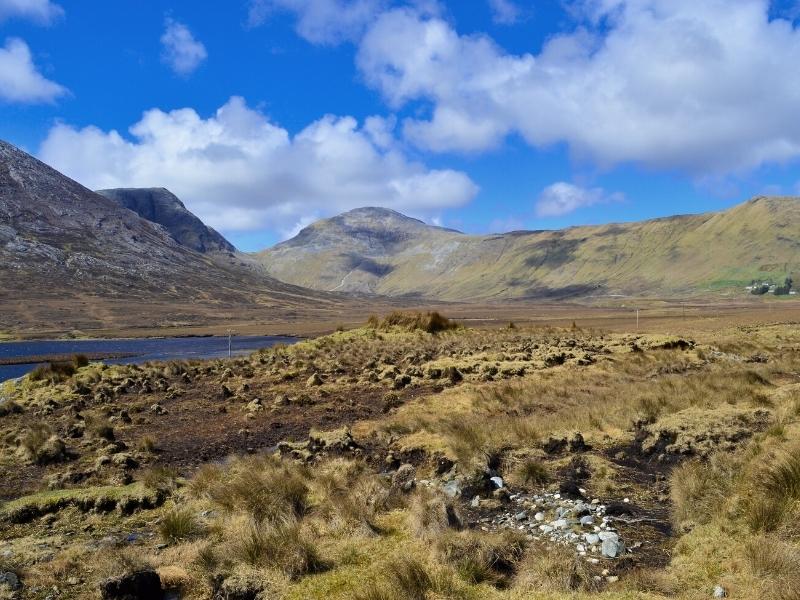
Crossing into Ireland from Northern Ireland
If you sail into Belfast, you can skirt around the Mourne Mountains and cross the border into the Republic of Ireland in just an hour. If you sail into Larne, north of Belfast, add another thirty minutes onto your journey south.
As a result of Brexit , Ireland and the United Kingdom formalised an agreement known as the Common Travel Area. CTA rights can only be exercised by citizens of Ireland and the UK.
Do I need a visa for Ireland?
There are no passport controls in operation for Irish and UK citizens travelling between Northern Ireland and the Republic of Ireland. You do not need to have a passport to enter the other country, and you don’t need a visa.
However, you must show identification to board a ferry and some sea carriers only accept a passport as valid identification, so check before you set off. You may also be asked by an immigration officer to prove that you are a citizen of Ireland or the UK, so its best to carry your passport with you.
How long can I stay in Ireland?
Ireland is not part of the Schengen area and so can be visited without your time in the country being counted towards the 90 in 180 day rule. People who are citizens of the United Kingdom (UK) are entitled to live in Ireland without any conditions or restrictions.
If you like things to be aligned, change your sat nav from miles per hour to kilometres per hour when you cross the border. There is no need to change the time though, Ireland observes GMT.
What food can I take in my motorhome to Ireland?
Food you take into Ireland in your motorhome is classed as a personal import. The rules regarding this are complex because of the CTA and depend on whether you’re entering Ireland from the Wales, Scotland, Northern Ireland or Europe. You can find out more from the Food Safety Aut h ority of Ireland website .
Can I use my mobile data in Ireland?
It very much depends on who your mobile phone contract is with and when you started the contract. All UK providers now limit data usage in the EU in some way or another, and it’s best to check with your provider to make sure you don’t run up a big bill. You can find lots of information in our guide to the best SIM cards in Europe , especially if you’re planning to be away for more than a few weeks.
We have been using and recommend ConnectPlus for cloud sim connectivity in the UK and Europe. You can choose from unlimited data packs to just single days, depending on your needs. The device is no larger than a slimline smart phone, connects with up to ten devices, is charged easily with a USB and can be delivered within a few days of ordering. Use the code ‘thegapdecaders’ at checkout to get 50% off in the first month!
Can I take a pet to Ireland in my motorhome?
This is also complicated because of the common travel area and your point of entry into Ireland. You can find out more here .
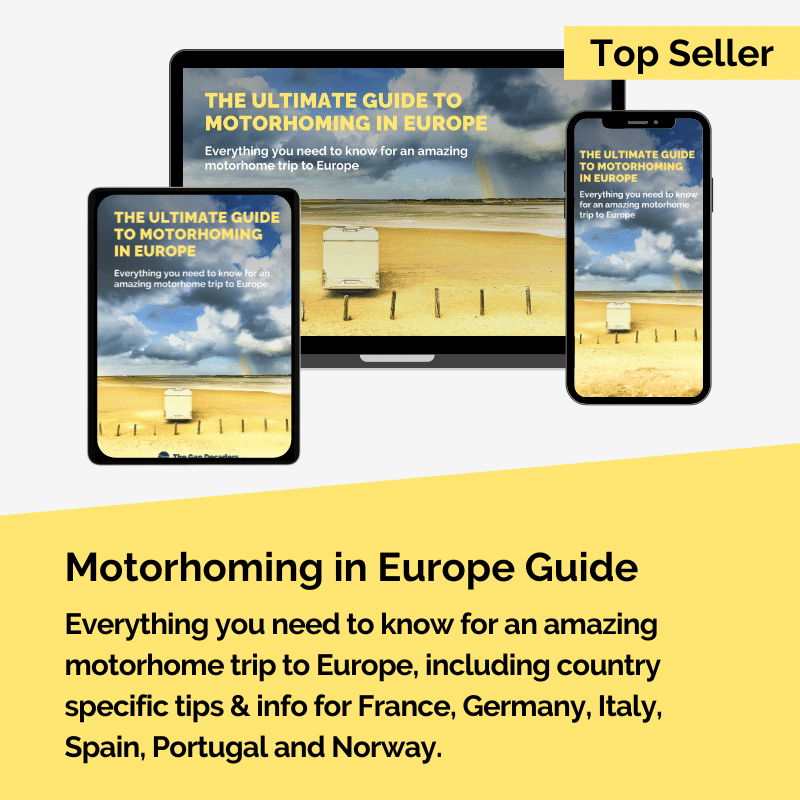
The Ultimate Guide to Motorhoming in Europe
If you’re planning a motorhome trip to Europe for the first time, our guide has tips, advice and info to help you plan your tour.
Don’t struggle trying to plan your European trip, find out everything you need to know before you go + loads of motorhoming tips for when you arrive.
The Differences Between Northern Ireland and Ireland Explained
Northern Ireland (or ‘Norn Iron’ as it is affectionately known by residents) is a part of the United Kingdom of Great Britain and Northern Ireland , also known as the UK . The other countries in this sovereign state are England, Scotland and Wales.
Great Britain is not a country but a landmass, which is home to the countries of England, Scotland and Wales.
The British Isles is the name of the group of islands which are made up of Great Britain, the entire island of Ireland, The Isle of Man, The Isles of Scilly, The Channel Islands (including Guernsey, Jersey, Sark and Alderney) and lots of other much smaller islands.
Ireland is a completely separate and independent country (and a member of the EU) officially described as the Republic of Ireland. There is no such country as Southern Ireland, although it is often incorrectly used to differentiate between Ireland and Northern Ireland.
Motorhome & Campervan Hire Ireland
Flying and hiring a motorhome or campervan is the great way to tour Ireland if you don’t own one.
Our recommended Ireland campervan hire company is Motorhome Republic , who have pickup locations at Cork, Dublin Airport, and Limerick, making round trips and one-way drop off really easy.
Expect to pay around €80-100 per night for a two berth van with a double bed. You need to be at least 21 years old to rent a campervan in Ireland.
If you plan to drive between Northern Ireland and the Republic of Ireland, there may be an additional fee to pay, usually around €20-30. Make sure to inform your campervan rental company that you plan to cross the border.
Useful motorhome advice and guides;
- Tips for Campervan Rental and Motorhome
- Europe Motorhome Touring Your Complete Guide
- 101+ Motorhome Essentials You Need + Packing Checklist
- New Motorhome Owner Beginners Tips
- 29 of the Best Van Apps – Free & Downloadable Now!
When to Visit Ireland in a Motorhome
Peak tourist season is June to early September and although it will be busier, you’ll get the benefit of the longer days and warmest weather, perfect for a campervan holiday.
The main areas affected by higher tourist traffic tend to be Dublin and Cork, and some stretches of the Wild Atlantic Way around Galway and Kerry. Don’t let this put you off travelling in summer though – when you’re travelling in a van its easy to get off the beaten path and away from the tourist hotspots.
Plan your Ireland motorhome trip from mid-April to May , and late September to October for quieter roads, good weather and all the craic that comes when the country starts to come alive for summer.
In the winter months between November and March , you won’t see many visitors, the weather may well be cold and and dreary and lots of tourist attractions will be closed. City sightseeings continues as always, but the atmosphere in pubs and bars may be lacking during the week.
Especially to brighten the dark months, the Irish hold some of their biggest and best festivals in winter. Think St Patricks Day on 17th March, the Galway food festival in April, the Cork Jazz Festival and Derry-Londonderry’s huge Halloween celebrations, both held in October every year.
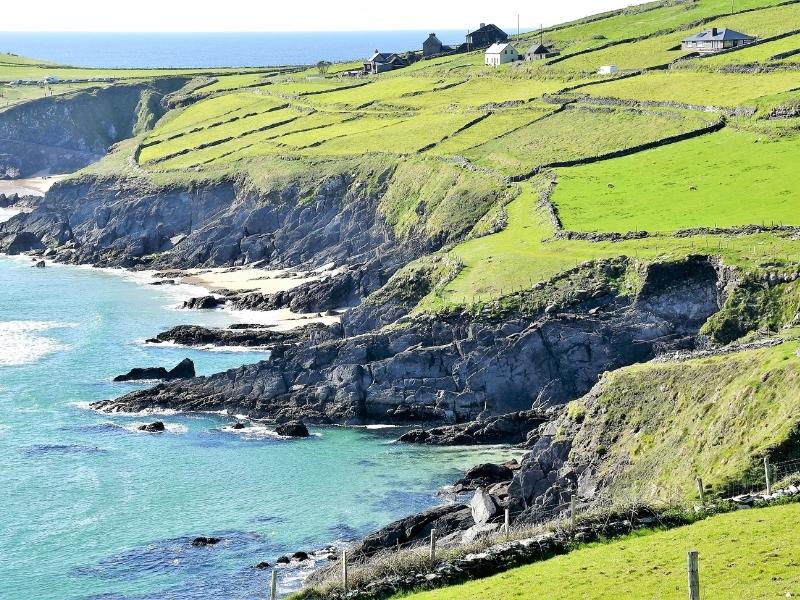
Driving a Motorhome in Ireland
Ireland has seen a huge investment of EU money in the road network over the last ten years. As regular travellers there (Phil is from Northern Ireland), we’ve seen a massive improvement in the motorways around Dublin, and the rural road system across Ireland.
Irish Speed Limits for Motorhomes
Always observe the speed limits when campervanning in Europe . There are speed cameras just as in the UK, and the Irish authorities have been known to pursue Brits for non-payment of fines. This has not changed since Brexit as the information sharing agreement with the DVLA continues.
Motorhomes < 3,500 kg
- Town and city – 50 km/h
- National roads and dual carriageways – 100 km/h
- Regional and non-national roads – 80 km/h
- Motorway speed limits – 120 km/h
- Special speed limits – 30 km/h or 60 km/h (as signed)
Motorhomes > 3,500 kg:
- National roads and dual carriageways – 80 km/h
- Motorway speed limits – 90 km/h
Documents You Need to Travel & Drive in Ireland
- Your passport must be valid for the whole of your stay in Ireland (UK citizens do not need a passport to visit Ireland but its best to carry one anyway).
- You must have at least 3rd party insurance for your vehicle. Update August 2021 – you no longer require a green card to prove you have vehicle insurance cover when travelling in Europe.
- Your UK licence allows you to drive in all EU countries. If you only have a paper driving licence or a licence issued in Gibraltar, Guernsey, Jersey or the Isle of Man then you will need an International Driving Permit .
- Breakdown cover documentation (not compulsory).
- Vehicle V5 logbook (which must show your correct address).
- Personal travel and medical insurance (we recommend True Traveller ), EHIC or GHIC card (not compulsory).
- Animal Health Certificate if you’re travelling with a pet to Ireland or Northern Ireland.
Vehicle Safety Equipment for Ireland
Unlike many other European countries, it is not compulsory to carry any vehicle equipment in Ireland, but this is what we think you need;
- Warning triangle.
- Reflective jacket.
- Spare wheel and the tools to change a wheel, or a tyre repair kit.
- First aid kit.
- Spare bulbs and fuses.
- Fire extinguisher.
- From 28th September 2021, you will have to display a UK sticker on the rear of of your vehicle, instead of a GB sticker, unless you have a new style UK numberplate which displays the Union Jack flag.
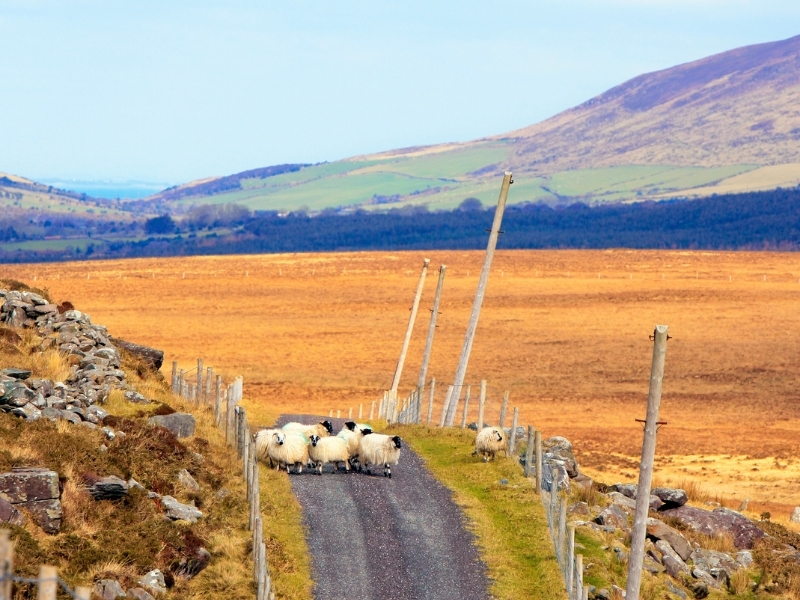
Driving a Motorhome in Ireland Tips
- Ireland is like the UK and drives on the left.
- In some rural areas, roads are too narrow for motorhomes to use them safely, although smaller camper vans may be ok. Often there are no passing places. Check your intended route and always abide by signage.
- When driving in the countryside, expect slow moving agricultural vehicles and animals like sheep and cows being herded along roads. Follow the Irish way and take it slowly – this is not a country in a hurry!
- The UK Department for Transport advises that A-frames are not legal for use by UK motorhomers abroad. In practice, this could mean towing your car while it’s fixed to a trailer, although there is ambiguity around this and differing advice can be found on the internet.
- Campervans or motorhomes and cars with caravans or trailers are not allowed to exceed 18.75m in total length, 4m in height and 2.55m in width.
- Loads must not exceed 10.5 tonnes at the driving axle and 10 tonnes at a single axle.
- You must not carry or use a radar detector and if caught you could be fined and the device confiscated by the Garda.
- There are no low emission zones in Ireland.
- Dublin is the only Irish city with an Urban Access Scheme in place, however it only applies to vehicles with more than five axles – if that’s you, find out more here . And kudos, that’s one big motorhome!
- The Garda can issue fixed penalty notices, in person or attached to your windscreen, which you will have to pay within 28 days or choose to go to court. Fines not paid within 28 days increase by 50%.
- The legal limit is 50 milligrams of alcohol per 100millilitres of blood, lower than the UK’s 80mgs. Random breath testing is in force throughout Ireland, with severe penalties including fines, imprisonment and disqualification for drink drivers.
- If you have an accident you’ll need to complete the EU Accident Statement , which you can find here to download if your insurer hasn’t provided one. Stop safely and use your hazard lights and warning triangle to alert other drivers. Exchange details and take lots of photos to add to your form when you submit it to the insurers. If the other party won’t give details or there has been an injury, you should call the Garda on 112.
Toll Roads in Ireland
There are eleven motorways in Ireland with tolls.
Some toll stations don’t take credit cards and the M50 is electronic, requiring you to pay online if you don’t have an electronic toll tag.
Make sure you’ve got some euroes in change or invest in an e-Toll electronic tag that attaches to your vehicle and pays all required tolls.
There are no toll roads in Northern Ireland.
Thanks to e-toll.ie for the Ireland toll roads map.
RELATED POST: Tolls for Heavy Motorhomes >3.5T in Europe: Country by Country Guide
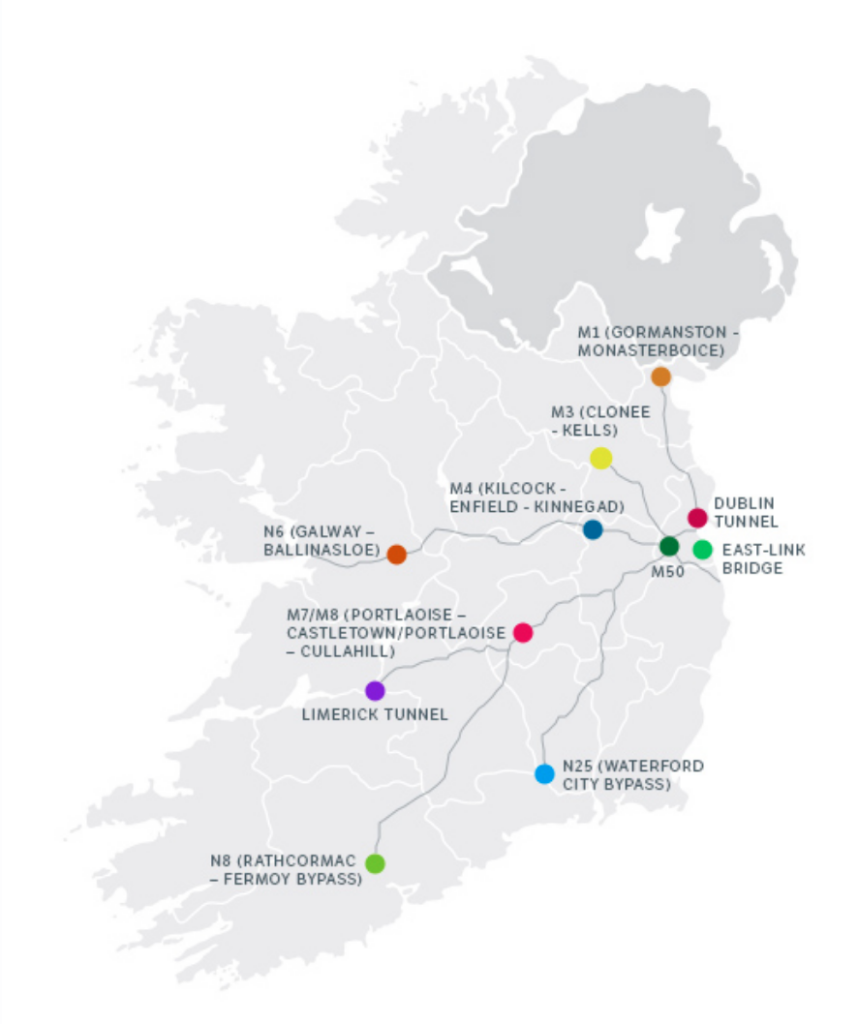
Parking in Ireland
As well as following any restrictions signposted locally, drivers in Ireland should also note that parking is prohibited in the following places;
- Within nine metres of a road junction.
- Within the same distance on the approach side of a pedestrian crossing or pedestrian lights.
- At a bus stop with road markings.
- On the pavement if this affects the movement of pedestrians.
- On cycle tracks.
- On yellow lines.
- When parking at night, vehicles may be parked without lights in situations where street lighting ensures they can be clearly seen by traffic.
Fuel in Ireland
Fuel prices in Ireland are similar to those in France – slightly less than the UK, but a lot more than Spain!
There are plenty of filling stations located across the country that sell petrol, diesel and LPG, although in rural areas in the west of the country there are fewer.
Recommended Reading
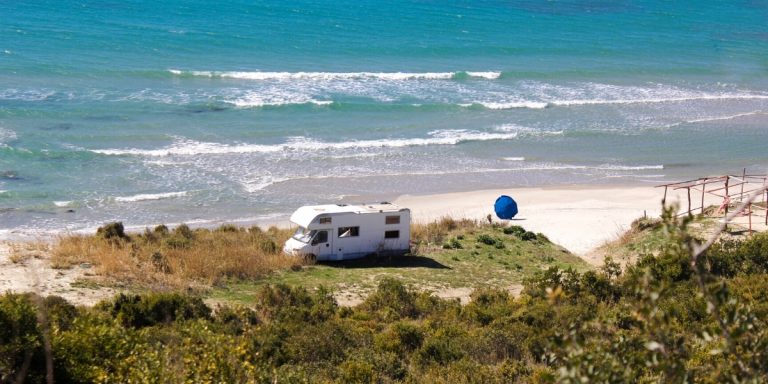
Motorhome Wild Camping – Your Complete Guide
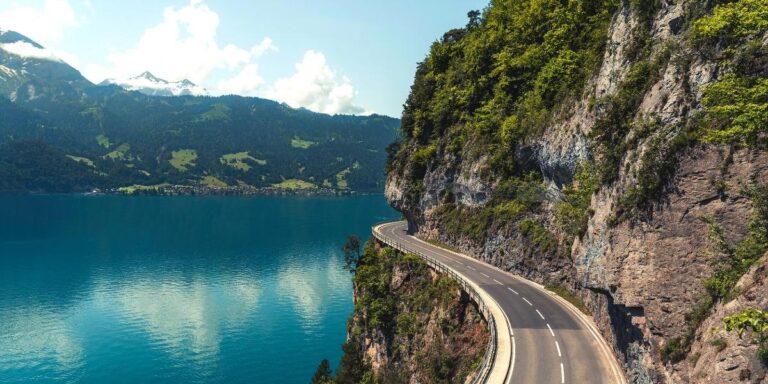
Europe Road Trip – 24 Incredible Routes
Motorhome service points in ireland.
There are very few motorhome service areas in Ireland. Use an app like Park4Night to identify aires with services, or stay in a campsite every few nights.
Many campsites will also let you fill up with fresh water, dispose of grey waste and empty your toilet cassette if you pay a small fee.
LPG & Bottled Gas
There are around 50 garages in Ireland where you can fill LPG from the pump. Use the myLPG app to identify one close to you, and check on the prices.
If you have a refillable system like Gaslow or Gasit, the ACME adaptor used for Germany, Belgium and Austria is the one you need for Ireland.
Calor Gas is Ireland’s leading supplier of bottled propane and butane gas. Irish gas bottles are not interchangeable with UK bottles, but you may find some suppliers selling both Irish and UK bottles, especially close to the border.
You’ll also need a different regulator. If you carry a selection around, you’ll find a Spanish one does the job!
Motorhome Stops in Ireland
Aires in ireland.
If you’re used to motorhoming in France , Spain or Germany , motorhome aires de camping are a common part of life.
In Ireland, there are only a handful of what you might recognise as motorhome aires, but they don’t really work in the same way as they do on the continent.
Sometimes they’re free, other times you need to pay your euros to the butchers shop round the corner, or the pub along the High Street.
A few of these have purpose-built motorhome services, but many are a bit ad hoc. Expect to pay around €5-10 per night.
Wild Camping in Ireland for Motorhomes
Is it legal to wild camp in in Ireland? Wild camping is not legal in Ireland, in the same way it isn’t in the UK. However, with a population of just 6.6 million (a tenth of the UK population) living on a land mass a third of the size of the whole of the UK, the Emerald Isle is very sparsely populated.
This means there are lots and lots of wide open spaces where you can find camping spots and wild camp discreetly without bothering anyone. In our experience, the people of Ireland really don’t mind motorhomes and campervans wild camping.
If you do see a sign or local by-law forbidding it, then move on. Likewise, if there is an obvious landowner whose permission you need to ask, then do so.
As always, follow our motorhome wild camping top tips and rules to stay safe and leave no trace wherever you stay.

Safe Nights Ireland Motorhome Parking
Safe Nights Ireland is an initiative which provides access to overnight motorhome parking across the country, at over 350 locations.
The locations are not campsites, but safe off the road places where you can stay. From country houses, open farms and national parks to pub locations, you’ll get a warm welcome and a safe haven for the night. Some provide services, but make sure to plan ahead where they don’t.
It costs €15 to join the club, and get access to their online database of campervan stopovers. If you hire a campervan with Bunk Camping , they even throw club membership in for free!
Total Motorhome Ireland
Total Motorhome Ireland is a great resource to find pub overnight stopovers, campsites and services in Ireland, which is free to use.
Motorhome Parking Ireland
A paid for app especially for Ireland, Motorhome Parking Ireland is where you can find pubs, restaurants, farms, free campervan parking and many other places where you’re welcome to spend the night in a van.
Motorhome Campsites in Ireland
Campsites in Ireland for motorhomes tend to be small and intimate. Many take CampingCard ACSI , meaning you can save over 60% at campsites out of season, a must for motorhoming in Ireland.
Members of UK motorhome clubs can also book sites across the island of Ireland. Those living in Ireland and Northern Ireland may be able to join the Irish Motorhome Club and book sites with them.
Campsite facilities are usually good, often with 13 amps of electric and good wifi across the site. Expect camping spots in Ireland to be very similar to those in the UK.
Life in Ireland
The pace of life is slower in this beautiful country. Visit the cities though, and expect things to be a bit more lively – Ireland is becoming a cosmopolitan country to be reckoned with.
Lots of people ask us about safety, especially in Northern Ireland. After years of visiting with Phil (I’m a Brit), I can honestly say I have never felt unsafe.
There are certain things that maybe highlight the recent history of both countries, such as flags being flown, police stations behind high fencing, paving painted in either nationalist or republican colours, and of course the distinctive and famous murals on buildings in Belfast and Derry-Londonderry.
Many of the latter can be visited as part of a tour of those cities, and if you get the opportunity, you should definitely do that.
For me, the hospitality I have always been shown, the friendliness of the people and yes, the craic, make the island of Ireland one of my favourite places in the whole world.
If you get a chance when you’re camping somewhere rural, head to the nearest pub, where the local community will show you a good time. With impromptu Irish music, a pint of Guinness and maybe a traditional dinner of bacon and colcannon (mash with cabbage), you’ll feel right at home in no time!
Top Irish Motorhome Destinations
The capital of Ireland, Dublin is a city with a huge reputation which has managed to retain the quaint and lively charm that you will find throughout the country.
Dublin has a complex history full of Vikings, famines and wars, and much of the city still has an historic feel, with streets of cobblestone, castles and ancient churches.
Don’t miss the more modern attractions of the Guinness Storehouse and Temple Bar, which really comes alive at night. Even if you only have a short time in Dublin , it is absolutely worth visiting.
Stay at Camac Valley Camping and Caravanning Park . There is a bus stop at the main entrance, from there it’s a ten minute ride to the nearest tram into the city.
RELATED POST – One Day in Dublin – Itinerary, Map, Tips & Guide
The Wild Atlantic Way
From County Donegal to County Cork, and passing through counties Leitrim, Sligo, Mayo, Galway, Clare, Limerick and Kerry, the Wild Atlantic Way winds down the intricate west coast of Ireland and the edge of Europe.
This epic Ireland road trip takes in many of Ireland’s must sees and dos .
Be in awe of dramatic Malin Head on Donegal’s Inishowen Peninsula, and the contrasting sand dunes which you can see as you approach from the coastal road around Lag.
Visit Dunmore Head, Ireland’s most westerly point on the Dingle Peninsula, where the waves crash and the clouds race. Whilst you’re there, check out Slea Head , the drive to which is spectacular.
Marvel at the UNESCO Killarney National Park and then explore the spectacular Ring of Kerry route before hopping over to Skelling Michael, which along with Little Skelling and Lemon Rock (a Harry Potter filming location), make up the Skellings.
The mighty Cliffs of Moher have to be visited. One of Ireland’s most famous sights, the cliffs tower over the County Clare coast and have been inspiring creatives and geologists alike for centuries.
The Beara Peninsula in Munster is a great place for hiking, with incredible views of the surroundings rugged landscapes and wild seas for the two mountains ranges which run down the peninsula’s spine.
This motorhome trip on the west coast of Ireland is best done with time on your side. Two weeks will give you a flavour, three weeks is just about enough, but four weeks or longer will give you time to explore and really get to know the country.
You’ll find loads of wild camping opportunities on the route, as well as cliff-top campsites and stunning off the beaten path beach-side locations where you can stay and enjoy the view.
RELATED POST – Wild Atlantic Way: Itinerary, Map & Tips
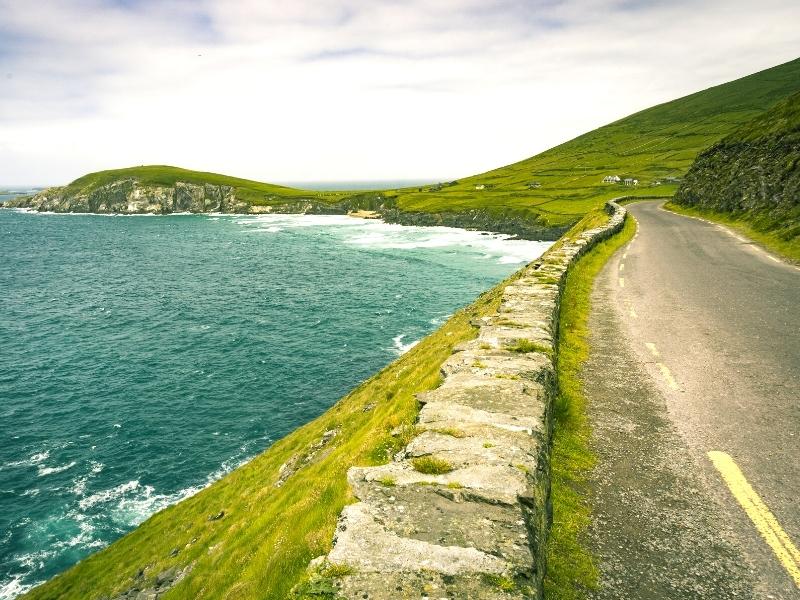
Ireland’s Ancient East
An attempt at repeating the success of camper van routes along the Wild Atlantic Way and the North Coast 500 in Scotland, Ireland’s Ancient East is a touring region rather than a road trip route, framed by the river Shannon to the west and Irish Sea to the east.
The Ancient East showcases 5,000 years of Irish history and national heritage across the soft green landscape of Wexford, Kilkenny, Wickford, Tipperary, Waterford and twelve other counties.
Where the Wild Atlantic Way is about raw nature and pounding seas, the Ancient East is where the myths and legends of the Emerald Isle come to life.
Revel in Kilkenny’s Medieval Mile Walk and follow the footsteps of the Vikings through the narrow streets and medieval treasures of Waterford, one of Ireland’s best cities to visit.
Visit Blarney Castle and kiss the Blarney Stone (maybe wear a mask?) and take a moment on top of the mystical Hill of Tara in Meath, dwelling place of the gods. Marvel at the Rock of Cashel in Tipperary, one of Ireland’s most spectacular, and visited, attractions.
You’ll find plenty of places to stay in the eastern counties of Ireland, including some cracking pub stops, free motorhome parking spots and great campsites.
RELATED POST – Beautiful Ireland: 22 Most Scenic Places To Visit
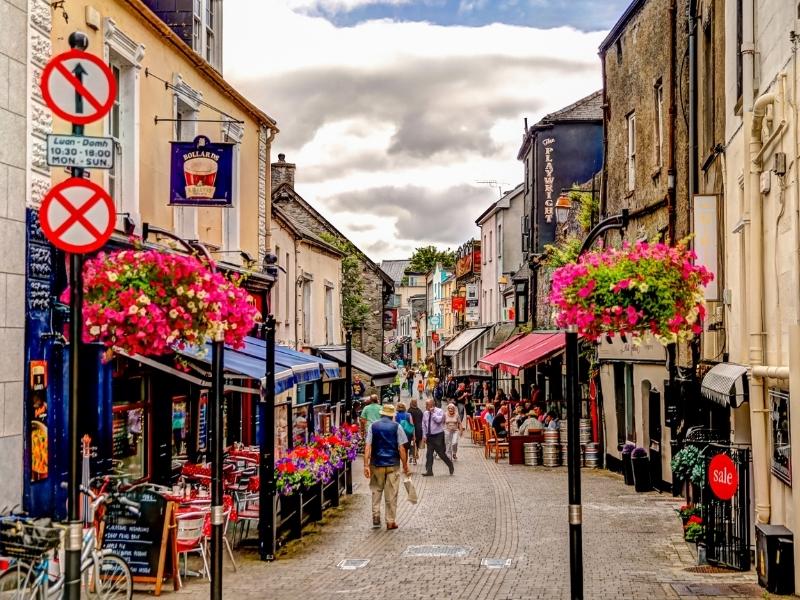
Top Northern Ireland Motorhome Destinations
Causeway coastal route.
The wild and unspoiled Antrim Coast in Northern Ireland is made for a motorhome road trip . Peppered with fascinating places to see and exciting things to do, this route will appeal to outdoor adventurers.
If you are a Game of Thrones fan, there are lots of places along this route which featured in the show, including the Dark Hedges and the tiny harbour at Ballintoy (but don’t attempt either of them in a motorhome!).
Other attractions include the Carrick-a-Rede rope bridge, Bushmill’s Distillery and of course, the magnificent Giant’s Causeway, Northern Ireland’s first UNESCO site.
The walled city of Derry-Londonderry, one of the finest examples of a walled city in Europe and the only remaining completely walled city in Ireland, starts, or ends, the Causeway Coastal Route. The walls, which are around 1.5km in circumference, form a walkway around the inner city and provide a unique promenade to view the layout of the original town.
Belfast is the bookend to the south, over the beautiful and desolate Sperrin Mountains. Don’t miss the fantastic Titanic Quarter, historic Crumlin Road Gaol and the buzzing nightlife of the Cathedral Quarter.
All along this route you’ll find lots of campsites, motorhome overnight parking and pub motorhome stopovers, all sharing the typical warm Irish hospitality the island is known for.
RELATED POST – Causeway Coastal Route: The Best Road Trip In Ireland?
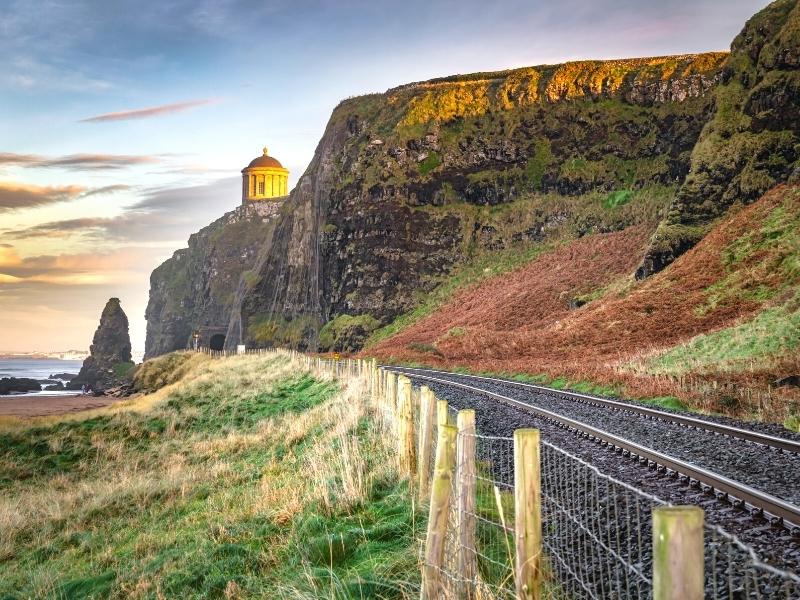
Resources for Motorhome Travel in Ireland
- Best for motorhome rental and campervan hire in UK >> Spaceship Rentals
- Best for Ireland campervan and motorhome hire >> Bunk Campers
- Best for campsites & camping in Ireland >> ACSI Eurocampings
- Best motorhome route planner Ireland >> Mappy
- Best for ferries from UK and Ireland >> Direct Ferries
- Best for travel insurance >> True Traveller
Are you looking for more motorhome touring guides? Check out these top posts…
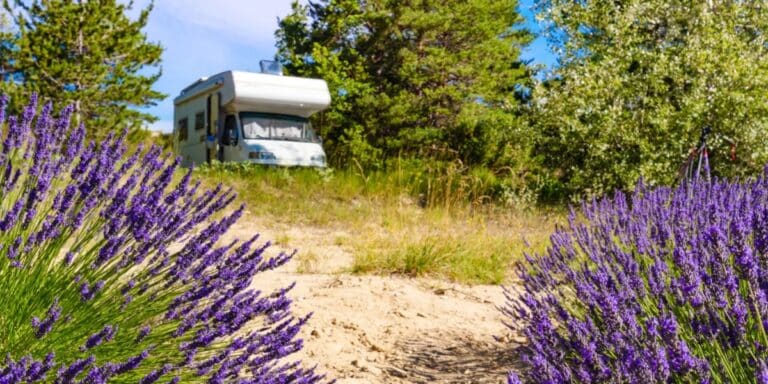
Motorhoming in France: Your Complete Touring Guide for 2024
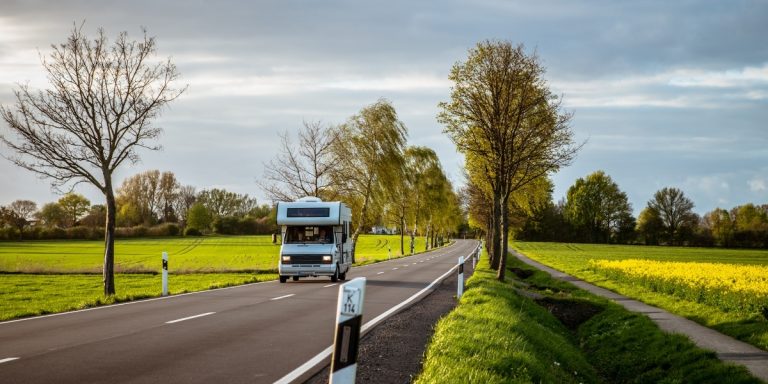
Motorhoming in Germany: Your Complete Touring Guide for 2024
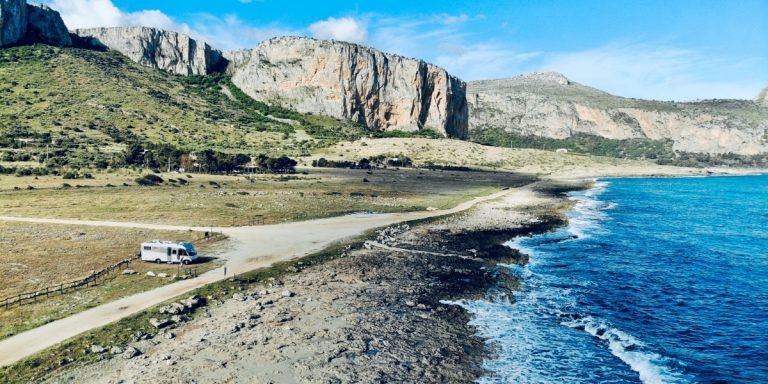
Motorhoming in Italy: Your Complete 2024 Guide
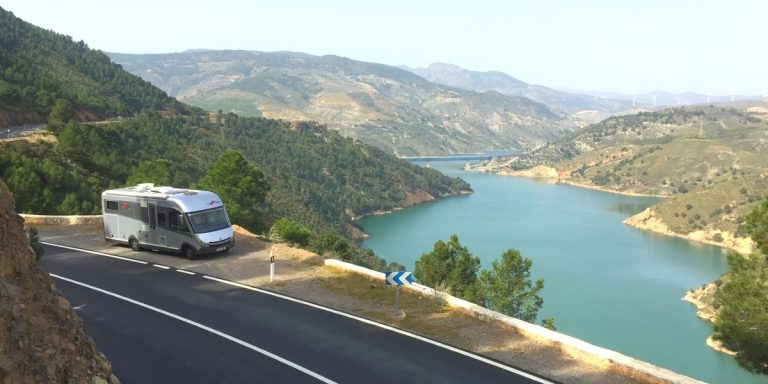
Motorhoming in Spain: Your Complete Guide for 2024
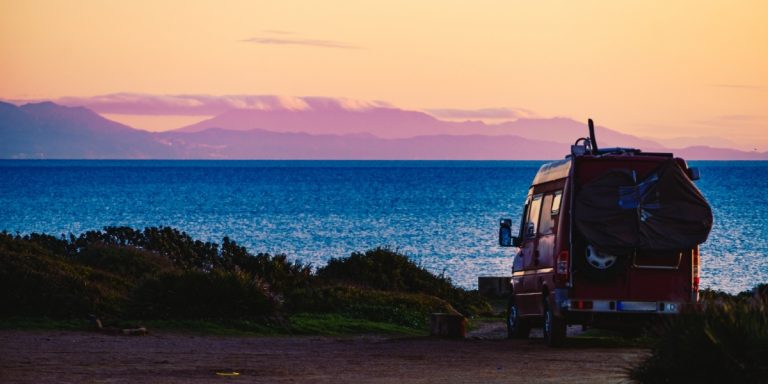
Campervanning in Portugal: Complete Guide for 2024
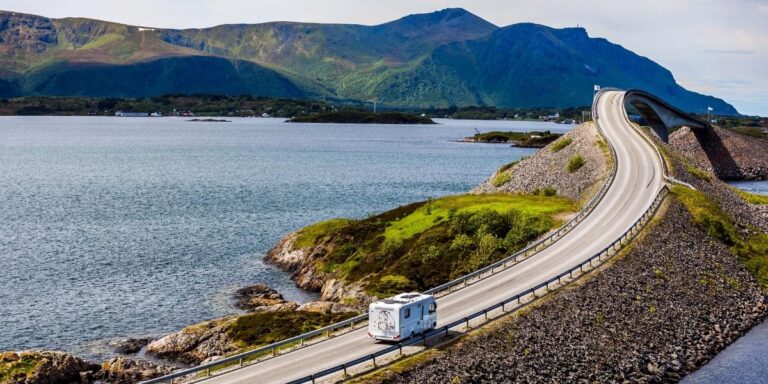
Campervanning in Norway: Tips, Routes & Destinations for 2024
Love it pin it.
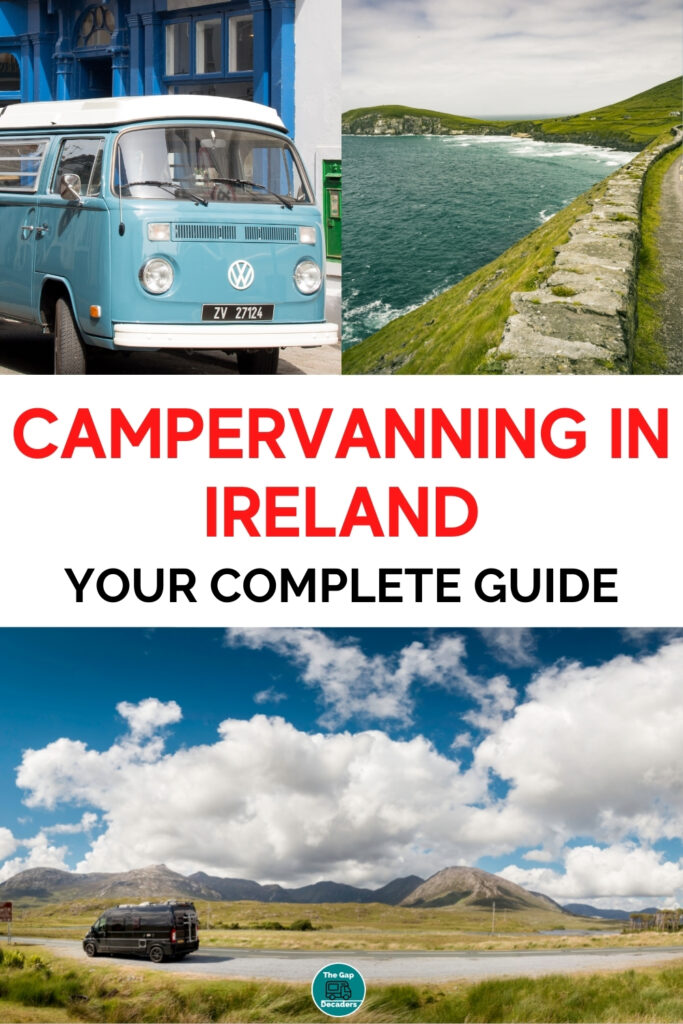

- Republic of Ireland
- Northern Ireland
- The Titanic
- Wild Atlantic Way
- Abbeys and monasteries
- Distilleries
- Irish national parks
- Lighthouses
- Dark Tourism
- Ireland Car Tours
- Game of Thrones in Ireland
- Haunted castles in Ireland
- Long weekends in Ireland
- Themed tours in Ireland
- Urbex in Ireland
- Irish history
- Languages in Ireland
- Irish personalities
- Irish Sports
- Film and television on Ireland
- Irish clothing
- Irish folklore
- Irish literature
- Irish music
- Christmas in Ireland
- Easter in Ireland
- Halloween in Ireland
- Saint Patrick’s Day
- The Irish Pub
- Irish beers
- Irish whiskeys
- Irish ciders
- Irish cocktails
- Irish breakfast
- Local Irish products
- What to do in Ireland
- Irish entry documents
- The Irish climate
- Everyday Ireland
- Bed & Breakfast
- Guesthouses
- Irish castles to stay in
- Youth hostels
- Book your accommodation!
- Book your flight!
- Book your car
- Contact us!
The best routes for motorhome travel in Ireland.
Don't miss out on any of ireland's wonders, and take the most beautiful tours of the isle of erin in your motorhome or van.

Take on the West Irish coastline!
Highlights of the ring of kerry, explore a coastline full of character.
- Highlights of the Giant's Causeway coastline
- Explore Ireland's Atlantic coastline!
Highlights of the Wild Atlantic Way
- Immerse yourself in Ireland's greatest historical sites!
Highlights of the Historic East
If you dream of adventure, breathtaking scenery and Celtic culture, a motorhome trip to Ireland could be the ultimate once-in-a-lifetime experience. Picturesque roads, mysterious castles and local villages make this country a prime destination for motorhome enthusiasts. But choose your itinerary carefully: there are some real treasures to explore on the Emerald Isle. You don’t want to miss out!
What’s more, the roads can be quite narrow, depending on where you are. Here’s an overview of the best itineraries for a memorable motorhome trip in Ireland, without having to worry about the size of your vehicle!
Itinerary 1: The coastal route of the Ring of Kerry
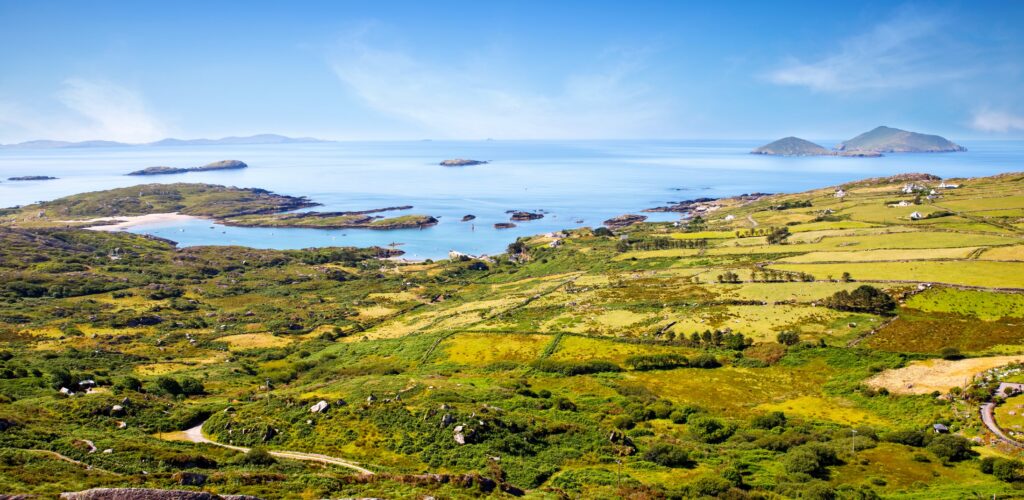
View of the Ring of Kerry – © Irina Schmidt
In Ireland, there’s a world-famous tourist circuit, where green hills, steep cliffs, dry-stone walls and fascinating castles steeped in history unfold before your eyes.
This is the Ring of Kerry, a 180 km loop offering breathtaking panoramas along Ireland’s south-west coast.
Leaving Killarney , this winding road takes you through coastal landscapes, green mountains and picturesque villages.
This is a particularly interesting itinerary for motorhomes, as you’ll be able to make many stops and enjoy the views in comfort.
Our tip: don’t hesitate to take the Ring of Kerry circuit in an anti-clockwise direction, passing through Killarney and then Killorglin . This will allow you to travel in the same direction as most tourist buses. This will save you maneuvering if you encounter an oncoming vehicle… And generally speaking, the route is easier to take in this direction if you’re travelling in a camper van or van.
There are countless remarkable sites on the Ring of Kerry. Nevertheless, here are the most notable :
- Killarney : Your journey begins in Killarney , a charming town at the foot of the mountains. Before venturing out on the road, explore Killarney National Park and admire its shimmering lakes, majestic waterfalls and diverse wildlife.
- Ladies View : A few kilometers from Killarney , stop off at the Ladies View , a panoramic viewpoint offering stunning views of the Lakes of Killarney and surrounding mountains. It is said to have been one of Queen Victoria’s favorite sights.
- Killorglin : Located near the confluence of three rivers, Killorglin is a picturesque town famous for its Puck Fair festival, a lively celebration that dates back centuries. Don’t hesitate to spend a little time here and linger in the pub. The place is authentic.
- The Gap of Dunloe : This spectacular glacial valley is an ideal place for a hike or bike ride. You can also take a horse-drawn carriage tour for a unique experience.
- Valentia Island : Accessible by bridge, Valentia Island offers breathtaking sea views and is also home to the island’s Discovery Center, where you can learn more about local geology and history.
- Portmagee : This is the starting point for excursions to Skellig Michael Island, a UNESCO World Heritage Site. Monastic ruins, bird colonies and dramatic cliffs make this a memorable experience.
- Skellig Ring : Although less frequented than the Ring of Kerry, the Skellig Ring is an impressive extension to explore. Here you’ll discover the spectacular views of the Skellig Islands , which have been used as a film location for the Star Wars movies.
- Waterville : Known as a favorite retreat of Charlie Chaplin, Waterville offers peaceful beaches and a relaxed atmosphere. Enjoy fresh seafood in one of the local restaurants.
- Kenmare : Continuing on your way, you’ll reach Kenmare , a colorful little town renowned for its friendly atmosphere and craft stores. It’s also an ideal base for exploring the Beara Peninsula, a less-frequented alternative to the Ring of Kerry.
Route 2: The Giant’s Causeway Coast

Giant’s Causeway – S-F / Shutterstock.com
If you’re looking for an adventure that combines fascinating geology, ancient legends and breathtaking coastal scenery, Northern Ireland’s Giant’s Causeway Coast is the ideal route to explore by motorhome. This region offers a unique blend of history, geology and natural beauty, making it a must-see destination.
As you travel along this spectacular coastline, you’ll marvel at the unique rock formations that give the impression of having been carved by giants.
Explore the village of Bushmills , its eponymous distillery and Dunluce Castle . Their view is spectacular!
Finally, push your motorhome to the vertiginous Carrick-a-Rede rope bridge, then head for Belfast for an urban twist on your adventure!
Our advice: drive to your heart’s content. Take the time to admire it all, and don’t hesitate to park your motorhome in front of some of Northern Ireland’s finest views!
Highlights of the Giant’s Causeway coastline
- Giant’s Causeway : a UNESCO World Heritage Site, this geological plateau is unlike any other in the world. These astonishing rock formations are made up of 40,000 basalt columns plunging into the ocean. Together, they create a landscape that seems straight out of a fairy tale.
- Carrick-a-Rede Rope Bridge: Nearby, don’t miss the opportunity to cross the famous Carrick-a-Rede Rope Bridge. Suspended over the ocean, this bridge offers breathtaking views of the steep cliffs and turquoise waters below.
- Dunluce Castle : Perched on a rocky promontory, Dunluce Castle is a picturesque ruin that seems to emerge directly from the cliffs. This medieval structure is an architectural gem and a must-see for history buffs.
- Ballintoy: This charming bay offers spectacular coastal scenery and is an ideal base for exploring the surrounding area. The panoramic views from the White Park Bay hill are breathtaking.
- Dark Hedges : Although located slightly inland, the tree-lined path known as Dark Hedges gained popularity thanks to its appearance in the TV series Game of Thrones. It’s a must for fans of the series and lovers of photography.
Route 3: The Wild Atlantic Way
Explore ireland’s atlantic coastline.
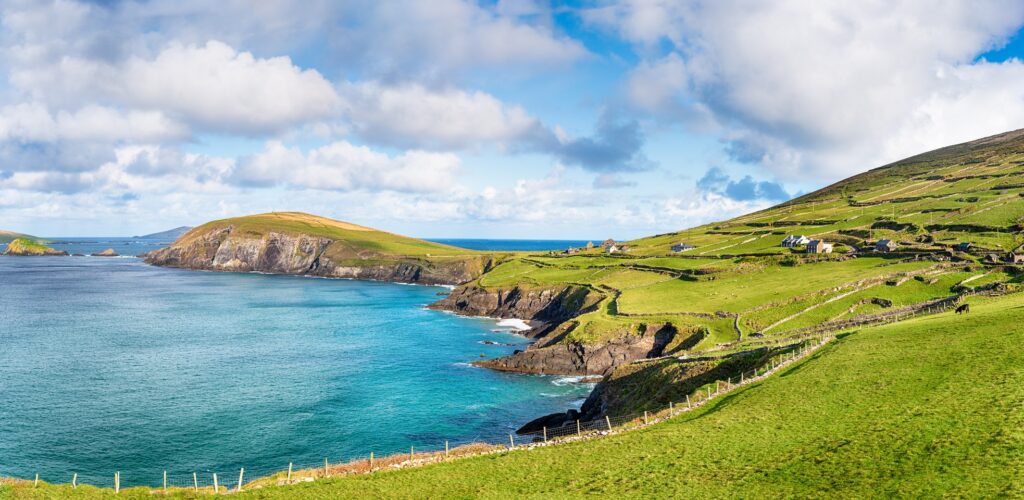
Slea Head Drive – © Helen Hotson
The Wild Atlantic Way is a 2,500 km route along the west coast of Ireland, offering total immersion in the country’s unspoilt wilderness.
Starting from the Inishowen Peninsula in County Donegal , this route takes you past isolated peninsulas, deserted beaches and impressive cliffs.
The Wild Atlantic Way is very pleasant to drive along in a motorhome. Firstly, because it has an incredible number of campsites where you can park for the evening. Many of them are located in the heart of nature, in an exceptional wilderness setting.
- Inishowen Peninsula: Start your journey in County Donegal by exploring the Inishowen Peninsula. Here you’ll find dramatic cliffs, secluded beaches and picturesque villages. Don’t miss the spectacular view from Malin Head , Ireland’s most northerly point.
- County Sligo : Continuing south, discover County Sligo , known for its varied landscapes, including Mount Benbulben, which dominates the landscape with its distinctive profile.
- County Mayo: Explore the raw beauty of County Mayo, with deserted beaches, impressive fjords and the mysterious Isle of Clare.
- County Galway: Galway welcomes you with its lively atmosphere and narrow streets lined with traditional pubs. Visit the Aran Islands for an authentic experience of rural Irish life.
- Dingle Peninsula: The Dingle Peninsula is a jewel in the crown of County Kerry, with its mountainous landscapes, golden beaches and colorful villages. Take a break to admire the dolphins playing in Dingle Bay .
- County Clare: The spectacular landscape of the Cliffs of Moher is a must-see, offering breathtaking views of the Atlantic Ocean. Also visit the Burren , a unique region characterized by its rocky landscape and exceptional flora.
- County Kerry: You’ve already explored the Ring of Kerry, but the section of the Wild Atlantic Way that crosses County Kerry offers impressive new views of the coast.
- County Cork : Explore the remote peninsulas of County Cork , including the Beara Peninsula and Sheep’s Head Peninsula. Enjoy the magnificent views and discover the local culture.
Route 4: Historic East
Immerse yourself in ireland’s greatest historical sites.
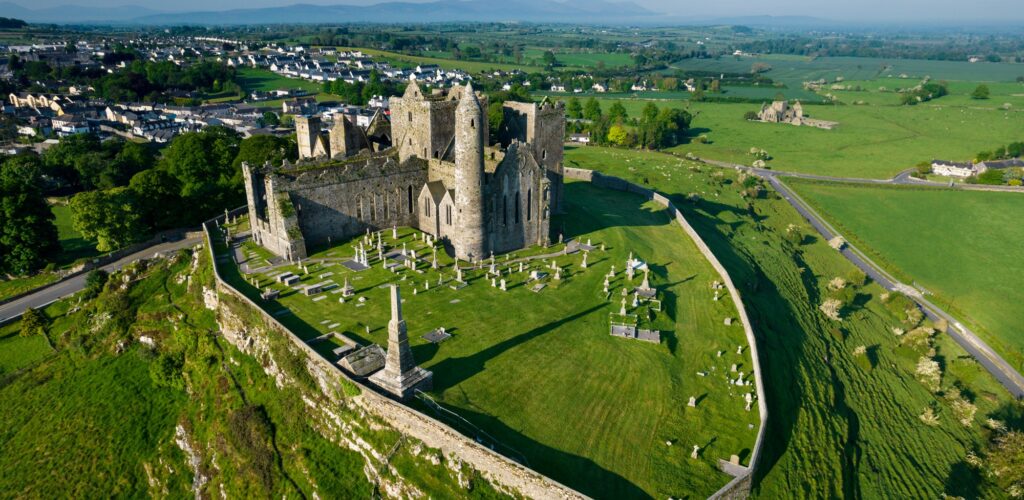
The Rock of Cashel – © bacothelock
If you want to explore Ireland’s history and culture, the Historic East route is for you. Set off from Dublin and visit historic sites such as Trim Castle , the monasteries of Glendalough and the Hill of Tara . As you travel through the Boyne Valley, you’ll be immersed in Ireland’s rich history, from prehistoric times to medieval battles.
This tour is perfect for motorhomes, as it’s often less well known to travellers. This is a mistake: this part of Ireland is magnificent and home to some exceptional sites, such as Newgrange !
- Dublin (County Dublin) : Start your journey in Ireland’s bustling capital. Explore Trinity College to admire the Book of Kells and visit the National Museum of Ireland for an immersion in the country’s history.
- Kildare (County Kildare ) : Visit St. Paul’s Cathedral Brigid and the monastic site of Kildare , dedicated to Ireland’s patron saint.
- Rock of Cashel (County Tipperary) : Discover the imposing Rock of Cashel , an ancient medieval fortress housing historic buildings such as Cormac Chapel and the Cathedral.
- Cork ( County Cork ) : Cross Cork City for an urban experience, then explore Blarney Castle to kiss the famous Stone of Eloquence.
- Kinsale ( County Cork ) : Visit the picturesque village of Kinsale , an ancient port and trading center, and discover the region’s maritime history.
- County Waterford : Discover the town of Waterford , famous for its crystal works. Explore Lismore Castle and its surrounding gardens.
- Kilkenny (County Kilkenny ) : Immerse yourself in Kilkenny’s medieval charm with a visit to its castle, cathedral and cobbled streets lined with half-timbered houses.
- Glendalough (County Wicklow ) : Explore the monastic site of Glendalough , nestled in the heart of the Wicklow mountains , with its ancient ruins and tranquil lakes.
- Dublin (County Dublin, Ireland) : Finish your Dublin itinerary by exploring the city’s many museums, art galleries and historic attractions.
Planning a trip? Download our free guide!
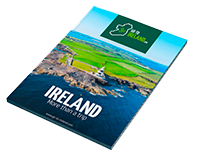
Subscribe to our newsletter and receive our free ebook!
Discover the essentials of the country, its culture, history and must-see sights!
Choose a county!
Find your accommodation in ireland.

Ireland: the Wild Atlantic Way celebrates its 10th anniversary!

Stargate portal links Dublin to New York in real time

Ireland: an Irish schoolboy discovers a 4,000-year-old boat in County Roscommon
with Booking.com
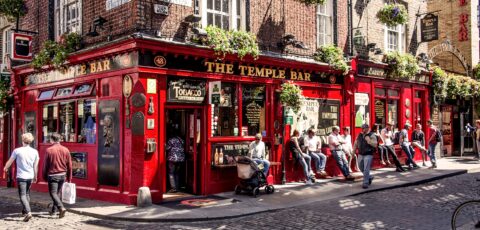
Go to Ireland.com
Our partners.


The 2023 Motorhome Ireland Guide
Motorhoming in ireland – a complete guide, motorhome & campervan travel in ireland.
Ireland is a viable non-Schengen destination for motorhome travel. It can be easily reached from the UK or Northern Ireland and offers a blend of scenic landscapes, cultural heritage, and urban centres.
This guide provides practical information on navigating Ireland in a motorhome, including tips for managing campervan life.
This resource provides comprehensive information for those planning a road trip in Ireland, including driving tips, accommodation options, motorhome services, recommended destinations, and more.
Getting Your Motorhome to Ireland
Crossing the irish sea, liverpool to dublin.
The Liverpool to Dublin route is the sole means of travelling from England to Ireland, and P&O provides four crossings each day. You may select between day and night crossings, which last for eight hours, and arrive feeling energized for your motorhome tour.
Holyhead to Dublin
The Holyhead to Dublin route is available from Irish Ferries and Stena Line, with seven daily crossings from the northern tip of Anglesey in Wales.
The crossing takes only three and a half hours, making it a convenient option for those residing in central England.
Pembroke & Fishguard to Rosslare
Irish Ferries and Stena Line provide daily sailings to Rosslare from Pembroke and Fishguard, respectively, located on the south coast of Wales.
The crossing time from Pembroke is five hours, while it takes four hours and fifteen minutes from Fishguard to arrive.
The following transportation options are recommended for those in southern England seeking to travel to Ireland.
England to Northern Ireland
Stena Line offers two daily crossings on the Liverpool Birkenhead to Belfast route, each lasting eight hours, with the choice of daytime or nighttime travel.
Scotland to Northern Ireland
The are two Scotland to Ireland crossings.
The Stena Lines ferry route from Cairnryan to Belfast has six crossings per day, with a travel time of two and a quarter hours on their ‘Superfast’ ships.
The ferry route from Cairnryan to Larne (located north of Belfast) is operated by P&O. It lasts approximately two hours. The service runs six times daily.
The Stranraer to Northern Ireland crossings stopped in 2012 as the newer and larger ferries required a deep water port.
France to Ireland
Rosscoff to cork/ringaskiddy.
Stena Line provides a twice-weekly overnight crossing that lasts fourteen hours between the ports of Ireland and Europe, making it a convenient option for those planning to tour between the two destinations.
Cherbourg/Roscoff to Rosslare
Brittany and Stena offer four weekly overnight sailings on the Cherbourg route, each lasting eighteen hours.
Stena offers a weekly 16-hour overnight crossing on the Roscoff route.
Spain to Ireland
Bilbao to rosslare.
Brittany Ferries offers two crossings per week from Bilbao and Rosslare, with a duration of 30 hours, making it a viable choice for extended European travels or individuals residing in Spain or southern France.
Crossing into Ireland from Northern Ireland
When sailing into Belfast, it is possible to navigate around the Mourne Mountains and reach the border of the Republic of Ireland within an hour. However, if entering through Larne, located north of Belfast, the journey south will take an additional thirty minutes.
Following Brexit, a formal agreement was established between Ireland and the United Kingdom, known as the Common Travel Area. Only citizens of Ireland and the UK can exercise CTA rights.
Do I need a visa for Ireland?
Passport controls are not in effect for Irish and UK citizens travelling between Northern Ireland and the Republic of Ireland; you only notice the signs changing from MPH to KPH – that’s it. Neither a passport nor a visa is required to enter the other country.
When boarding a ferry, it is necessary to present identification, and some carriers require a passport. It is advisable to confirm the requirements beforehand. Additionally, an immigration officer may request proof of citizenship for Ireland or the UK; thus, carrying a passport is recommended.
How long can I stay in Ireland?
Ireland is excluded from the Schengen area. Therefore, visitors can spend time in the country without affecting 90 in the 180-day rule. UK citizens are allowed to reside in Ireland without any limitations or requirements.
When crossing the border, those who prefer alignment may switch their sat nav from miles to kilometres per hour. It should be noted that Ireland observes GMT, and therefore time does not need to be changed.
UK citizens are permitted to remain in the Schengen Area for a maximum of 90 days within 180 days.
The 90-in-180-day rule operates on a rolling basis, making it challenging to determine if you have adhered to the regulations, particularly if you have travelled to the Schengen area multiple times in the last 180 days.
What food can I take in my motorhome to Ireland?
The regulations for bringing food into Ireland via motorhome are intricate due to the Common Travel Area and vary depending on the entry point. Additional information can be obtained from the Food Safety Authority of Ireland’s website.
Can I use my mobile data in Ireland?
Data usage limitations in the EU vary depending on the mobile phone contract provider and start date. It’s recommended to confirm with the provider to avoid unexpected charges. More information on European SIM cards can be found in the guide , particularly for longer trips.
We recommend ConnectPlus for cloud sim connectivity in the UK and Europe. You can choose from unlimited data packs to just single days depending on your needs. The device is slim and connects with up to ten devices. It can be charged easily with a USB and delivered within a few days.
Can I take a pet to Ireland in my motorhome?
Navigating entry into Ireland can be complex due to the common travel area. Additional information can be found at the provided link.
The Differences Between Northern Ireland and Ireland Explained
Northern Ireland is a constituent country of the United Kingdom of Great Britain and Northern Ireland, along with England, Scotland, and Wales.
Great Britain is a landmass comprising England, Scotland, and Wales and is not considered a single country.
The British Isles is a collection of islands that includes Great Britain, Ireland, the Isle of Man, the Isles of Scilly, the Channel Islands (such as Guernsey, Jersey, Sark, and Alderney), as well as several smaller islands.
Ireland is an independent country and a member of the EU, officially known as the Republic of Ireland. The term “Southern Ireland” is often misused to distinguish it from Northern Ireland. Still, it does not actually refer to a different country.
Motorhome & Campervan Hire Ireland
If you don’t own a motorhome or campervan, flying and renting one is an excellent option for touring Ireland.
Bunk Campers, a campervan rental company, is our recommended choice for Ireland. They offer pickup locations at Dublin Airport and Belfast, which makes round trips and one-way drop-offs convenient.
A two-berth campervan with a double bed in Ireland costs approximately €80-100 per night. Renters must be at least 21 years old.
When driving between Northern Ireland and the Republic of Ireland, there may be a fee of €20-30 that needs to be paid. You must inform your campervan rental company if you plan to cross the border.
When to Visit Ireland in a Motorhome
The peak tourist season is from June to early September, which offers longer days and warmer weather, making it ideal for a campervan holiday, although it may be busier.
Ireland’s areas with high tourist traffic include Dublin, Cork, and certain parts of the Wild Atlantic Way in Galway and Kerry. However, travelling in a van during the summer allows for quickly exploring less popular areas.
Planning between mid-April to May or late September to October is recommended for a more peaceful road trip in Ireland with favourable weather and liveliness as summer approaches.
From November to March, the number of visitors in the area decreases due to the colder and potentially dreary weather. Some tourist attractions may also be closed during this time. However, city sightseeing remains unaffected. The atmosphere in pubs and bars may be quieter during weekdays.
Winter is a popular time for festivals in Ireland, including St. Patricks Day on 17th March, the Galway food festival in April, the Cork Jazz Festival, and the Halloween celebrations in Derry-Londonderry held every October.
Driving a Motorhome in Ireland
Over the past decade, Ireland has received significant funding from the EU for its road network. As frequent visitors, we have observed substantial enhancements in the motorways around Dublin and the rural road system throughout the country.
Irish Speed Limits for Motorhomes
Adherence to speed limits when travelling by campervan in Europe is essential, as speed cameras and authorities may enforce fines for non-payment. This policy remains the same post-Brexit due to the continued information-sharing agreement with the DVLA.
Motorhomes
- Town and city – 50 km/h
- National roads and dual carriageways – 100 km/h
- Regional and non-national roads – 80 km/h
- Motorway speed limits – 120 km/h
- Particular speed limits – 30 km/h or 60 km/h (assigned)
Motorhomes > 3,500 kg:
- National roads and dual carriageways – 80 km/h
- Motorway speed limits – 90 km/h
Documents You Need to Travel & Drive in Ireland
To ensure compliance with travel regulations, it is recommended that visitors to Ireland have a valid passport covering their stay. It should be noted that UK citizens are not required to possess a passport for entry, although carrying one is advised.
- As of August 2021, having third-party insurance is mandatory for all vehicles. Additionally, a green card is no longer needed to verify coverage while travelling in Europe.
- A UK driving licence permits driving in all EU countries. However, suppose you possess only a paper licence or a licence issued in Gibraltar, Guernsey, Jersey, or the Isle of Man. In that case, you will require an International Driving Permit.
- Breakdown cover documentation (not compulsory).
- Vehicle V5 logbook (which must show your correct address).
- Personal travel and medical insurance (we recommend True Traveller), EHIC orGHICcard (optional).
- Animal Health Certificate if you’re travelling with a pet to Ireland or Northern Ireland.
Vehicle Safety Equipment for Ireland
In contrast to other European nations, Ireland does not mandate possessing any vehicle equipment. However, our recommendation for necessary items is as follows:
- Warning triangle.
- Reflective jacket.
- Spare wheel and the tools to change a wheel or a tyre repair kit.
- First aid kit.
- Spare bulbs and fuses.
- Fire extinguisher.
Since 28th September 2021, you must display a UK sticker on the rear of your vehicle instead of a GB sticker unless you have a new style UK numberplate showing the Union Jack flag.
Driving a Motorhome in Ireland Tips
Ireland shares the same driving direction as the UK on the left side.
In certain rural regions, the width of the roads may not allow for safe motorhome travel. Still, smaller camper vans should be able to manage. In many cases, there are no areas designated for passing. Reviewing your intended route and strictly following any posted signs is advisable.
When driving in rural areas, it’s essential to be aware of slow-moving agricultural vehicles and animals like sheep and cows being herded along the roads. Driving cautiously and following local driving customs is recommended, as this is not a region where speed is a priority.
The use of A-frames by UK motorhomers abroad is not advised by the Department for Transport. There is some uncertainty regarding towing a car fixed to a trailer, as conflicting advice can be found online.
Vehicles that fall under the categories of campervans or motorhomes, and cars with caravans or trailers, must not exceed a maximum total length of 18.75m, a height of 4m, and a width of 2.55m.
The maximum weight limit for the driving axle is 10.5 tonnes, and for a single axle, it is 10 tonnes.
It is illegal to possess or utilize a radar detector. If discovered, one could face a penalty and have the equipment taken by the Garda.
Currently, there are no designated low-emission zones in Ireland.
Dublin is the only (at the time of writing) Irish city with an Urban Access Scheme implemented. Still, it solely pertains to vehicles with over five axles. Additional information can be found at the provided link.
The Garda has the authority to issue fixed penalty notices in person or attached to your windscreen. Payment must be made within 28 days, or you may choose to go to court. Fines not paid within the given timeframe will increase by 50%.
The legal limit for alcohol in Ireland is 50 milligrams per 100 millilitres of blood, which is lower than the UK’s limit of 80 milligrams. Random breath testing is enforced in Ireland, and drunk drivers face severe penalties such as fines, imprisonment, and disqualification.
In the event of an accident, complete the EU Accident Statement. If your insurer hasn’t provided one, you can download it here. Use your hazard lights and warning triangle to stop safely and alert other drivers. Exchange details with the other party and take photos for your form. If the other party won’t give details or there is an injury, call the Garda on 112.
Toll Roads in Ireland
Ireland has a total of eleven motorways that require payment of tolls.
Certain toll stations do not accept credit cards. In contrast, the M50 toll road is solely electronic, necessitating online payment unless one possesses an electronic toll tag.

I've been camping since Santa brought my first tent when I was a wee boy in Scotland. Since then, I've camped out, stayed in motorhomes and Glamped worldwide. By day I sit in front of a computer, and by day off, Im typically found (lost) in the outdoors.
Guide To Camping Tent Sizes and Capacity
Glamping in ireland.


Daventry: 01327 703 371
Hitchin: 01462 452 856
Touring Ireland in a Motorhome: Where to Go

There comes a time when you crave to see something spectacular but don’t want to fly too far from the nest. Have you thought about touring Ireland? It has some of the most beautiful landscapes and popular tourist attractions known, so why not explore them for yourself?
Touring Ireland in a motorhome is a goal of many of our customers, and we’d like to help out. In this article, we’ll tell you our top picks, from scenic routes of the rocky mountains and riverscapes to historic architecture not to be missed on your travels.
Touring Ireland in a Motorhome: The Three Most Popular Routes
The Ring of Kerry
Where is it.
The Ring of Kerry is situated in the southwestern part of Ireland. Just like its name, it’s a circular route around the Iveragh Peninsula. It’s also wide enough that you’ll have no problem touring Ireland in a motorhome here.
What Does It Have to Offer?
Be careful when you blink or you might miss what the Ring of Kerry has to offer. Bustling with life, you may find a cliff on your left and river on your right, behind you a farm of horses curiously gazing as you drive, and nothing but the open road in front of you.
What Can I Do There?
If you’re planning a motorhome trip on the west coast of Ireland, there is an infinite list of things to do and places to see. In fact, the Ring of Kerry is close to many of these:
- Derrynane, Rossbeigh, and St Finian’s Bay beaches
- Lakes of Killarney
- Killarney National Park
- Muckross House and Gardens
- Galleries and old-fashioned pubs in Kenmare
- Star Wars: The Force Awakens filming location the Skellig Ring
- Skellig Michael (Great Skellig)
- Torc Waterfall
Causeway Coastal Route
Causeway Coastal Route is one of Northern Ireland’s great mysteries. It runs along the coast of Belfast to Londonderry, passing through many iconic attractions.
This magical route changes depending on the season you travel. Beauty will surround you, be it the foggy coast making you wonder where the rocks end and the ocean starts, or simply stopping to see what the towns have to offer. If you happen to bump into the locals, you might be surprised by the myths and legends surrounding the area.
If you are a fan of Ireland’s many cliffs, you will be pleased to know there are many more to see along Causeway Coastal Route . If not, we recommend the guided tours and other tourist attractions available, including:
- The Gallery Whitehead
- Magilligan Point Nature Reserve, home to the largest sand dune in the British Isles
- Carrick-a-Rede Rope Bridge
- Giant’s Causeway
- The Gobbins Cliff Path
- Glenarm Castle and Garden
- Naturally North Coast and Glens Artisan Market
- McComb’s Game of Thrones Tour
The Wild Atlantic Way
The Wild Atlantic Way is another long coastal route running along the western and northwestern part of Ireland.
If you are a fan of scenic drives, then you should plan your motorhome trip on the west coast of Ireland. The Wild Atlantic Way covers a good half of the country, where there is tons of greenery around you and the bluest ocean you could possibly see.
You can truly get a sense of Irish culture travelling this route, so why not take advantage of the many things it has to offer? Such as:
- Aillebrack Beach
- Achill Head
- Aasleagh Falls
- Claggan Island
- Doonagore Castle
- Bantry House and Gardens
- Buncrana Bridge
Touring Ireland in a Motorhome: The Most Popular Tourist Attractions
The Dark Hedges
When touring Ireland in a motorhome, this famous site is not to be missed. Located along Bregagh Road between Armoy and Stranocum in County Antrim, Northern Ireland, the Dark Hedges are just off the Causeway Coastal Route. If you’re in search of a detour, this may be the next journey for you.
The Dark Hedges may sound spooky, but you only have to worry about that at night or the colder months. Once the sun is out and shining bright, this ancient phenomena thrives. However, if you do happen to visit in winter, the foggy weather creates an eerie feeling once depicted in Game of Thrones.
This famous tourist attraction is open 24/7 and is completely free to enter as it’s a public road. However, Bregagh Road is only for pedestrians, which means you’ll have to park up to visit—there are absolutely no vehicles allowed.
Here are some interesting facts (including things to learn and see) about the Dark Hedges:
- It was formed by the residents of Gracehill House to impress visitors
- There is a ghost story about the Grey Lady, believed to be a maid who mysteriously passed away centuries ago
- Games of Thrones filmed there (The Kingsroad: season 1, episode 2)
- It has a Tree Preservation Order
- Beech trees
- Brambling birds
Cliffs of Moher
Cliffs of Moher is situated on the west coast of Ireland in County Clare, and is the perfect place to take a break from the Wild Atlantic Way.
Other than the astounding views surrounding you, Cliffs of Moher is a tranquil area suitable for relaxing after a long day of travelling, simply having lunch while admiring the scenery, or walking your dogs early in the morning.
There is no better place to end your motorhome trip on the west coast of Ireland than Cliffs of Moher. To ensure a safe visit, we recommend you book a ticket and take a guided tour. There are safe areas for those with children and mobility issues, but the cliffs do not have safety railings.
Upon entry, you are welcomed by many amenities, such as:
- O’Brien’s Tower
- Interactive cliffs exhibition
- Craft & gift store
- Craft and retail street
Rock of Cashel
The Rock of Cashel, or St. Patrick’s Rock, is a historic site in County Tipperary. It was the former seat of the Kings of Munster before it was given to the church in 1101, becoming the seat of the Archbishop.
You may be wondering what’s so special about the Rock of Cashel compared to many other castle-like tourist attractions. This is actually one of the many sites not located near a beach or on a cliff top, so you can take full advantage of the paths and nature around you before trekking up the small hill to see the actual site.
Don’t be fooled by its appearance as the Rock of Cashel has much more to offer than its name. When you book a ticket , this is what you can look forward to:
- Cormac’s Chapel
- Exhibitions and museums
Once you’ve completed your guided tour, why not visit the surrounding areas? Such as:
- Holycross Abbey
- Cahir Castle
- Swiss Cottage
Modern Motorhomes at Venture Caravans
We hope our diverse list of Ireland’s most popular routes and tourist attractions have inspired you to plan your very own trip. While much of the country has fantastic sightseeing, we recommend a motorhome trip on the west coast of Ireland for the best experience.
Touring Ireland in a motorhome is no problem with our modern and family-friendly vehicles . If you are looking to start your motorhome adventures, or just want to change your current motorhome, then contact us for expert advice.
© Copyright 2024 - Venture Caravans & Motorhomes - All Rights Reserved. Web Design & SEO By Pod Digital
Privacy Overview
Necessary cookies are absolutely essential for the website to function properly. This category only includes cookies that ensures basic functionalities and security features of the website. These cookies do not store any personal information.
Any cookies that may not be particularly necessary for the website to function and is used specifically to collect user personal data via analytics, ads, other embedded contents are termed as non-necessary cookies. It is mandatory to procure user consent prior to running these cookies on your website.
- New Caravans
- Used Caravans
- Sell Your Caravan
- New Motorhomes
- Used Motorhomes
- Sell Your Motorhome
- Autosleeper
- Sell Your Campervan
- Trailer Tents
- Caravan Awnings
- Motorhome Awnings
- Campervan Awnings
- Part Exchange
- Accessories
- Campervan Offers
- Caravan Offers
- Motorhome Offers
- +44 28 8765 8077
- bookings@campervan-ireland.com
The Ultimate Guide To Campervanning In Ireland
A campervan trip can be one of the best ways to get away, explore new places and spend some time in the great outdoors without having to give up all your home comforts.
Of course, you need to make sure you choose the right destination and that you’ve done some research and planning before you set off.
If you’re thinking of visiting Ireland in your campervan or motorhome this year, then this guide is for you. Below, we’ll take a look at where to go, where to stay and everything else you need for the perfect campervan trip in Ireland.
Why go to Ireland? There are so many reasons that you should consider Ireland for your next road trip. Firstly, it has loads of beautiful routes you can take along the coast, inland and even through some of the nation’s top cities.
It is also bursting with historic sites, breathtaking landscapes and incredible beaches. As a nation, Ireland is pretty geared up for campers, so there are lots of impressive campsites and stopovers to choose from too.
Not only this, but it is one of the greatest places in the world for hospitality, music and comedy, and you’ll have the opportunity to try loads of great food and drink along the way.
Need we say any more?
If you’re looking for a friendly, exciting and enjoyable place to go on a campervan holiday, Ireland is the place for you.
How to get there There are several ways you can get to Ireland but this will very much depend on your campervan status. What we mean by this is, do you have your own campervan or are you planning to rent one when you arrive? This will usually determine your style of travel, though you have a couple of options.
Getting the ferry If you’re planning on taking your own campervan over, you’ll need to get the ferry from the UK. There are several different ports you can leave from and travel to, including Liverpool, Pembroke, Cairnryan and Holyhead. These ferries travel to and from Dublin, Belfast, Larne and Rosslare.
Of course, you can travel on the ferry even if you aren’t taking your own campervan, but this is typically the longer way to travel. You might do this if you want to drive your own car over.
Flying to Ireland If you’re planning on renting a campervan when you arrive, you might wish to fly to Ireland instead. This can be the quicker (and sometimes cheaper) option and means you can travel over there from multiple locations, not just the UK.
Renting a campervan If you don’t have a campervan of your own, you’ll need to hire one for your road trip. When you arrive in Ireland, you can head over to your chosen campervan provider to pick up your temporary home on wheels.
Some providers will even pick you up in your camper, for example, from the airport, or drop it off at your chosen location rather than you having to make your way to their offices. You can choose the pick-up and drop-off time that best suits you and your travel arrangements.
What’s more, as these are being hired out, most companies will use new, state-of-the-art campervans and motorhomes, though some do prefer to use older and more quirky vehicles.
Be sure to do your research into reputable companies like Campervan Ireland, before you book your van and pay for the rental. By doing this, you’ll make sure that you get the best possible service and that your campervan is of the highest standard for your trip.
When to go There’s never a bad time to go to Ireland, but if you want warmer, dryer weather then there are certain times of year that are better to visit. The ideal time to go, as with most places in the UK is between April and October.
That being said, remember that Ireland is called the Emerald Isle for a reason. It is very luscious and green, but it is that way because it rains so often. So no matter the time of year, you need to be prepared for the odd shower, even in the warmer months.
July and August might offer the hottest weather, but as also it’s the school holidays these are some of the busiest months of the year. What’s more, when there are big events on like the Rugby Six Nations, St Patrick’s Day, Easter weekend and Christmas, you might also find it becomes very busy and usually more expensive.
But despite these times being busier, there are often lots of fun and festive activities going on, so you should still consider these dates if you can afford to go then.
Where to go There are so many wonderful places to go in Ireland that narrowing down your list can be tricky, especially when you’ve got limited time on your trip.
Many have been fooled into thinking Ireland is a smaller country (well, an island) and therefore, it is easier to see and do everything in a short space of time. This is simply not true. With so much beauty around every corner, you’ll want to spend years exploring!
But if you can’t having a few ideas about where to go can get your planning off to a good start and will ensure you don’t miss out on anything you really want to see or do. To give you some inspiration, we’ve put together a few ideas for routes, regions, spots and attractions you might wish to visit on your trip.
The best road trips in Ireland There are some routes and loops that are already established as being beautiful and rewarding drives. From the coast to the mountains, some of the best road trips Ireland has to offer include:
• The Copper Coast – Tramore to Dungarvan • The Wild Atlantic Way – Inishowen Peninsula to Kinsale • The Ring of Kerry – Killarney • Mayo coastal road trip – Ballina to Killary • The Old Military Road – Rathfarnham to Aughavannagh • Slea Head Drive – Dingle • The Ring of Beara – Glengariff • The Burren Loop – Ballyvaughan • Sky Road Loop – Clifden • The ‘Four Peaks’ Challenge – Carrauntoohill to Mweelrea and Slieve Donard to Lugnaquilla The top scenic spots The great thing about having a home on wheels is you can venture to new places you might not have been able to access or stay on a traditional holiday. You can visit and stay overnight in some of the nation’s most beautiful spots, so you can spend your days visiting some of the most scenic locations Ireland has to offer. To give you some ideas of where to go, we’ve put together a list of some of the greatest spots:
• The Cliffs of Moher • The Connemara region • Voya Seaweed Baths • Dingle peninsula • Waterford Greenway • Giant’s Causeway • The Burren • Newgrange • Wicklow Mountains National Park • Sliabh Liag
Some of Ireland’s best cities Whether you drive your van directly into the center or you choose a campsite or parking spot on the outskirts of the city, there are loads of wonderful places to visit. If you love experiencing new cities and you want to sample some great food, drink, shopping and entertainment, there’s nowhere quite like an Irish city. During your trip, we recommend you visit the following:
• Dublin • Belfast • Galway • Cork • Kilkenny • Limerick • Donegal • Waterford • Derry • Killarney
Best spots for camping If you’re in need of some inspiration for where to stay, of course, you can choose the sites you’d like to visit and look for a campsite or stopover nearby. Alternatively, if you want to do a bit of responsible free camping during your getaway, it can be helpful to know some great spots to stop.
So, to help you get the most from your trip, we’ve put together a few of the places to go, these include:
• Eagle Point Camping, County Cork • Ben Crom Reservoir, County Down • Nore Valley Park, County Kilkenny • Omey Island, Connemara • Baginbun Beach, County Wexford • Mullaghderg Beach, County Donegal • Hook Head, County Wexford • Minard Castle, County Kerry • Wicklow Mountains National Park, County Wicklow • Rosguill Peninsula, County Donegal
But remember, these are just a few suggestions and with so many incredible places to see and things to do, it’s important you do your own research and plan the best route for you.
Where to stay As we said earlier, Ireland is geared up for those who enjoy camping, campervan and motorhome holidays. Because of this, there are loads of different places you can stay and facilities to suit every need and camping style.
When planning your trip, not only do you need to think about the various regions you might want to visit and sites you want to see, but also where you’ll be staying around that area. Below, we’ll look at the different places you can stay in more detail. Staying at campsites The first and most obvious place to stay is a campsite. There are sites dotted all around Ireland, many with beautiful views, great amenities and close proximity to the tourist hot spots.
If you’re planning on booking up a campsite, or maybe even several different campsites throughout your trip, then it’s also good to do some research beforehand and look at the reviews online.
You can also make use of dedicated camping and road trip apps that highlight all the nearest sites to your current location. These will often have a rating system, along with a list of all the amenities available at each site.
Of course, choosing to stay on a campsite for your trip offers a safer environment and access to all the facilities and amenities you might need for your stay.
Are there Aires? If you’re used to travelling around Europe, you’ll know that places like France, Italy and Germany have dedicated overnight spots called Aires.
Unfortunately, Ireland is like the UK in that it doesn’t have spaces that work the same as these Aires. However, there are some spaces that offer approved motorhome parking and which are not official campsites that you can stop at.
Just make sure to always check the rules if you’re going to stay somewhere that isn’t a campsite.
Pubs and stopovers This moves us nicely on to the next point. There are also lots of approved overnight parking spots that you can stay in around Ireland, such as pubs, services and restaurants.
Many are part of a scheme and require you to pay for goods or services in exchange for a place to park for the night. For example, going into a pub and having a meal, then being allowed to stay overnight in the pub car park.
However, it’s worth noting that most of these places won’t have motorhome facilities, so you have to be aware of this. But they can be a great way to save some money on your trip and support local businesses.
Are you allowed to free camp? You might be wondering about free camping and staying the night in rural spots. While it is technically illegal to free camp in Ireland, there are plenty who do it with no trouble so it is an option.
You could choose this approach to save money, but also to spend your days and nights in some of the country’s most beautiful locations, without having to head back to a campsite.
You shouldn’t have any problems provided you are tidy, respectful and follow any local rules. This means always cleaning up after yourself, being quiet and not disturbing any of the local flora or fauna.
However, we do not recommend you do this if you need access to facilities and never dump your waste or rubbish in these rural locations.
Campervan facilities and services In some cases, you might be able to find facilities and places to refill your water or empty your toilet cassette without paying for a campsite for the night.
These services are few and far between as they are not as popular, but they do exist. Again, there are handy apps you can download that will point you in the direction of these helpful facilities.
The rules of driving in Ireland There are several rules for driving in Ireland that you need to know about. If you’ve been on a campervan holiday before, these will differ depending on where you’ve been, so it’s worth refreshing your mind.
When driving a campervan in Ireland you must have a UK sticker attached to the back of the vehicle or reg plates (and trailer if you have one). Plus, you must have a spare wheel and the tools to change it, or a puncture repair kit, and if you wear glasses you must also carry a spare pair with you in case something happens to them.
And as with any destination, always make sure you abide by the speed limits and follow local traffic laws. It can also be helpful to make sure you have your driving license, insurance details and any rental documents to hand just in case.
Campervanning with a dog
One of the key reasons that many choose to go on a campervan holiday is that they can take their furry friends with them. However, some places in Ireland are more dog-friendly than others, so if you plan to take your pooch with you, always check ahead.
Yes, there will be beaches, parks and fields where they can run about and most campsites will allow dogs on site. But it’s worth noting that some places aren’t as easygoing and many pubs and restaurants might not let them in at all.
So before you go, take a look at the most dog-friendly places across the country and ensure your trip won’t be halted if you take your dog.
It’s also important to know that your dog must be microchipped and up to date on vaccines to enter the country. And if you’re renting a campervan, make sure dogs are allowed in the van before you go.
7 handy campervan holiday tips If you’re relatively new to the campervan lifestyle (and sometimes even if you’re not) there are some handy hints that can help you to get the most from your trip.
In this final section, we’ve pulled together some of our top campervan tips to make your trip run smoothly.
1. Make sure you know how the electric and gas works One of the most important things you need to do, and this is usually more important in a rented campervan, is to make sure you know how the gas and electricity work. You also need to make sure you monitor this so that you don’t run out of gas or end up with a flat battery.
Wherever possible, use electric hookups at campsites and services to persevere your battery.
2. Don’t overpack There is always the temptation to overpack. After all, you don’t want to be in the middle of Ireland and realise you don’t have your favourite jumper or pair of shoes.
However, you need to be aware of the weight of your camper and its contents. Plus, you don’t want to have to try and find space for everything in a smaller van.
So always be deliberate and smart about what you pack. This way, you can be prepared for any weather, situation or mood, without feeling cramped or having to pack up half your belongings before you leave.
3. Keep everything tidy As we’ve briefly said, a campervan is a small space. Therefore, you want to keep it as clean and clutter-free as possible.
Often these vans and motorhomes will come with clever storage solutions. But always be conscious about putting things away once you’re finished with them. Particularly as you don’t want things rattling around in the back while you’re driving.
4. Think about Wi-Fi If you don’t plan on staying on a campsite every night, but you want access to Wi-Fi, you might wish to buy a portable device.
Just be aware that these generally operate using a phone signal, so if you’re in an area with little to no signal, it may not work. Therefore, it’s best to check the coverage in the area before signing up.
5. Download useful apps before you go Another tip we’ve already touched on is dedicated apps that can make your journey more enjoyable. Whether you need a sat nav, a campsite app or anything else, be sure to download these and set up the appropriate accounts before you hit the road.
6. Make sure you pack up properly While we advise that you don’t overpack, it’s important that you think about the situation you’re going to be in and pack accordingly. For example, Ireland can be wet, so a raincoat or umbrella can be beneficial.
What’s more, if you’re camping in the colder months, make sure to take some extra layers as it could get chilly.
Also, think about any handy devices or gadgets that can make your life easier. This could be a portable phone charger, a torch, a solar shower or a comfy camping chair.
Whatever the case may be, always plan ahead and make sure you pack accordingly without going overboard.
7. Know your dimensions Finally, it’s vital that you know how big your campervan or motorhome is so you don’t misjudge this. The last thing you need is to try and go under a barrier or squeeze down a tight lane and damage the bodywork.
Plus, you may be asked about the size of the vehicle when booking on to campsites and you don’t want to get this wrong, so make sure you’re aware or have it written down somewhere.
So what are you waiting for?
Ireland is a wonderful nation with so much to offer and a campervan holiday can be the perfect way for you to experience the country, or parts of it at least. So if you’ve read this guide and it all sounds great, what are you waiting for?
Whether you’ve got a campervan of your own or you’re planning on hiring one when you get there, start doing your research and planning your trip to Ireland right away.
We promise you won’t regret it!
Martin Dorey | 16 May 2020
The emerald eye: 5 of ireland's most scenic campervan journeys.
Martin Dorey has spent over 25 years exploring Ireland by campervan and motorhome. The result? His new book Take The Slow Road: Ireland, and these expert-recommended Irish campervan journeys...
1. The Copper Coast: Waterford

Tramore Beach (Shutterstock)
Best for: Hidden beaches
Between Tramore and Dungarvan on Ireland’s south coast you’ll find a UNESCO Global Geopark, old mine workings, fascinating geology and a whole lot of amazing beaches.
One of Ireland’s best loved wild swimming spots can be found at Newtown Cove near Tramore. Surfers might find a few secret spots on this coast too, while one of Ireland’s best hidden beaches, Stradbally, hides in plain sight.
There’s also a new ‘Greenway’ traffic-free route for walkers and cyclists, which links Dungarvan with Waterford. The views as you approach Dungarvan are spectacular. Stay at new designated motorhome parking places in Dungarvan.
2. The Slea Head Drive: Dingle Peninsula

Coumeenoole (Martin Dorey)
Best for: Cliff-hugging driving and beehive huts
Head west out of Dingle town on the Slea Head Drive and you’ll pass a collection of beehive huts hunkering down on the hillsides above the road. Some are still in use by local farmers but the best preserved are open to the public, for a small fee. No one knows their true age but suffice it to say they aren’t of this world.
Continue on and you’ll come to Coumeenoole, a beach with incredibly clean water, bright yellow sand and churning rollers. A little further on, Blasket Island Centre has stunning views of Great Blasket and reveals a fascinating story of people and language. Overnight at Campail Teach an Aragail near Dingle.
3. The Antrim Glens

Glenariff Falls (Martin Dorey)
Best for: Victorian attractions
The A2 coast road hugs the coast all the way between Larne and Cushendall. Further north you’ll find the big-hitting Game Of Thrones attractions like the Giant’s Causeway and the Dark Hedges but, here the secret is to find lost Victorian wonders.
The Waterfall Walk, designed by visionary railwayman Berkeley Deane Wise, takes you down into the depths of a steep gorge to visit Glenariff’s spectacular falls. Further down the coast, on Islandmagee, another of his attractions, The Gobbins Path, will take you along the coast on a series of paths and bridges cut into the rock. Park up for the night in one of a few designated overnight spots at Glenariff.
4. The Shannon Waterway

The pretty town of Athlone on the Shannon (Shutterstock)
Best for: Getting to the Celtic heart
From the Shannon Pot to Killaloe, Ireland’s greatest river is awash with ancient sites and culture. Visit sweat houses on the shores of Lough Allen, if you can find them, or take a walk around Rinn Duin, one of Europe’s best-preserved medieval towns.
Roam contemporary art galleries in Athlone and Leitrim, sip a Guinness in Sean’s Bar in Athlone (Ireland’s oldest), marvel at stunning decorated high crosses at the ruined abbey at Clonmacnoise, and tour Ireland’s spiritual heartland, The Hill of Uisneach near Lough Ree. Stay at the motorhome overnight stop at Portumna.
5. From Clifden to Westport

The starry night sky at Clifden (Martin Dorey)
Best for: Glimpses of the Wild Atlantic Way
The Wild Atlantic Way covers 2,500km on Ireland’s west coast, so don’t expect to see it all in one go. But for a glimpse, the Sky Road, a wibbly wobbly ‘wow’ of a road that takes you out along the top of a finger of land in Connemara, just outside Clifden, is epic.
Park up for the night at Clifden Eco Beach Camping. Then there’s Killary Fjord, the Doolough Valley and finally, just outside Ireland’s coolest little town, Westport, there’s the hulk of Croagh Patrick. Climb it and see the 365 islands of Clew Bay below you. Stunning, in any weather.

Follow Martin's Irish journey
Take the Slow Road: Ireland by Martin Dorey is published by Bloomsbury and is out now in paperback and ebook (Paperback, £20.00)
Discover more of scenic Ireland:
Wild atlantic way: the best road trip itinerary, 9 things to do in county down, northern ireland, northern ireland's causeway coast: the best road trip itinerary, related articles, looking for inspiration.
Join our newsletter
Get the very best of Wanderlust by signing up to our newsletters, full of travel inspiration, fun quizzes, exciting competitions and exclusive offers.
- Sign up\Login
Travelling to Ireland by motorhome
Motorhome stopovers | travel tips | inspiration | information, through ireland by motorhome.
In Ireland, the rugged countryside is just crying out to be discovered on a motorhome journey. Almost nowhere in Europe will you find such unspoilt nature as here. Spread across the country are many natural pearls that are perfect to visit with a campervan. Besides the beautiful nature, the country also offers some very cosy cities where you will get to know the Irish culture during your motorhome trip with a pint of Guinness in your hand in one of the many cosy pubs. Cheers!
B í odh turas deas agat! Safe travels!
Capital Dublin Population 5.03 million (2021) Official language Irish & English Surface 70,273 km 2 Currency Euro Total motorhomes unknown

More inspiration

Travelling to the Baltic countries by motorhome!

Discover the mediterranean Alpine life in southern Switzerland!
Camperstops in ireland.

Motorhome-trip through Ireland
Ireland is the perfect destination for a good change between nature and city on a motorhome tour. Typical Irish cities such as Dublin, Cork and Galway are located throughout the country, but also nature can be admired from a campervan. There's the Irish coast with its sights like the Cliffs of Moher, but the national parks like the impressive Killarney National Park are also worth a visit during your motorhome journey. So there's plenty to discover in rugged Ireland!
With the permission of any landowner, you can camp freely in Ireland. Along the road or on car parks this is allowed for 24 hours. A good way to get to know the real Ireland!

Motorhome stopovers in Ireland
Unfortunately, there are not (yet) many official camper sites in Ireland. In Ireland there are about 50 official camper pitches spread over the country, many of them are very beautiful. Most of them are located at the coast, for example close to the city of Cork . Perhaps one of the most beautiful motorhome parks on the west coast is at the famous Cliffs of Moher , where you will find a set of rugged limestone cliffs. Further inland, there are also plenty of campervan parks, including in the varied Wicklow Mountains National Park , where you can head out for a nice walk. See the full range of camperstops in Ireland here.

Motorhome routes through Ireland
Ireland has plenty of wonderful motorhome routes to choose from. The Wild Atlantic Way stretches 2500 kilometres along the rugged coastline and is the longest tourist coastal route in the world. The Causeway Coastal Route is also an impressive way to discover Ireland by motorhome. The route goes from Belfast to Londonderry. In addition, the Ring of Kerry is often regarded as one of the country's most scenic motorhome routes. It takes you along the impressive south west coast of Ireland by campervan. The campervan routes all have one thing in common as they all introduce you to the rugged Irish countryside in all its glory! Finally, you can also create your own motorhome route through the varied interior of the country, with its many lakes, forests and impressive views.
Discover more of Europe
popular destinations, more inspiration.
As a registered user you can make use of all the functionalities of Camperstop.com. Create an account or log in.

Discover Ireland by Motorhome
Touring ireland in a motorhome.
Touring around Ireland is a relaxed unspoiled country where you can enjoy the outdoor life. From the pure unspoiled landscapes and the drama of the coastline to the country’s dynamic cities mixed with the magic of thousands of years’ worth of culture and history, Ireland’s energy and romance will win you over.
Many fine historical establishments showcase contemporary interior design and sophisticated elegance. Ireland also has a culinary landscape boasting exquisite home-grown ingredients from the sea to the land, which is why Motorhome hire in Ireland is very popular.

Tour around Ireland-Belfast
Belfast is Northern Ireland’s capital and the birthplace of the Titanic which famously struck an iceberg in 1912. In remembrance there is a Titanic quarter in the renovated dockyards. Voted as one of the worlds top destinations in 2012 it is a bustling city with stunning scenery, historical landmarks and a vibrant city centre.
Ideas for your stay:
Titanic visitor centre.
A museum commemorating the ship and the lives lost on her maiden voyage.
The Crown Bar
46 Great Victoria Street, this pub attracts visitors worldwide, including President Bill Clinton. The BBC have produced a documentary about it.
Belfast castle
Building began in 1862 and finished in 1870 by the third Marquis of Donegal
Ulster Museum
The largest museum in Northern Ireland, there is fine art, history, natural science and three children’s discovery centres focusing on art, nature and history .

Motorhome hire Ireland-Dublin
Dublin is the capital of Republic of Ireland. Most would agree that Dublin is not the most beautiful city in the world, although the Georgian bits do ooze elegance. However the city has a personality which is more important here. Dubliners are great hosts and the atmosphere there is so infectious and charismatic that you may never want to leave.
Must sees and dos!
To experience Dublin’s inhabitants at their best you must spend some time in a pub. A night out in Dublin’s pubs is one of the most memorable experiences of a visit to Dublin.
Kilmainham Gaol
You can have a tour of the gaol which has an eerie feel to it. The tour provides you with the history of the gaol including the uprising in 1916. Advance booking is advisable.
Walking Tours
To find out knowledge and history about the city
Irish Whiskey Museum
Learn about the rich and interesting history to Irish Whiskey and enjoy the generous samples.

Motorhome hire Ireland-Armagh
Armagh is the ecclesiastical capital of Northern Ireland, the smallest of the six counties but not short of history, culture and scenic landscapes.
What’s there to do?
St patrick’s cathedral (catholic).
A grand and imposing buildingfrom the outside, the architecture is stunning. It is situated at the top of a hill with nice views.
Gosford Forest Park
There are some lovely walks here, both long and short to suit all abilities. Enjoy the scenery and the different animals there- the resident herd of deer, some rare breed sheep and a poultry collection.
Market Place Theatre
There are lots of great shows on here, a very intimate auditorium with a great view from every seat

Motorhome hire Ireland-Galway
Galway is a harbour on Ireland’s west coast. It is an arty, bohemian city with brightly painted pubs, street performers, the city buzzes with a contemporary and cultural vibe. Students make up a quarter of the population. Remnants of the city walls lie between shops.
Galway is often referred to as the most ‘Irish’ of Ireland’s cities. It is the only city in Ireland where you’re likely to hear Irish spoken in the streets, shops and pubs.
What is there to do in Galway?
Connemara national park.
Galway has an ever changing landscape. From harshness to beauty. This is a lovely area to explore the views. Drive along the western seaboard with the Atlantic Sea to your left, this is stunning, you will have to keep stopping to admire the area.
You can also do a variety of walks within the National Park.
Quay Street
This is an Irish street filled with stores for shopping, pubs for eating and drinking and entertainers trying to make a living. It is a busy street with a mix of tourists and locals.
Galway Cathedral
A grand cathedral in a lovely riverside setting. It is a good landmark as the dome can be seen on the skyline. Recent rennovations enhance its beauty.

Motorhome Hire Ireland-Cork
Motorhome hire ireland- cork.
Cork is just inland from Ireland’s south west coast. Known as Ireland’s second city. Locals refer to it as the real capital of Ireland. The compact city centre is set on an island in the River Lee surrounded by interesting waterways.
Old City Market
This is a lovely old market with lots of fresh produce available. There is a fantastic restaurant upstairs where you can sit and look over the vendors below to soak up the atmosphere.
Fota Wildlife Park
A 100 acre wildlife park located on Fota Island. The park is home to nearly 30 mammal and 50 bird species. All animals are on view, the park is very well laid out. A great day out for all the family.
Ballycotton Cliff Walk
The cliff walk is from Ballycotton Village to Bollyandreen beach, it runs along a cliff track with meadows on one side and the sea on the other. It is a 5 mile walk with stunning views.

Motorhome hire Ireland-Kilkenny
Kilkenny is a medieval town in southeast Ireland. The town has deep religious roots and has many well preserved churches and monasteries. It lies just 75 miles south west of Dublin. The River Nore flows through the town splitting it in two. Kilkenny is a centre for arts and crafts, and home to a host of fine restaurants, cafes, pubs and shops.
What do see in Kilkenny?
Kilkenny castle.
This is one of the finest castles in Ireland. It has wonderful grounds, the setting looking over the river is breath taking and the grounds are open as a free attraction.
The castle is huge and it is well worth doing the tour there.
Smithwicks Experience
A brewery experience. Find out how the ale arrived in your glass from a medieval abbey. Meet the ale that has taken centuries of turbulent times on the chin and survived the odds. It is brewed using the finest ingredients and centuries of experience.
Your journey at Smithwicks starts in 1231 and carries on through time.
Cycling Tour
Book a two hour guided cycling tour with Kilkenny Cycling Tours which takes you around the historical and cultural sites of Kilkenny. There are bikes to hire (if you need to) and the tour uses riverbank paths and back streets to avoid heavy traffic.

Motorhome Hire Ireland-Londonderry
Derry, also known as Londonderry is a city on the River Foyle in Northern Ireland. It has perfectly preserved 17 th century walls along with bastions offering wide views over the historic streets and buildings on one side and the blue Donegal hills on the other.
What to do in Derry
Walk the city walls.
Well worth the time. The local tourist board has done a good job providing information and making a feature of the walls. There are notices at various points explaining the different gates/views etc. For people who remember the troubled past it is quite sobering looking at the divided city and the locations that are familiar from the time of The Troubles. Londonderry is the only city in Northern Ireland with an intact surrounding wall.
Peace Bridge
Opened in 2011 costing £14 million to build, the length of two football pitches. The bridge was funded by the E.U’s Peace lll programme under the shared space initiative which supports projects that bring together communities that have been formerly divided.
Walk with Derry City Tours for an award winning tour, no need to book, the tour leaves 11 Carlisle Road every day at 10am, midday, 2pm and 4pm, lasting approximately 1 hour.
With over 50 natural and built attractions in the region such as Derry’s walls, The Bogside, The People’s Gallery, The Bloody Sunday Story, The History of the Apprentice Boys, The Marching Season Tradition…
The walking Tour has been listed by many as one of the best experiences they have had on their travels anywhere.

Motorhome hire Ireland-Wicklow
County Wicklow is a region south of Dublin in the east of Ireland.
Wicklow is known for its mountains, coastline and the Wicklow Way.
What is there to do in Wicklow?
The wicklow way (or maybe just part of it).
The Wicklow Way is now part of a network of long-distance self-guided walking trails, (also called ‘way-marked ways’), throughout Ireland. Some of these walks are in really remote upland areas. They include mountains, upland lakes, steep-sided glacial valleys, fast flowing mountain streams, forests and farmland.
The Sally Gap
Take a drive through the sally Gap. The Sally Gap is a mountain pass at 1650 feet located in the Wicklow Mountains. The pass is traversed by the R759 road. The drive is definitely worth it. On the road to Sally Gap there are spectacular views of the surrounding blanket bog and the Wicklow Mountains.
Powerscourt Gardens & House
Here you will find lovely, well maintained gardens to stroll around. There is also a lovely terrace where you can sit and enjoy a coffee and admire the views. There are also small shops there.

Motorhome hire Ireland-Kerry
County Kerry is in the south west region of Ireland. It is an area well known for Irish speakers. Kerry faces the Atlantic Ocean and features many peninsulas and inlets. It is one of the most mountainous regions of Ireland.
Ring of Kerry
The Ring of Kenny is a scenic drive around the Iveragh Peninsula. It is 179km long. You will see rugged and verdant coastal landscapes and rural seaside villages.
Dingle Peninsula
The Dingle Peninsula located on Irelands south west Atlantic coast is ringed by sandy beaches and craggy cliffs. Inland you will find rolling hills and mountains including Mount Brandon.
Kerry County Museum
Visit the museum, play Viking chess, plot St Brendan’s route to America, guess the origin of Ireland’s animals, decipher a secret Ogham message, discover a Stone Age survival kit.
You will also find countless artefacts illustrating Kerry’s turbulent history and fascinating archaeology.

Motorhome Hire Ireland-Donegal
County Donegal is a largely Irish speaking region bordering the Atlantic Ocean in North West Ireland. Here you will find castles, rugged coastline and mountains.
What to do in Donegal?
Glenevin waterfall.
The walkway from the gardens of The Glen House takes you upstream along the meandering stream to Glenevin Waterfall.
Along the way there are a number of picnic areas and vantage pionts with stunning views of the surrounding coast and countryside.
At the end of the walk there is the spectacular Glenevin Waterfall, standing over 40ft tall, it is a sight not to be missed.
Mount Errigal
At 751 metres, Errigal is the highest mountain in Donegal and it’s majestic glittering quartzite peak dominates the northwest corner of Ireland. For many, it is quite simply the most beautiful mountain in the country and it is certainly among the most climbed despite its remote location. Errigal has the magical quality of appearing to change shape depending on what direction you view it from.
Donegal Castle
Donegal Castle is in the town centre of Donegal. Built by the O’Donnell chieftain in the 15th century, beside the River Eske, the Castle has extensive 17th century additions by Sir Basil Brooke. The Castle is furnished throughout and includes Persian rugs and French tapestries. Information panels chronicle the history of the Castle owners from the O’Donnell chieftains to the Brooke family.

Would you like to tour Ireland in a motorhome?
Members save up to 20% on ferry and LeShuttle (Eurotunnel) crossings! Lowest price guaranteed
- Overseas holidays
- Overseas Sites
- Republic of Ireland
Touring caravan sites in Republic of Ireland
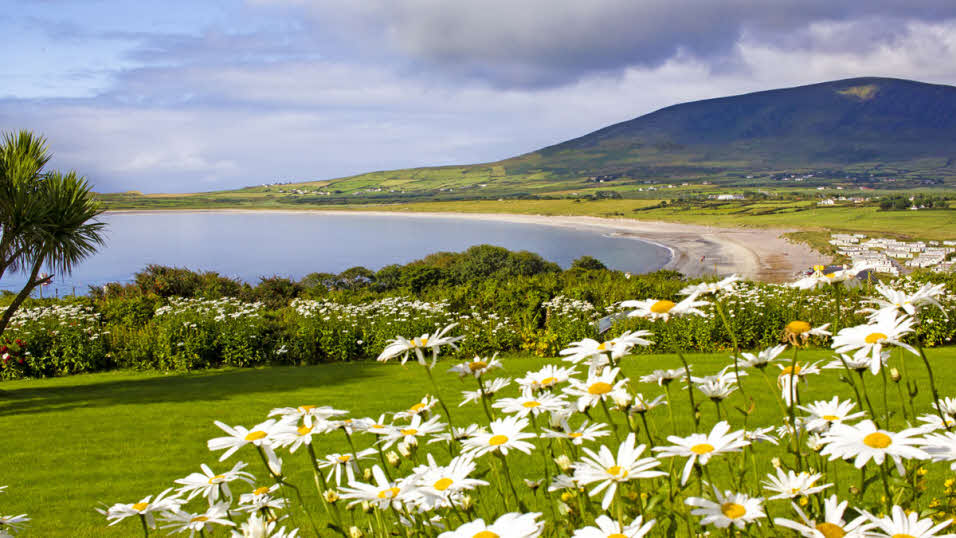
Your first stop should be Dublin, enjoy a Guinness or two in the lively city centre and then take the short drive south to the Wicklow Mountains – be sure to climb up Kippure, which sits at 2,484 ft.
Head south to Cork for spectacular views of the Mizen Peninsula – oh, and don’t forget to kiss the Blarney Stone before you leave.
Drive north in your caravan or motorhome to the smaller cities of Limerick and Galway, you’ll be blown away by the rugged coastal scenery on the way.
We recommend that you book a stay at the following caravan sites in the Republic of Ireland – all have been inspected by us – so you can expect high standards.
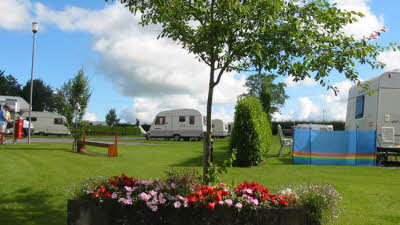
Blarney Caravan & Camping Park
Overseas site
Total pitches: 70
No. touring pitches: 40
Open 28 Mar 2024 to 28 Oct 2024
- Peaceful stays
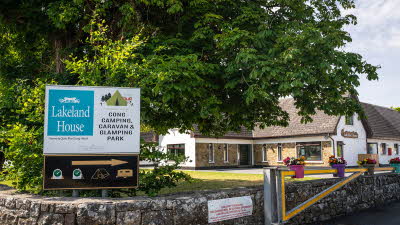
Cong Camping and Caravan Park
Total pitches: 30
No. touring pitches: 10
Open 29 Mar 2024 to 29 Sep 2024
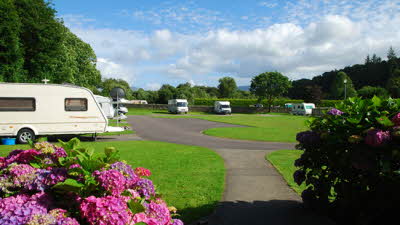
Fleming's White Bridge
Total pitches: 92
No. touring pitches: 72
Open 27 Mar 2024 to 28 Oct 2024
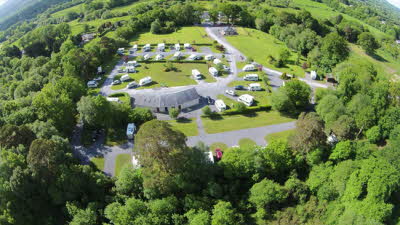
Glen of Aherlow
Total pitches: 48
No. touring pitches: 48
Open 26 Mar 2024 to 29 Sep 2024
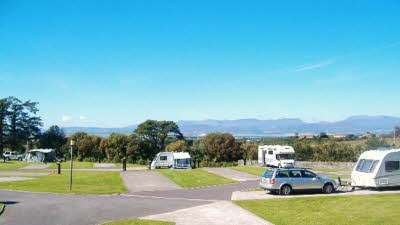
Glenross Caravan and Camping Park
Total pitches: 37
No. touring pitches: 25
Open 12 Apr 2024 to 01 Oct 2024

Lough Arrow Touring Park
Total pitches: 31
No. touring pitches: 26
Open 13 Mar 2024 to 01 Nov 2024

Nagles Doolin
Total pitches: 99
No. touring pitches: 85
Open 12 Mar 2024 to 01 Oct 2024

River Valley Caravan Park
Total pitches: 190
No. touring pitches: 137
Open 15 Mar 2024 to 30 Oct 2024
Sites key: Overseas Site
Did you know you can save money when you book your crossings, campsite or overseas site night vouchers together? You’ll also save time and the £20 booking fee* if you book online.
BOOK A HOLIDAY
*A £20 booking fee applies to European holidays (crossings, campsites and Overseas Site Night Vouchers) which are booked over the phone via our Contact Centre. The fee does not apply when a trip includes holiday elements which cannot be booked online (eg: escorted tours, campsites that are on request etc).
At a glance.
When to go: summer Don’t miss: Blarney Stone Motorway speed limit: 50mph (caravan) 74mph (motorhome under 3.5t) 50mph (motorhome over 3.5t) Driving tip: get a good GPS
Useful info
Know before you go
- Driving tips
- Travelling with pets
- Legal requirements
- Irish Tourist Board
Top questions
How do i book an overseas site.
Overseas campsite bookings can easily be made on the Club website and "combined deals" are common when you book a campsite at the same time as your ferry crossing. Booking online means you save the £20 Contact Centre booking fee.
Does the Club take deposits for overseas bookings?
Yes, deposits for overseas bookings are calculated at 20% for a site and 25% for a ferry (unless it is a non-refundable ferry/Eurotunnel in which case full payment is due at time of booking). The final balance is due 10 weeks prior to travel.
Is the standard of overseas sites similar to that of the UK?
European campsites are star-rated by their own local authorities and can have different standards and regulations to the UK. However, the Club's travel team handpick and inspect our campsites so that members can be sure of a high standard.
This is my first visit abroad with my caravan/motorhome. How can the Club help?
The Club's first time abroad section explains everything you need to know about going on your first overseas touring holiday.

Motorhome Ireland: 8 Things We Learned
We’re recently back from a cracking four-week, self-guided motorhome tour of the Republic of Ireland. We focussed on the south-west of the country, taking our time to explore the southern end of the Wild Atlantic Way.
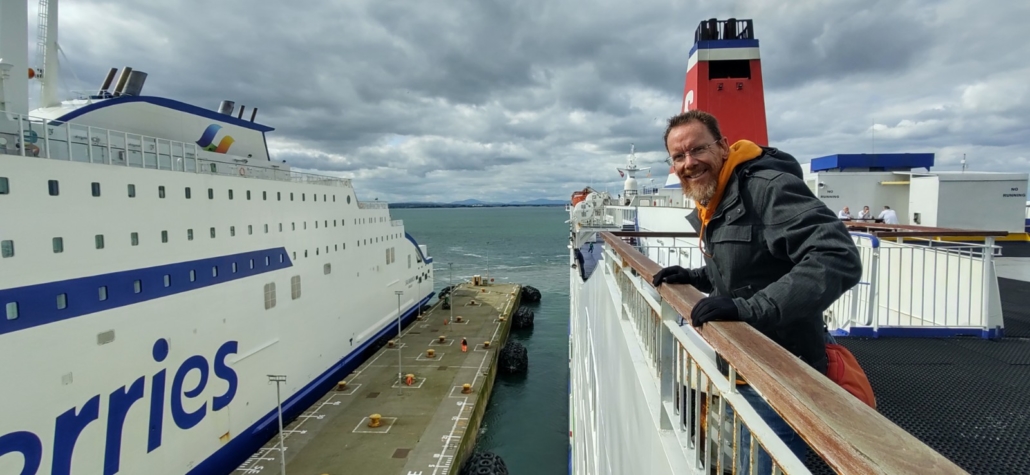
Although we’ve travelled across much of Europe, this is the first time we’ve visited Ireland in our motorhome, and we were taken aback by just how much we enjoyed it. We learned a few things on this trip too, which we wanted to share with anyone thinking about taking their motorhome to Ireland. At the bottom of the post you’ll also find a round up of our costs which may help you to plan a similar trip.
1. A Month Wasn’t Enough
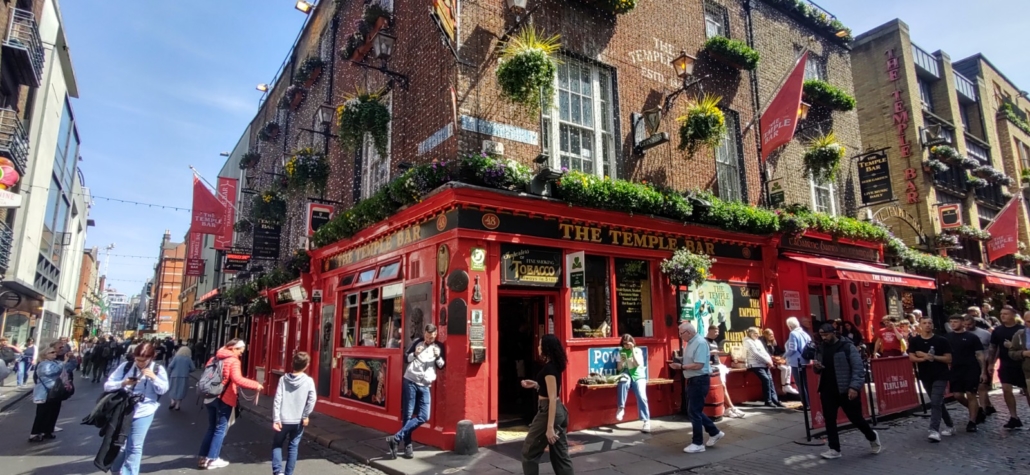
We needed to come home for personal reasons at the end of our four weeks, but we could have easily spent another month or two touring Ireland. We didn’t see any of Northern Ireland, spent only a few days inland, and got tons of recommendations for the more northerly parts of the Wild Atlantic Way, which we’d no time to explore.
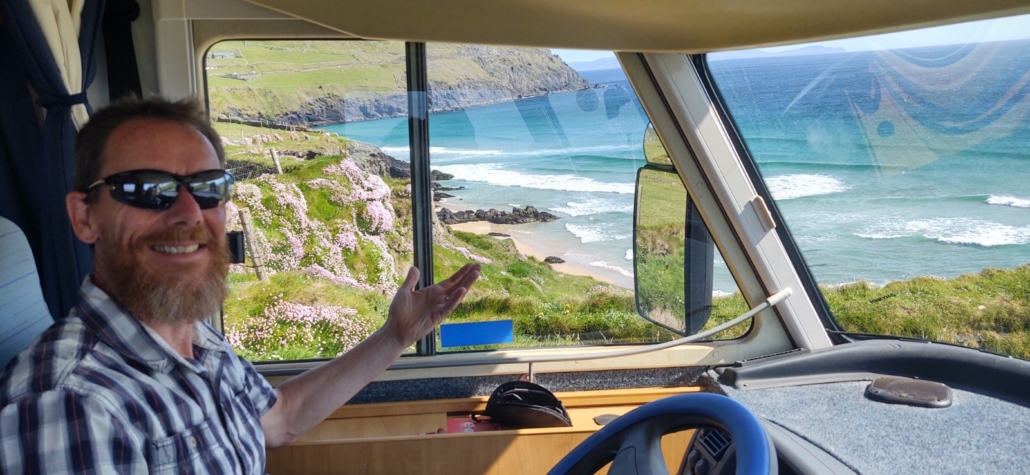
The weather in May was beautifully warm, and the overnight parking locations had enough space for us. Ireland has about 1/4 the population density of the UK. It felt much more laid back, with a slower pace of life and more easy-going attitudes on the roads, at campsites, in the pubs, for parking and life in general.
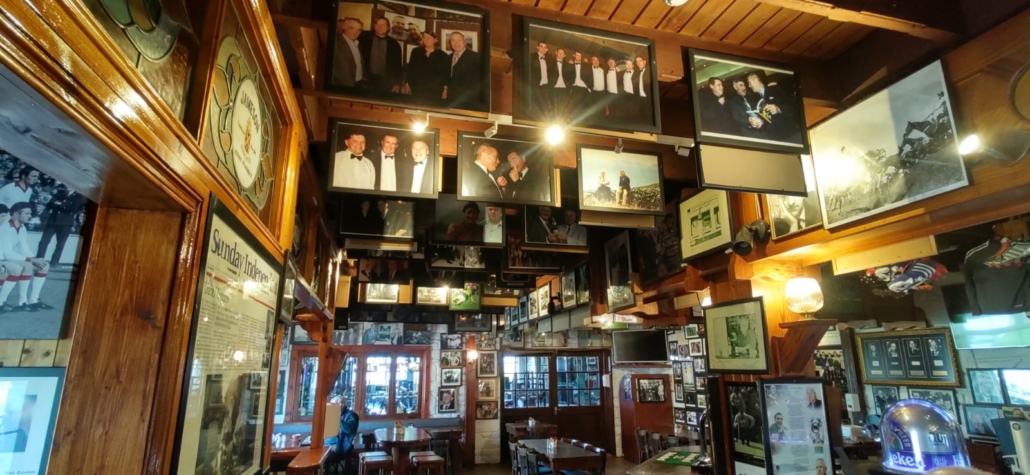
The point is: there’s an awful lot to see and do in Ireland, especially if you’re into slow travel. It you enjoy hiking in the mountains, like visiting castles and ancient forts, don’t mind a Guinness or two in characterful pubs, exploring frenetic cities like Dublin and generally kicking back, you’re in for a treat.
2. It Felt Abroad!
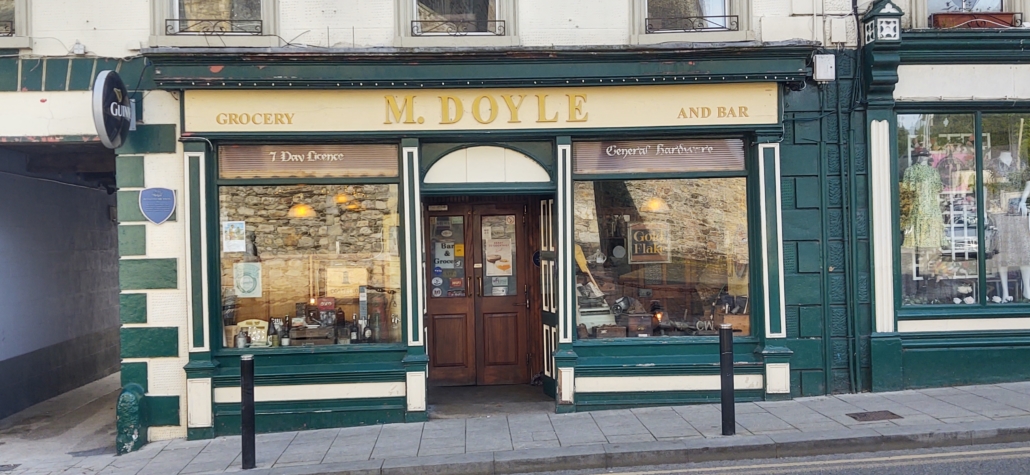
Alright, this might sound a bit weird, but without really thinking about it we’ve seen Ireland as not being as ‘abroad’ as say France or Italy. They drive on the left over there, and everyone speaks English. In Northern Ireland they even use the pound, and the speed limits are in mph. As UK citizens, we don’t need to show our passport to enter the island of Ireland. So, it’s all pretty much like Britain, right?
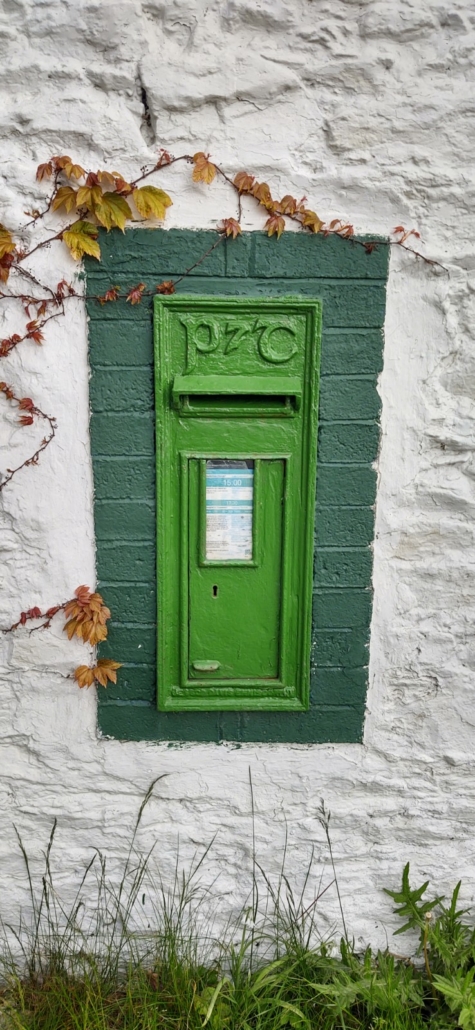
Ah, no. It didn’t take long to start to grasp the fact The Republic of Ireland at least is very much not Britain!
The post boxes were all repainted from red to green back in the 1920s for a start. A deliberate act to show just how ‘un British’ those in the new Irish Free State (later to become the Republic) felt themselves. The speed limit signs have the letters km/h written on each of them. There are statues and memorials everywhere to local heroes killed fighting for independence from the British. All the signs are in both English and Irish. And the hurling sticks are everywhere too!
Go to the Republic and even without reading up or popping into a museum or heritage centre, and you’ll soon get a good grasp of the fact this is far from Britain.
3. There Were Tons of Overnight Options
We stayed in pub stops, dedicated motorhome parking areas, aires, campsites and wild camping spots in Ireland. We were touring during May, so campsites which might close over winter were all open.
Many of our stops were free, and the stops we paid for were all well worth it. Car parks were either free or about €10 for 24 hours. Campsites ranged from €15 to €38.50 a night for two people, the higher price was with hook-up. Sites were generally very relaxed about the time we left our pitch on departure day. Other motorhome travellers wild-camp every night in Ireland, never paying for a night in a campsite or aire.
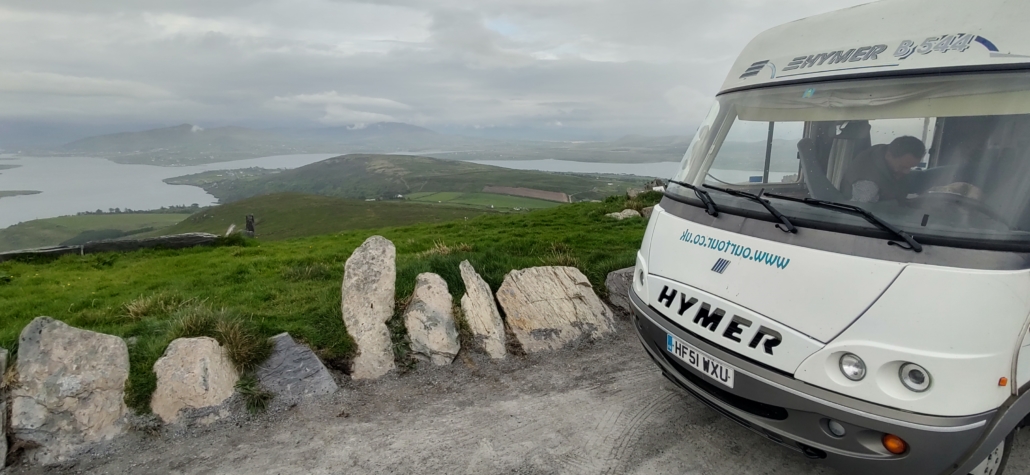
We sourced all of our locations from the park4night app , and they’re shown on the interactive map below. Just click on any stopover location for the GPS co-ordinates and a link to the blog post we wrote while we were there.
4. The Landscapes Are Epic
We once stayed for a few weeks in Nerja (Spain) next to a Swedish couple who spoke very highly of the Wild Atlantic Way. They’d made a book, with fantastic drone-shot photos of the coast. The pics were great, but couldn’t do the place justice. Neither can our pictures below. You have to go see it with your own eyes, feel the wind from the sea, hear the crashing waves and get a sense of scale from atop the giant cliffs.
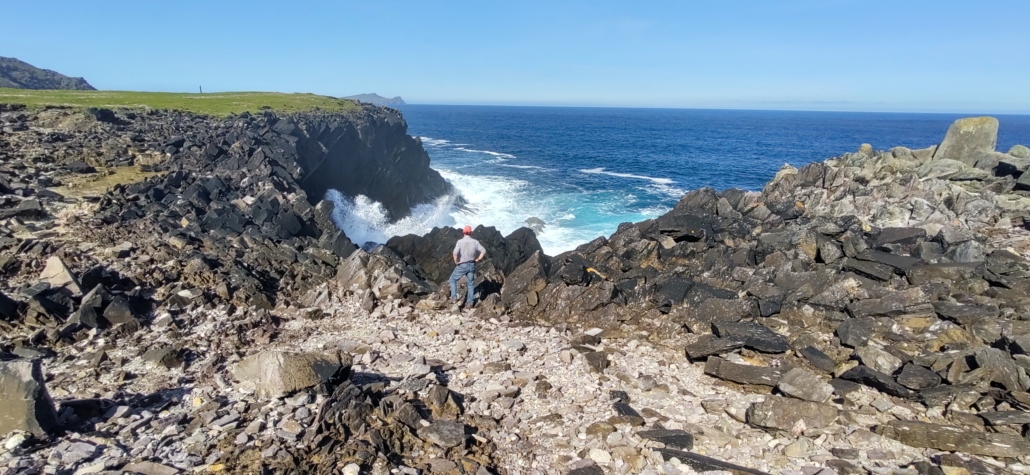
It’s quite a place, and that’s just the coastline. We didn’t spend much time inland, but when we did we drove over beautiful mountain passes and parked by a huge inland lake.
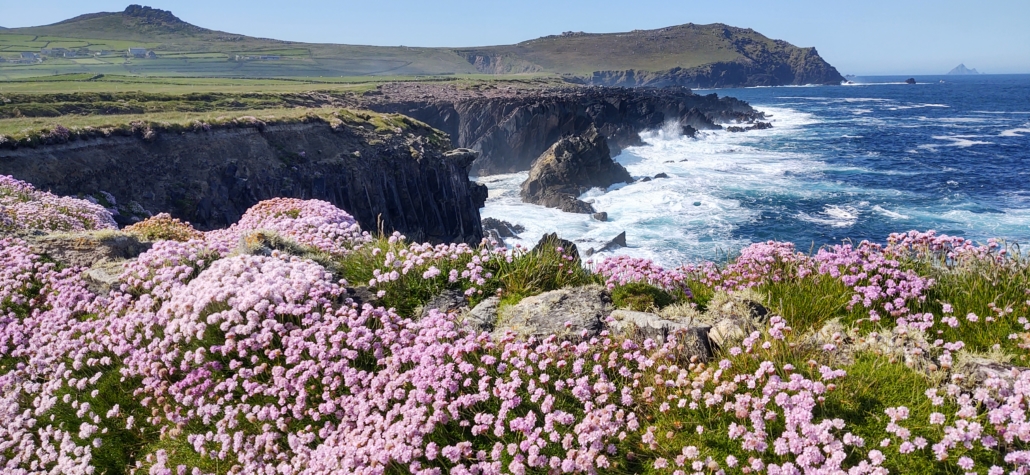
5. Only the Disposing of Rubbish Was Awkward
With Lidl, ALDI, SuperValu, Centra and even the odd Tesco spread around we’d no trouble buying groceries. There were enough LPG refill places (we only filled up once in Killarney) and we found there were sufficient aires, service points and campsites open in May to allow us to easily service the van. Some petrol stations and supermarkets have washer-dryers outside, making clothes washing easy. Disposing of rubbish in Ireland is a tad more difficult though.
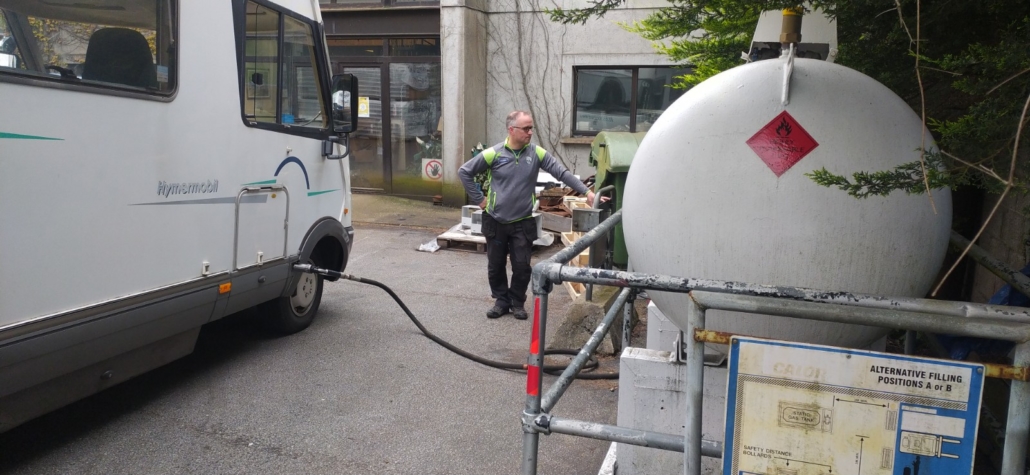
There are recycling points for glass and tins but not for plastic, cardboard or general waste. In the Republic the locals have to pay to dispose of each bag/bin of rubbish, so there are no large industrial bins knocking around town. You either have to squeeze your rubbish into a bin intended for litter (frowned upon and you could be fined if caught), go to a campsite which has bins (not all do) or pay for each bag to be taken at a recycling centre or some campsites.
6. The Roads Are, ah, Interesting
We used a few motorways in the Republic of Ireland and they were great quality and generally free. We used a couple of toll sections which only cost €2 each (you can pay by card or cash at the manned booths). We also paid for the toll bridge in Dublin to get to the port from the south (€1.70 in cash). There’s a section of the M50 around Dublin which has to be paid online, but we didn’t use it ( www.eflow.ie ). We also didn’t use the tunnel to Dublin port from the north, but heard it varies in price depending on the time of day up to €10.
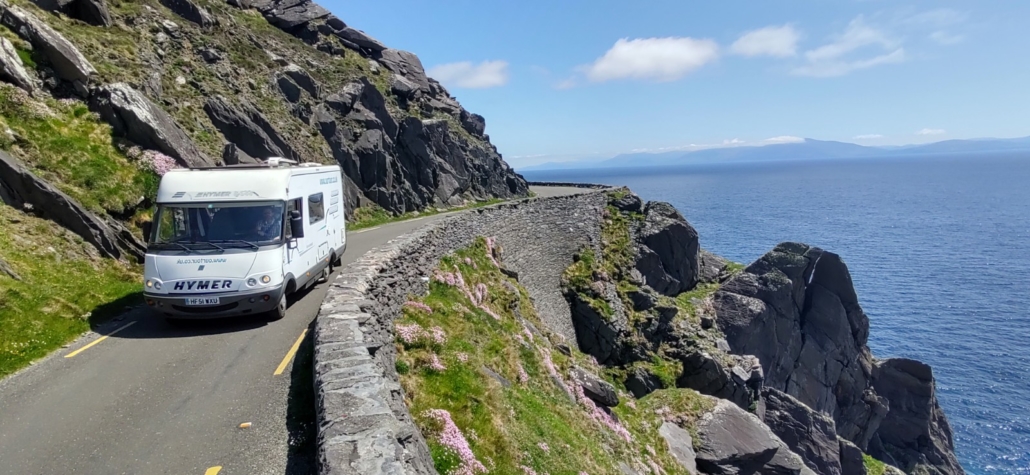
Away from the motorways, the Republic’s roads are classified as N (equivalent to a UK A road), R (like a B road) and unclassified roads (country lanes). Some of the R roads were hard work in a motorhome. They often have high hedges so you can’t see ahead, and are 80kph (around 50mph) so not exactly slow.
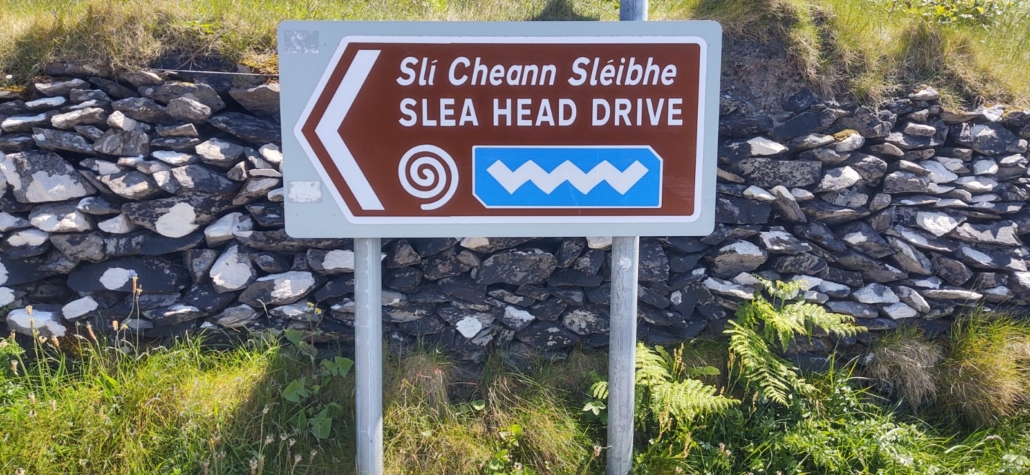
The small roads are no worse than similar rural roads in the UK to be fair, and out on the coast we found they mostly had very little traffic in May. On the relatively rare occasion we were holding up a car or two, we’d pull over where safe and let them pass. Invariably we were given a quick honk of the horn or a flash of the hazards as thanks.
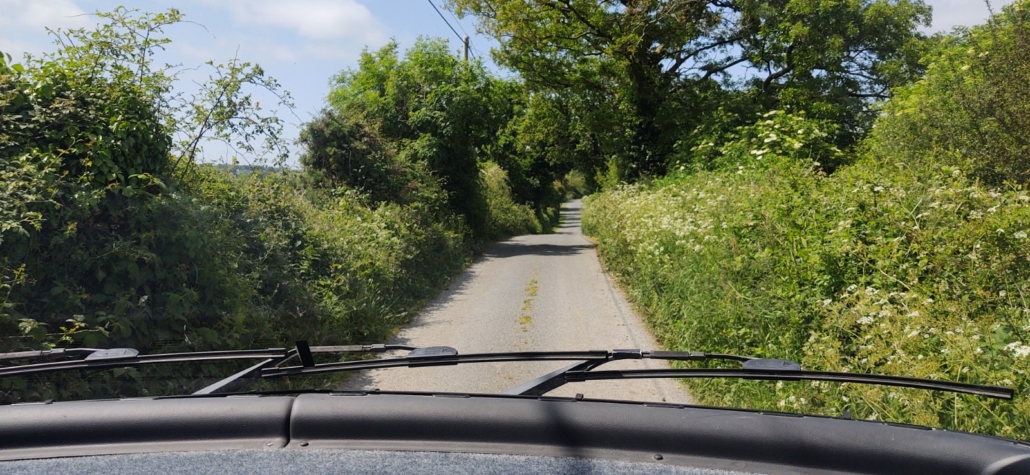
A few words of warning though folks: 1. Pack everything in tight, there are long sections of very rough surface, enough to shake your fillings from your teeth! 2. Drive the Dingle Peninsula clockwise to avoid long reverses in the face of full-sized coaches. 3. We were recommended to drive the Ring of Kerry anti-clockwise for the same reason, but we went the other way and had no issues, the roads are generally wider. 4. Don’t drive over the Gap of Dunloe or the Connor Pass unless you’re sure your van will fit!
7. There’s Fantastic Hiking, But Few Minor Trails
The Republic doesn’t have the same right of way system for walkers that we have here in the UK. There are top-notch, way-marked long-distance paths across Ireland, and we enjoyed a few short sections on them. But they’re not rights of way, the landowners have given permission for them to be used, there’s no legal right.
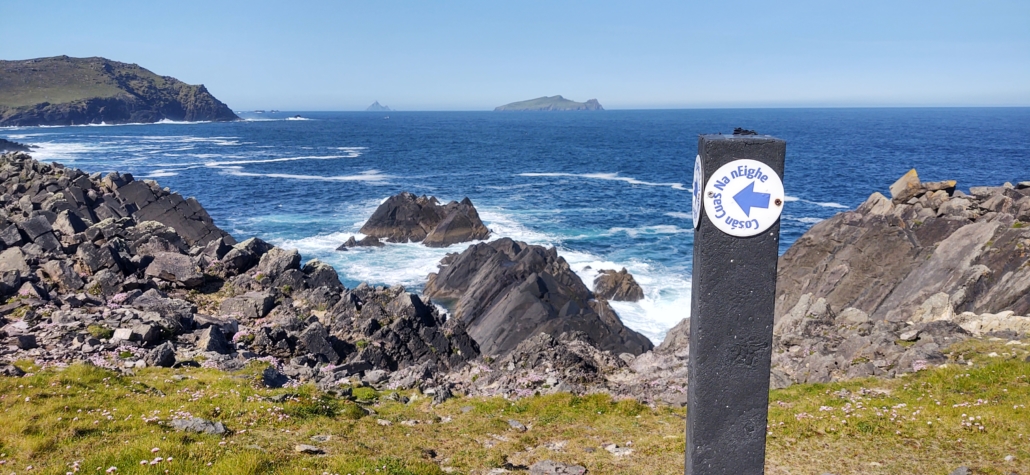
Away from these routes there are relatively few small trails and paths knocking about. We often found ourselves walking down busy roads to get anywhere away from the centre of a town or village, as there were often no pavements, or footpaths through the fields. There’s more info on walking in Ireland here: www.citizensinformation.ie/en/travel-and-recreation/sport-and-leisure/walking-and-rambling-in-ireland .
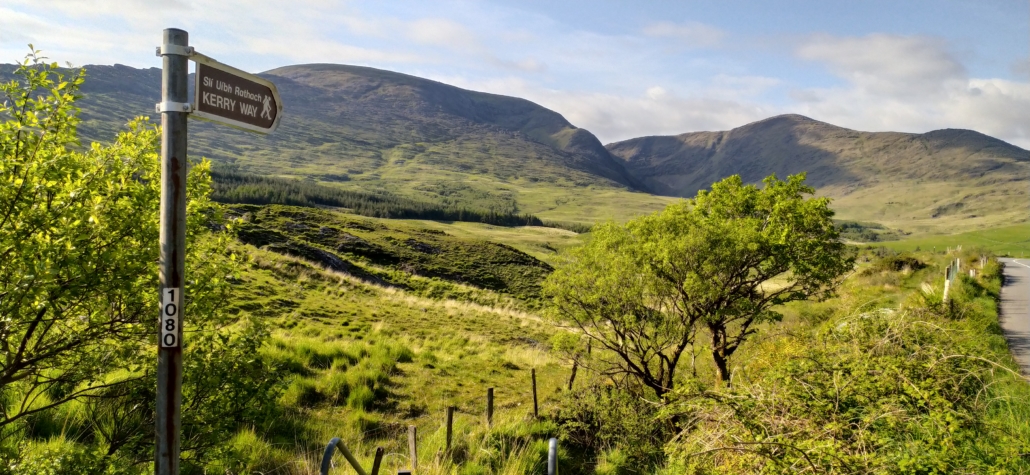
8. We Really Enjoyed the Irish Parkruns
Not for everyone, but if you enjoy the chance to get together with the locals for a free, safe, friendly 3 mile walk, jog or run, then Parkrun is well worth investigating. See the Ireland Parkrun site for information and locations: www.parkrun.ie . We did Parkruns at Kilkenny, Bere Island and Inch Beach, and all were memorable places with friendly locals to chat with.
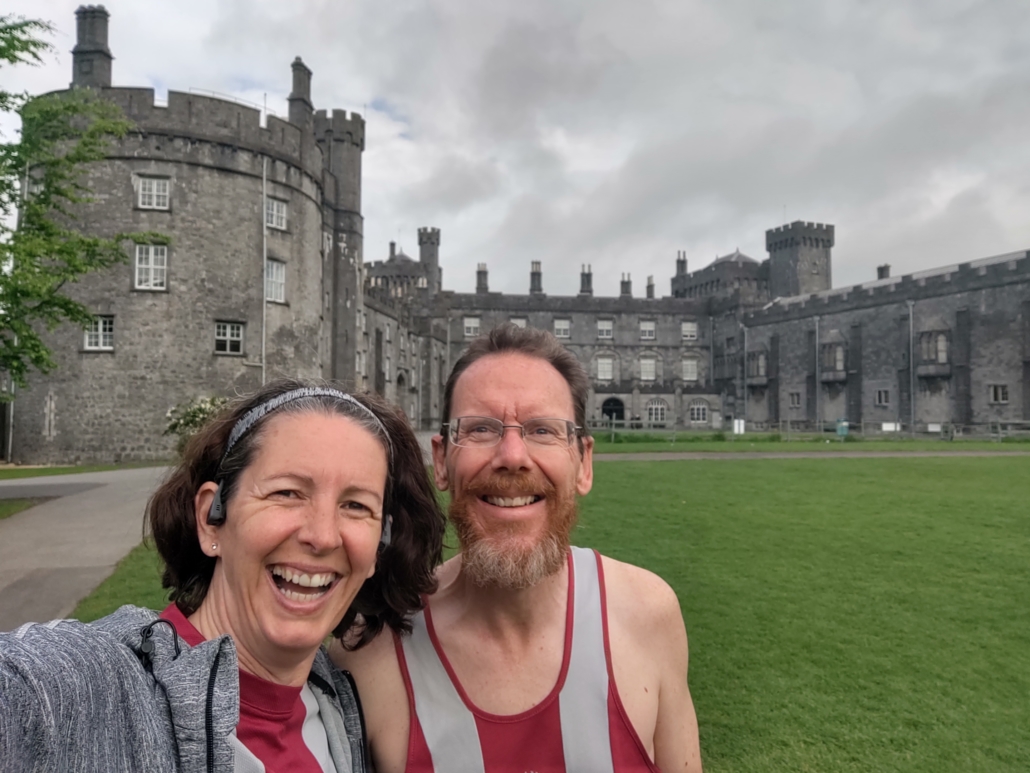
These take place every Saturday morning at various locations at 9:30am in Ireland (9am in Britain). You only need to sign up once on the website (for free) and get a barcode on your phone, or print it off. Bring it with you on the day and that’s it, nothing else to do, just turn up 10 mins before the start. Each event has a tailwalker or two who walks at the pace of the slowest person, so no-one gets left behind and you’ll never be last.
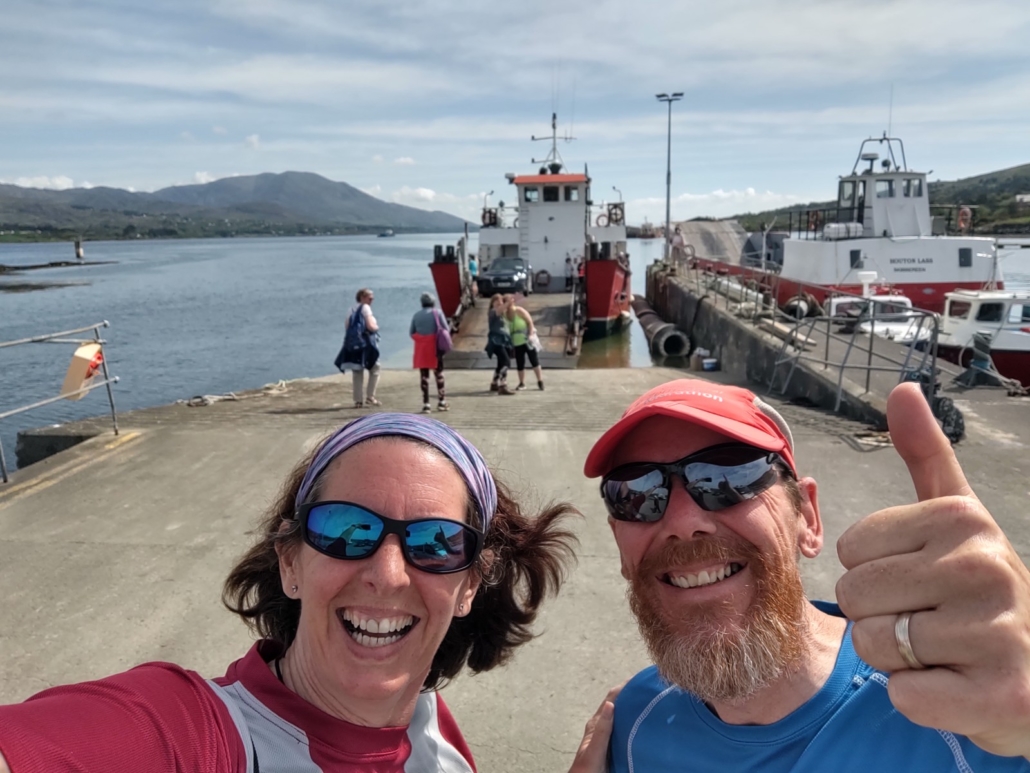
So, that’s our Ireland adventure done for now. It’s definitely a place we’ll head back to. Like a mini-Norway in places, but a lot closer to home! It also felt a little like the west coast of Scotland to us, with a rugged, remote feel while at the same time still being accessible to a motorhome.
The Money Stuff
Motoring From our home in Nottingham and back we covered just over 1300 miles (2100 kilometres). We filled up with diesel six times at a total cost of £344.54. We arrived home with an empty tank having used 259l of diesel. Fuel prices ranged from €1.449l to €1.509l (we used the pumps.ie website get an idea of prices in the area and filled up when we saw it cheap, not when we started to run low.
Overnight Stops 7 nights wild/free camping in Ireland and 1 in Wales (Fishguard by the ferry port) 2 nights in pub car parks (we bought meals for around €40 for two including drinks) 9 nights on paid aires (prices were around €10 a night, but some had services, others were pretty much just a car parks) 2 nights in a free aire/dedicated motorhome parking – no services 9 nights on campsites (prices ranged from €15 to €38.50 for a campsite in Killarney with hook-up, bins and laundry) 2 nights on Camping and Caravan club Temporary Holiday Site (£14.50 per night) in Anglesey, Wales as we didn’t want the trip to end.
In total we spent £379.94 on overnight stops (two of which included meals). An average of £11.87 per night.
Food We spent £257.74 in the supermarkets and £179.78 eating out (includes drinks, ice creams etc but not the two meals out which are included in the overnight stop costs). It felt like the supermarkets were more expensive than at home, which may have been due to the price being in Euros so look slightly higher. We tried to do most of our shopping at big supermarkets, but did the odd top up shop in small stores and petrol stations, all of which have a good range including hot food and ice creams.
Communication We bought an unlimited data SIM card from a 3 store for €20 the day after we arrived, which lasted us until we left Ireland.
Ferry Stena Line: Fishguard to Rosslare £204, Dublin to Holyhead £186. We booked both ferries a couple of weeks ahead of travel using the Camping and Caravan Club website which got us a flexible ticket for the price of an economy one. With hindsight, we’d probably just use the Dublin to Holyhead crossing both ways in the future and perhaps look at booking a return to see if we get it cheaper.
Other Big Costs Zagan’s leisure batteries started to boil on hook-up one morning, so we decided to replace them both rather than try to manage the rest of the trip on just one. Two x 75 amp hour batteries cost €320 (£279) quite a bit more than they would have cost in the UK.
Total Our 32 night trip cost a total of £2019.84 which includes two new leisure batteries. Without the batteries it was £1740.68 or £54.40 a night. We’re both really suprised how little our average daily cost has gone up since we toured Europe for a year in our motorhome back in 2016.
If you’ve any questions about touring Ireland by motorhome, please just pop ’em in the comments. We’ll answer them if we can folks.
Cheers, Jay
Good synopsis and pretty much our experience as well. Of course we’re still in the middle of it, and just starting the Dingle Peninsula this week. But yes… lots to see, and one month is not nearly enough. In fact we’ve already decided that we’re going to cancel our planned time in Scotland and head right to Wales from Dublin the way you did. By the way, we have some trash to get rid of…
Great blog Jay, thanks for sharing. We run a caravan at the moment but this article is further persuading me to find one of Zagan’s relatives to tour us around UK and Europe. Keep on touring and blogging mate.
Thanks Rob, big decision that, happy travels whatever you decide fella, Jay
Great “trip report”! Slán go fóill! Paddy
Cheers Paddy 👍
Thanks for a very useful blog. We are heading off to Ireland late August for 3 weeks – our first “big” trip since we bought our motorhome last year. We are going with friends who are very experienced motorhomers. Planning on a similar route to you but the other way round. Holyhead to Dublin then heading over to Doolin and working our way south. Hoping to fit in a couple of park runs along the way (just done Alvaston in Derby this morning!)
👍 happy travels and parkrunning Kay! Cheers, Jay
Hi, we are planning a trip to Ireland starting mid April for a few months we enjoy reading your blog and are looking forward to going, did you have to have continental breakdown cover and heath insurance for southern Ireland ? Thanks Hilary
Hi Hilary – our breakdown insurance was already in place and covered the EU, so we didn’t check but I would imagine UK cover won’t work in southern Ireland – worth checking with your insurer. We bought travel insurance for the trip which covered the EU. Cheers and happy travels, we really enjoyed Ireland. Jay
Leave a Reply
Leave a reply cancel reply.
Your email address will not be published. Required fields are marked *
This site uses Akismet to reduce spam. Learn how your comment data is processed .

Privacy Overview

7-Day Campervan Itinerary For Ireland
by wildandfree | Jun 28, 2019 | Ireland
Ireland is a country that needs to be explored by a campervan for many reasons. There are so many amazing campsites scattered around Ireland making it an idyllic place to camp. We got to live out our dream of “owning” a Sprinter Van thanks to @blacksheepvan and @retroventures !
We had one week to adventure around in their FIAT Ducato Adria Campervan Explorer . It was the perfect size for two people and even had a shower, toilet, and kitchen! It is crazy what they can pack into a 6-meter campervan. It has everything you could ever need!
We mapped out our 7-day itinerary around Ireland which covered over 700 miles. This route took us past all the highlights that western and southern Ireland had to offer.
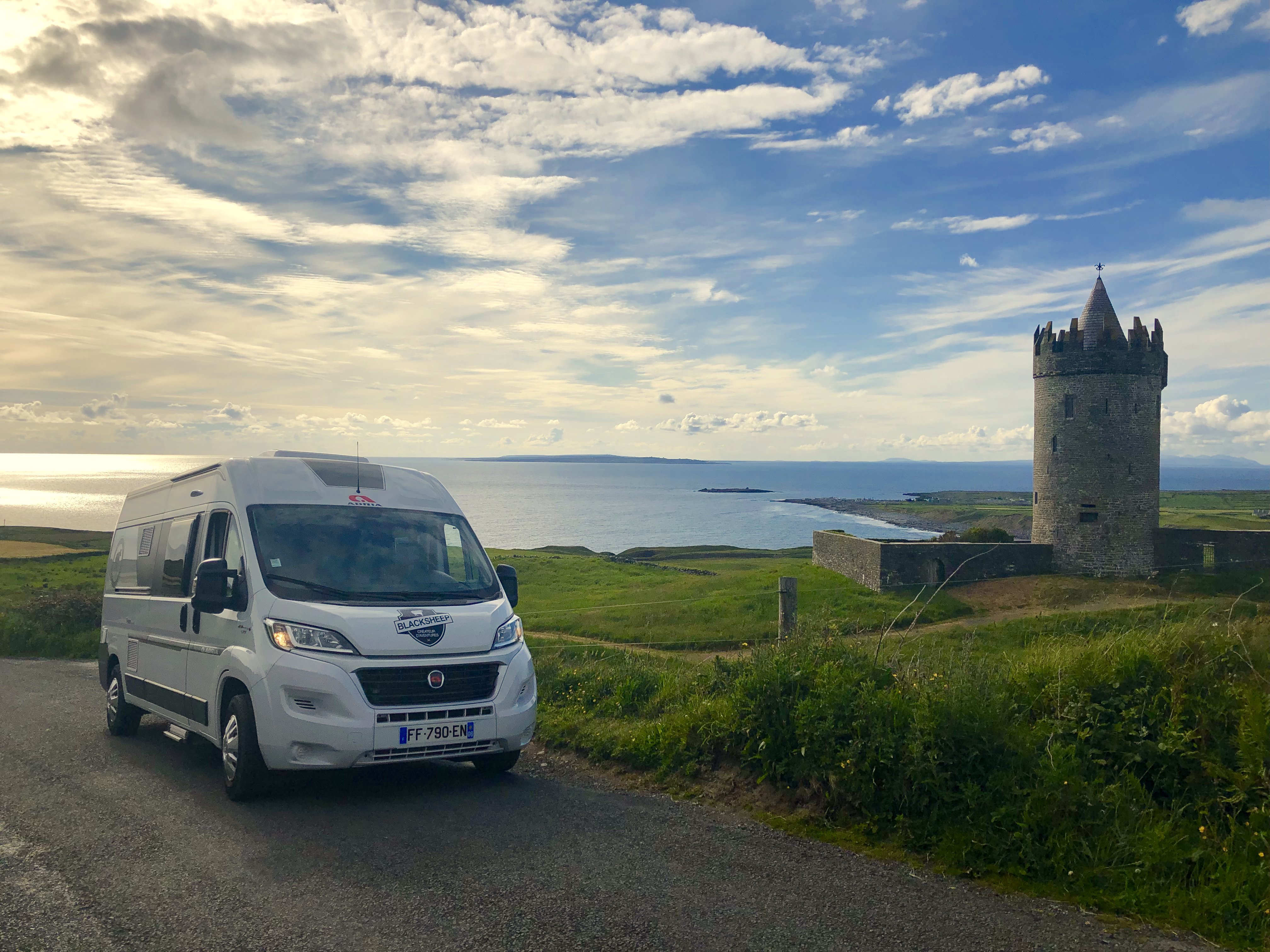
Day 4- It was a day of driving around in the campervan exploring Valentia Island , Portmagee , and the Kerry Cliffs .
Valentia Island is Ireland’s most westerly point located on the Wild Atlantic Way . There is a lot of beautiful nature to discover on the island. Not only is the nature diverse, but the island has a rich history as it was the birthplace of global communication.
This island is where the first successful transatlantic telegraph cable was laid between Ireland and Canada. This changed the way we communicated and is the reason for advancements in the telecommunication realm.
We crossed the bridge from Portmagee onto the island and drove up to the first viewpoint. It offered breathtaking views of the coastline and the Skellig Islands. This was the start of the Bray Head Loop which is a 2-hour circuit loop offering a breathtaking cliffside coastal hike. If you have time, I highly recommend taking a hike here if the weather is permitting.
The next stop was the slate quarry which dates back to 1816. This part of the drive was when the roads started to get narrower. Being in a transit van versus an RV really made the difference in being able to access some places. We found the transit to be compact for these small roads making it a lot easier to get around.
From the slate quarry, you can see the massive caves where they still mine slate today. There is also epic views of the coastline and lighthouse. We decided to venture down to the lighthouse next. This road was the smallest yet, but slow and steady wins the race. We are glad we decided to go down there as we found a beautiful spot to pull over on the ocean’s edge. We cooked breakfast (yum cheese toasties), played on the rocks, and checked out the lighthouse.
The island is pretty small and can be driven around in 2 hours or so with some stops along the way. We got back to the bridge to cross back onto the mainland and had built up an appetite.
We found street parking for the campervan in Portmagee and decided to walk down the colorful village. We found a pub and split a fish n chips and Guinness. No trip to Ireland is complete without having a shot of whiskey and a Guinness… Just saying!
Now, it was time to go hike off the food and beer. We headed about 15 minutes away to the Kerry Cliffs. There is a huge parking lot so no worries if you are in a campervan. It cost €4 per person to enter the cliffs and is totally worth it in our opinion. You hike 10 minutes uphill to the cliff’s edge and are rewarded with remarkable views. You can easily spend 1 hour here hiking around to the different viewpoints.
We were getting tired at this point as we’d seen and done a lot today! We headed back to the campsite and planned on cooking dinner to the sunset views. We just loved this camp site’s view. We lucked out another day of good weather and got to watch the sun duck below the green grassy meadows and bay.
Day 5- We kept heading along the Ring of Kerry road today to our next campsite, Wave Crest Caravan and Camping Park . It was only a one-hour drive from our previous site. We decided to check into our site that morning to save a spot for later and grab the gate key. We scored another amazing camp spot with more epic sea views!
Our plans for the day was to head through Killarney National Park to the town of Killarney. This took drive was scenic, to say the least, with grassy and rocky mountains in every direction. Some must-see places in Killarney National Park are Torc Waterfall, Ladies View, Ross Castle, Kissane Sheep Farm, and Muckross House.
We spent about an hour at Torc Waterfall and an hour at Kissane Sheep Farm . The sheep farm was a cool experience to see how the farmers shear the sheep and how the cattle dogs do their daily work. The dogs could be controlled by a low whistle from the farmer telling it which direction to go next. This was worth the €7 to see. We even got to pet some adorable sheep!
We got to Killarney just in time for dinner. We found a gastropub called Celtic Whiskey Bar & Larder. They had the biggest selection of whiskey I’d ever laid eyes on. The server said there were over 1500 different types… We opted for the fillet steak and it was the perfect tenderness. It is exactly what was needed after a long day of exploring.
We had a bit of a drive ahead of us to get back to the campsite. We were hoping to make it back before dark. Luckily, made it back to our site with about 10 minutes to spare before nightfall. We had a successful day and were excited to wake up to the ocean views in the morning.
Day 6- We planned to finish off the Ring of Kerry road today and headed to our next campsite, Eagle Point Camping. We left midmorning in order to make it to the town of Kenmare for lunch. This colorful town is located at the head of Kenmare Bay. There are tons of boutique galleries, craft shops, and good-quality restaurants. It is a great town to take a stroll in and grab a bite to eat.
We kept heading south to the town of Reendesert. This peninsula town is where our next campsite was. It again offered amazing bay views! We arrived and set up our chairs and tables outside on our little grass patio overlooking the water.
We then whipped out our disposable BBQ, which we have found quite convenient in the past, to cook up some pork chops and veggies. A sunny day, ocean views, plus a BBQ is the best way to spend any day. We enjoyed the sunset from the campervan and called it a night as we were getting up to drive to Blarney Caravan and Camping Park the following day.
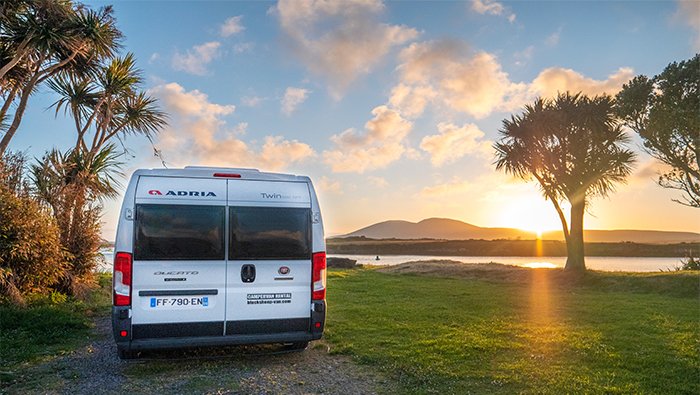
Day 7- We knew a visit to Ireland wouldn’t be complete without visiting the Jameson Distillery . We booked our tickets online the day before so that we could hop on the first tour of the day at 11 am. We had a 1.5-hour drive from our campsite to the distillery. This drive took us through Ireland’s green countryside just east of Cork to a town called Midleton.
The distillery tour took a little over an hour and ended with samplings of different whiskeys. Included in the tours ticket was also a free spirit at the end in the Jameson’s Bar. This is where we found our favorite Irish drink. Jameson with ginger ale and lime. Try it and thank me later. We were really impressed with the tour and found it was worth the money. There is also campervan parking in the parking lot next door to the distillery. There were signs up saying you could camp there up to 48 hours for free.
After the distillery tour, we wandered around the area, grabbed a coffee, and headed for campsite number 5. This sadly was the last campsite of our trip. It was close to Cork and Blarney Castle which we planned to explore.
The evening was spent walking around the very small town of Blarney. We went to the local pub, which was old and beautifully designed and grabbed one last Beef and Guinness stew before we left. It by far was our favorite Irish meal.
We had an early night as we planned on waking up at the crack of dawn to make the most out of our final day in Ireland.
Day 8- We didn’t want to have to take the campervan back today. We were definitely in love with it and the size, plus the compactness of it. We feel if we were to ever buy one, this one would be the one! Our flight wasn’t until 7 pm so we had all day to make it back to @retroventures shop. We drove into Cork mid-morning and was able to find street parking a couple of blocks outside of the main area. We had a wander around and found a Texas BBQ place called White Rabbit Bar & BBQ. Since we hadn’t had any good BBQ in over 5 months, we thought it was worth a shot as it sounded delicious.
It was average but had me dreaming about being back in Texas. Nothing compares to Texas BBQ, but it held us over until we could return to Texas.
We were debating at lunch about going to Blarney Castle, but the price and the weather deterred us. Instead, we visited Blackrock Castle Observatory which was free to view from the outside and a neat castle on the river. After this, we started our one-hour drive back to @retroventures shop which is located near Limerick. We saved the last two hours before returning the campervan for packing and cleaning. In all honesty, it only took about 30 minutes to do this as we kept our luggage to a minimum and tried to keep the camper as clean as possible. It was easy to do as it is a small space. We had to say goodbye to our home on wheels to catch our flight back to London.
We found Ireland to be a beautiful country with very friendly locals, great food, and amazing unspoiled nature. We want to give a huge thanks to @BlacksheepVans and @RetroVentures for making our adventure possible. We highly recommend getting around in a campervan in Ireland as there are so many amazing campsites and places to visit.
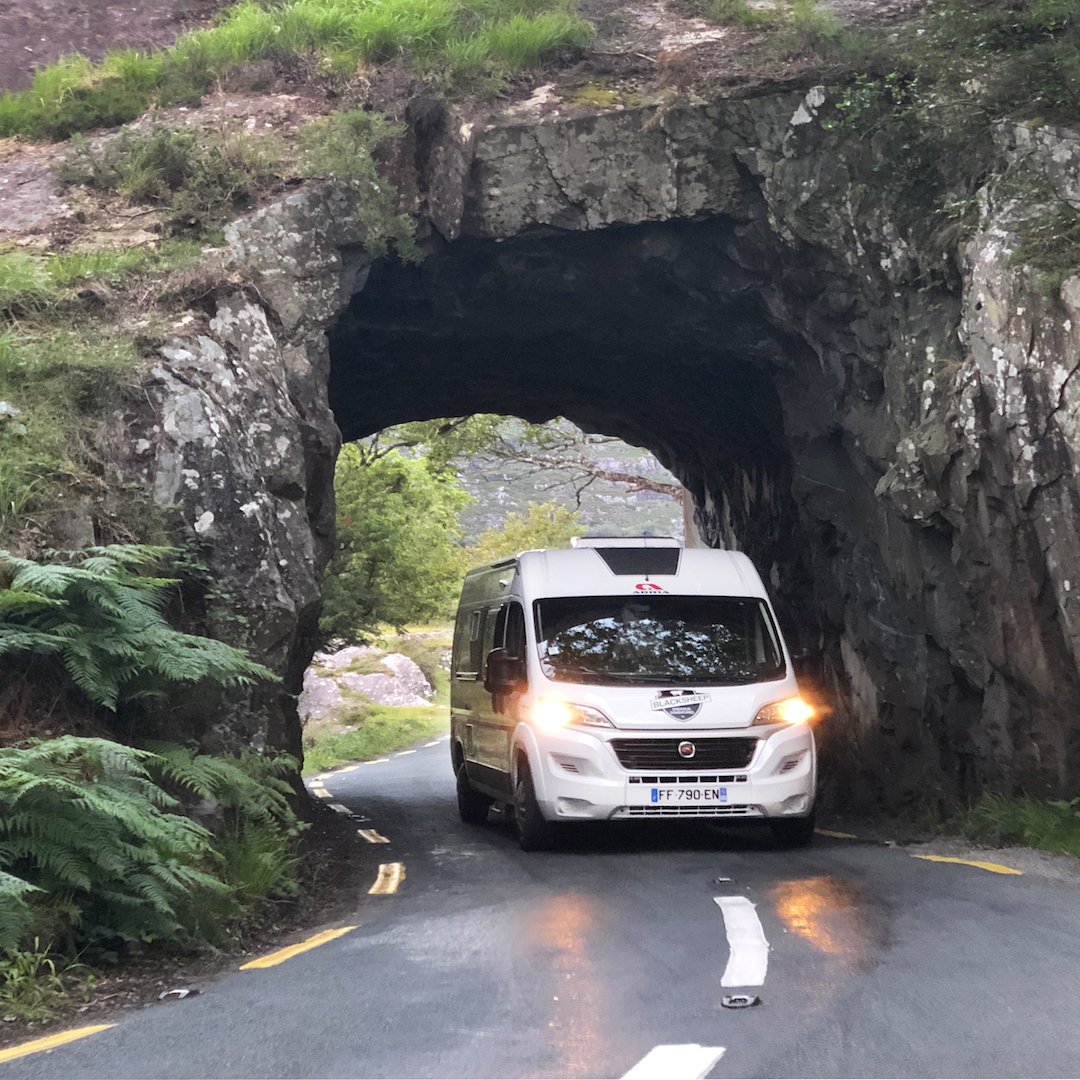
Are you sure you want to leave the feed?
Oops... something went wrong!
Looking for inspiration? Planning a trip? Or just want to scroll yourself happy? We'll show you an Ireland that's tailor-made for you.
- #Landscapes
- #CultureandHeritage
- #OutdoorActivities

Oops... no internet connection
While offline, you can still add items to My board. New travel reccomendations will only show up once you’re back online.
See what Ireland has in store for you
Items without a physical location are not shown in map view.
Looks like your board is empty
Look out for the little heart icon around Ireland.com. Simply tap the heart to add items to your board!

Board settings
Collection cover image.
Visible to people you share your board with

Share board
Share a link to your My Ireland board and inspire friends, fellow travellers and family. Only you can add or remove items from your board.

Sign in Sign up Forgot your password?
Create an account.
Access My Ireland across all your devices by logging in.
Sign up Not got an account?
Terms of use | Privacy policy
Login Got an account?
Location access
- View offers and deals nearby
- Find travel inspiration based on your location
- Get local weather forecasts and essential information
Enable location access
Location access on ios.
- 1 Open the website settings for this website in your browser.
- 2 Select Location settings.
- 3 Choose Allow.
- 1 Open the My Ireland website.

- 2 Select the icon below.

- 3 Select Website Settings.

- 4 Change Location status to Allow.

Notifications
Travel times.
Tell us when you are travelling to Ireland and we'll show you tailored reccomendations during of your trip.

- Recommended events during your stay
- Helpful travel reminders and updates
You have unsaved changes. Save before leaving?
We take your privacy very seriously and only ever process your data with your permission. If possible this is handled anonymously and we will never store your data for longer than is required. For more information on how we handle your personal data, please read our privacy policy.
Remove data
To securely remove all data associated with your profile, please contact our Data Protection Officer.
Reset your board
This will remove all the items you have previously liked from your board. Please note, you can’t undo this action.
Are you sure you want to reset your board?
- Created date 19 July 2023
Delete account
Sorry you’re leaving. Just a reminder – if you delete your account, you won’t be able to post in Community. And it’s permanent so you can’t undo it in the future.
Delete your account
- No. Keep my account
- Yes. Delete my account

5 campervan journeys around Ireland
Experience the best of Ireland’s scenery on your campervan adventure around Ireland
Five campervan road trips around Ireland
Take to the open road and experience some of Ireland’s rugged natural scenery
- #CaravanandCamping
- #GettingAround

Ireland in your inbox
Sign up to receive free email newsletters from Tourism Ireland, including regular tailored updates on holiday ideas and insider tips.
We will use your email address to send you personalised content straight to your inbox based on how you interact with this website and our advertisements on other websites.
Something went wrong...
Success! Thank you for subscribing to our Newsletter!
I understand that by signing up, I will receive personalised email content based on my use of Tourism Ireland’s website, emails and Tourism Ireland’s advertising on other websites, cookies and tracking pixels. You can unsubscribe at any time by clicking 'unsubscribe' in our emails. Find out more information on "How we handle your personal data" in our privacy policy .
If you like the idea of taking to the open road without a set itinerary, enjoying early morning swims and watching sunsets on headlands before falling asleep to the sound of waves or under the stars, then a road trip in a campervan is the ideal holiday. Best of all, you get everything – transport, accommodation, cooking and washing facilities – all in one.
Wild camping is not allowed in Ireland unless you have permission from the landowner, but most areas have designated camping grounds and there are usually plenty of rest stops and viewing points along the way. To find local legal camping places for you to spend the night, check blogs and websites such as Total Camping , Safe Nights Ireland or the Campercontact app.
Driving is on the left in Ireland and larger campervans might want to keep to motorways (prefixed with an M, such as M1), national roads (prefixed with N in the Republic of Ireland, A in Northern Ireland) and regional roads (prefixed with R in ROI and B in NI) and avoid roads which are smaller than these. In high season during the summer months (July and August or local festival times), book your overnight parking spots in advance.
So where should you go? Here is our campervan itinerary for Ireland for some great road trips:

Five Fingers Strand, County Donegal
For a more remote drive, the Inishowen Peninsula in Donegal will bring you to Ireland’s most northerly point at Malin Head. Start by visiting the hilltop fort of Grianán of Aileach for scenic views in all directions, before taking the road north to the town of Buncrana, to stock up on supplies.
Smaller campervans can take the road to Dunree Head, to explore the fort and beaches before driving onwards through the stunning Gap of Mamore (with some twisty roads) for views over Inishowen and Lough Swilly, while larger campers might prefer the main road to Clonmany.
Stop at the Isle of Doagh for the Doagh Famine Village and views of Five Fingers Strand. The small Binion Bay Caravan Park in Clonmany is a handy overnight spot – walk to a nearby beach for a morning dip. At Malin Head – a Star Wars filming location – enjoy Atlantic views and scenic walks along the north west headland. Travel back along the coast for the beach at Stroove and the Inishowen Maritime Museum & Planetarium at Greencastle – which might give you more knowledge for stargazing at night from the campervan.

Causeway Coastal Route
© Shutterstock
Northern Ireland’s Causeway Coastal Route is one of the world’s most scenic drives, with this north coast full of castles and glens on one side and dramatic cliffs and bays on the other. Soak up the sea air on The Gobbins path on Islandmagee, with rocky caves and bridges. Spend a few hours at Glenarm to visit the forest, river and Glenarm Castle and make your overnight stop the campground at Glenariff Forest Park , to enjoy woodland walking trails and waterfalls.
Don’t miss the scenic fishing villages of Cushendun and Cushendall, plus the campground at Cushendall Holiday Park. Further north you will come to some of most dramatic features of this drive, with the rope bridge across a gorge at Carrick-A-Rede and the 40,000 basalt columns at the Giant’s Causeway itself. Lookout for the cliff-side ruins of Dunluce Castle and Game of Thrones filming locations such as Ballintoy Harbour and Downhill Strand.

Connemara, County Galway
A coastal trip through Connemara from Galway will bring you past a jagged coastline filled with beaches, inlets and villages, with plenty of scenic picnic stops. Driving inland, you will see blanket bog, miles of stone walls and the Mamturk and Twelve Bens Mountain Ranges. Take the coast road all the way from Galway to Clifden, visiting the village of Roundstone for seafood chowder or to pick up a bodhrán drum at Roundstone Musical Instruments for some evening entertainment.
Clifden is a good town for supplies – fall asleep to the sounds of the waves at Clifden Eco Beach Camping , a carbon-neutral campground with a magnificent setting on a beach with sand dunes near Claddaghduff, or Renvyle Beach Caravan and Camping park further north.
Spend a day in Connemara National Park for walks, mountain hiking trails and to see wildlife and birdlife. Driving back towards Galway, take the turn at Maam Cross for Oughterard to stop at the shores of Lough Corrib, before ending at Galway city for live traditional Irish music.

White Island, County Fermanagh
The Fermanagh Lakelands are a relaxed area to explore by campervan any time of the year, with scenic drives and viewpoints around the waterways of Lower and Upper Lough Erne, as well as natural wonders, forest parks and stately homes. Visit the Marble Arch Caves for an underground boat trip through limestone caves formed 330 million years ago, stroll the grounds or take an interior tour of stately home Florence Court or take a boat trip from the town of Enniskillen to Devenish Island to see the monastic ruins.
Stop overnight stays at Castle Archdale Caravan Park on Lower Lough Erne, where you can enjoy evening walks on the forest trails, or Riverside Farm, Marina and Caravan Park two miles outside the town of Enniskillen.

Slea Head Drive, County Kerry
To enjoy some of Ireland’s rugged Atlantic coastal scenery and the culture and traditions of an Irish-speaking Gaeltacht area, the Dingle peninsula in County Kerry is the place to go. Your first stop might be at Inch beach, which stretches 5km out into Dingle Bay with views of the MacGillycuddy’s Reeks mountain range.
It’s an ideal spot for walks or surfing. Stock up on supplies in Dingle town itself, also a good base for a whale-watching or dolphin-watching safari. Drive the peninsula clockwise, to Ventry and then Slea Head.
Take your time on the Slea Head drive, enjoying the views of the uninhabited Blasket Islands as you sweep around past Dunquin, stopping at the Blasket Centre to learn more. For an overnight stop, book your camping spot at Campail Teach an Aragail (Oratory House Camping) near Ballyferriter. Don’t miss the beaches at Castlegregory and Brandon Bay for golden sands, surfing and sunsets.
Where do you want to go?
Do you feel like tasting wild Atlantic sea spray on your lips? Strolling through vibrant city streets? Exploring ancient ruins? Right this way…
- Rentals USA
- Buy or Service a motorhome
- +44 (0) 1525 878000 [email protected]
- +44 (0) 131 560 1230 [email protected]

Ireland Motorhome Hire
Ireland has so much to offer as a holiday destination, from the stunning scenery of Connemara, Donegal and Kerry, to the wonderful cities of Belfast, Cork, Dublin and Galway. Hiring a luxury motorhome from Just go is a great way to explore the real Ireland, giving you the freedom to experience it’s beauty, charm and people.
Just go replaces its fleet every year, giving you a choice of modern 2, 4, 5 and 6 berth motorhomes that are all fully equipped and even include hot running water, shower, toilet and heating . A shower and toilet are standard on all models, offering maximum convenience for travellers not having to be reliant on-site facilities . All motorhomes have kitchens furnished with a grill or oven (dependant on motorhome model) a fridge, kettle, toaster, crockery, cutlery, pots, pans, cooking utensils and plastic tumblers. There is also a TV/DVD with a USB input and a stereo. Plus if you need to sleep off those pints of Guiness, then the comfy beds are perfect for a lie in!
Choose the perfect motorhome for your tour of Ireland
Our motorhomes range from 2 to 6 berth, each are listed below to help you choose your preferred vehicle to travel around Ireland. You may want to look at our exceptionally good value ‘Mystery’ motorhomes.
Mystery 2 berth
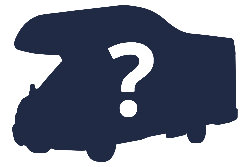
Voyager 4 berth

Pathfinder 4 berth

Wanderer 4 berth

Trekker 5 berth

Navigator 5 berth

Adventurer 6 berth

Mystery 6 berth
Reasons to choose just go to hire a motorhome in ireland.
- Ireland is an amazing country , and one that hides most of its’ natural beauty well away from the beaten track. Hiring a motorhome gives you the freedom to choose your own route and create your own unique Irish motorhome adventure
- If you tire of the ‘Craic’, then take a night off , as our motorhomes have entertainment on-board , with TV, DVD and stereo included* in your hire
- Use our 5 , 10 and 16 day itineraries to really get to know Ireland. The country has many hidden gems from the North down to the sunny South East. Once you’ve been to Ireland you’ll be heading back soon!
- If you’re new to motorhoming, then touring Ireland is a great introduction to driving a motorhome in a different country. They drive on the same side of the road as the UK, helping to prepare you for a motorhome adventure on further shores!
*Mystery vehicles may not have a TV
5 day itinerary
Starting at Holyhead, taking in Dublin, Galway, Kilkenny and returning to Dublin
10 day itinerary
Starting at Holyhead, taking in Dublin, Belfast, Londonderry, Donegal, Galway, Limerick and returning to Dublin
16 day itinerary
Starting at Holyhead, taking in Dublin, Belfast, Londonderry, Donegal, Galway, Limerick, Tipperary, Cork, Waterford, Kilkenny and returning to Dublin
Our 5 night itinerary

Need assistance creating a tour?
Call +44 (0) 1525 878000 to speak to our industry experts.
Night 1: Leave Just go – Holyhead
Overnight ferry then stay overnight in Dublin Campsite: North Beach Tourist caravan & motorhome park Pricing: Adults €10, Children €5, additional charge for electricity/showers
Suggested activity for the day: Dublin Guinness factory
Night 2: From Dublin – Galway
Campsite: Salthill Caravan Camping Pricing: Motorhome with 2 adults €28 + €6 for electricity
Suggested activity for the day: Sail in a 120 year old Galway Hooker , Out to Galway bay to view the coasts
Night 3: Galway – Kilkenny
Campsite: Nore Valley Park - Plenty to do for children Pricing: €13 per night
Suggested activity for the day: View history at Dunmore Cave
Night 4: Kilkenny to Dublin
Campsite: North Beach Tourist caravan & motorhome park Pricing: Adults €10, Children €5, additional charge for electricity/showers
Suggested activity for the day: St Patricks Festival, centre of Dublin
Late ferry back from Dublin to Holyhead & return to Just go the following morning between 8-10am.
Our 10 night itinerary

Night 2: Dublin – Donore
Campsite: Newgrange lodge hotel & camping park Pricing: €15 for night, €5 for electric & €3 per shower.
Suggested activity for the day: Barge trip on the canal
Night 3: Donore – Belfast
Campsite: Dundonald touring caravan park Pricing: €24 per night
Suggested activity for the day: General sightseeing including Botanic Gardens or for adventure Lets Go Hydro
Night 4: Belfast – Londonderry
Campsite: Elaghvale Camping park Pricing: Motorhome based on 2 adults sharing €20 per night
Suggested activity for the day: Tower Museum & St Columb’s Cathedral
Night 5: Londonderry – Donegal
Campsite: Knockalla Caravan & Camping Park Pricing: €25 per night based on motorhome for 4 people
Suggested activity for the day: Glanveagh national park & Castle
Night 6: Donegal – Galway
Night 7: galway – limerick.
Campsite: Adare Camping & Caravan Park Pricing: €27 per night based on 4 adults sharing + €4 for electricity
Suggested activity for the day: Aran Island Cruise
Night 8 & 9: Limerick-Dublin
Suggested activity for the day: Temple Bar & St Patrick’s day festivities
Ferry back from Dublin to Holyhead & return to Just go the following morning between 8-10am.
Our 16 night itinerary

Night 8: Limerick- Tipperary
Campsite: Parsons Green holiday park Pricing: €30 based on 4 people sharing
Suggested activity for the day: Tipperary Agricultural & Heritage Museum
Night 9: Tipperary – Killarney
Campsite: Woodlands Park Pricing: €30 per night
Suggested activity for the day: Bus tours around Kerry
Night 10: Killarney – Cork
Campsite: Garrettstown House Pricing: €15-€30 per night
Suggested activity for the day: Cork City Gaol (Museum)
Night 11: Cork-Waterford
Campsite: Dunmore East holiday park Pricing: €20 - €28 per night
Suggested activity for the day: House of Waterford Crystal
Night 12: Waterford- Kilkenny
Night 13/14/15: kilkenny- dublin, ireland motorhome hire questions.
Motorhomes are welcome throughout most of Ireland with relative easy on-street parking in small towns and villages. If you choose to visit Dublin on a day trip in your motorhome you should use Park and Ride car parks with no height restriction - Red Cow (Red Line) or Carrickmines (Green Line).
There are frequent sailings between Fishguard and Rosslare, Holyhead and Dun Laoghaire, and Holyhead and Dublin. Additionally, Irish Ferries operate between Holyhead and Dublin, and Pembroke and Rosslare. P&O Ferries sail between Liverpool and Dublin. So, there are many choices when it comes to travelling across to the Emerald Isle in your motorhome!
Ireland has many beautiful sights to explore both along the rugged coastline and inland. Coastal road distances don’t often look very long, however, we always recommend allowing a little extra time for your journey based on an average speed of 65km/hour. Here at Just go we have put together 5/10/16 day itineraries that include visits to Holyhead, Galway, Dublin, Donegal, Cork and Limerick to name just a few iconic places that provide stunning routes for your motorhome trip. The Irish Caravan and Camping Council has a strong network of 100+ campsite and caravan parks to pitch up with your motorhome. We advise you book your space in advance during high season which is typically from July to August.
Home to some of the most iconic and breath taking scenery across Europe, Ireland boasts a number of recommended attractions making it a firm favourite for film and TV locations. From ancient ruins and rugged coastlines to countless mountain top views and National Parks, a visit to Ireland is sure to make you feel like you’ve been transported to a faraway land. Here are a handful of our top attractions – all of which are accessible whilst on your motorhome trip!
- Blarney Castle in Cork
- Cliffs of Moher in County Clare
- The Giant’s Causeway in County Antrim
- Killarney National Park
- Wild Atlantic Way stretching along the West Coast
- Trinity College Library in Dublin
- Just go cannot arrange ferries to Ireland, our trips recommend travelling from Holyhead to Dublin as this is the quickest route however some people travel over from Liverpool
- Please still plan your exact route so you can be aware of any charges you may occur while on the road
- Campsites are based on average pricing & may vary
- Limited campsites in Ireland, we recommend pre-booking
- Minimum 3 nights hire applies and no maximum hire stipulated
- All Just go’s motorhome models are included in the offer
- All motorhomes must be collected and returned to our depot in Bedfordshire. No alternative return location can be arranged
- Just go’s standard cancellation policy applies from the point of booking
- All fuel costs, campsite fees, tolls, extra hire items, standard excess, security deposit and personal expenditure are not included in the hire of the motorhome and must be covered by the hirer.
- The standard T&Cs of hiring a Just go motorhome will apply.
- Just go reserves the right to withdraw this offer without any notice.
Get in touch

Unfortunately, we don't support your browser (Internet Explorer) anymore, some functionalities could not work. Click here to get information on how to upgrade your browser.

- Follow us on social media
At a glance: travelling around Ireland by caravan or motorhome
Author: Freeontour, Header image: Courtesy Chaosheng Zhang / Fáilte Ireland
Latest update: April 15, 2024
Entry into Ireland The most important traffic rules for motorhomes and caravans in Ireland Tolls and environmental zones in Ireland Petrol stations in Ireland: opening times and payment methods General traffic rules in Ireland Motorhome hire in Ireland Important addresses and telephone numbers for holidaymakers in Ireland

Entry into Ireland
Entry requirements for EU nationals: when visiting as a tourist, you will need a (provisional) passport or a (provisional) ID card or a child passport. The travel documents must be valid for the entire duration of the stay. We recommend not using ID documents that have been reported as lost or stolen. Please note: if you are travelling to the Republic of Ireland via England , Scotland or Wales or are also planning on visiting Northern Ireland during your camping trip, you will need a valid (temporary) passport to enter. ID cards are no longer accepted for travel between the UK and the EU. Entry requirements for British nationals: British nationals do not need a passport to visit Ireland when travelling from Great Britain, but will require some kind of official photo identification (e.g. driving licence). Irish immigration officers may also check the ID of visitors, especially if arriving by air, and ask for proof of nationality. Therefore, if you were born outside the UK, it is recommended to take your valid passport. Entry requirements for children: minors (under 18 years of age) travelling with you, e.g. friends of your children, should carry a valid ID card/passport and a declaration of consent from their parents or legal guardian. The consent form should be accompanied by a copy of the child's birth certificate and a copy of proof of legal representative's identity, which is, however, not mandatory.
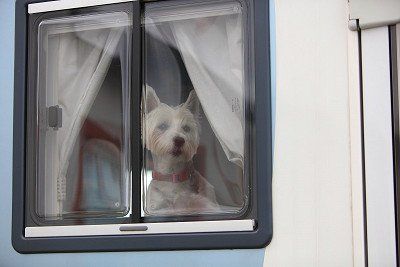
Entry requirements for pets: dogs and cats travelling with you require an EU pet passport. It has to include a veterinary confirmation of their rabies vaccination, which must be at least 21 days old. Moreover, the animal must have a readable tattoo or, if marked after 3rd July 2011, a microchip. Dogs must also be treated against tapeworm at least 24 hours and no more than five days prior to entry, which a vet must also confirm in the EU pet passport. Dogs must be at least 15 weeks old to enter Ireland. Dogo Argentinos, Fila Brazilieros, Japanese Tosas and Pitbull Terriers and dogs resembling any of these breeds are banned from entering Ireland. Dogs should be kept on a leash as encounters with free-roaming sheep or other wild animals are not uncommon.

The most important traffic rules for motorhomes and caravans in Ireland
Left-hand traffic: most visitors from mainland Europe often need a few days' driving practice in Ireland before they are comfortable with left-hand traffic. Therefore, given the weight and size of your motorhome or car/caravan combination, careful driving is a must. Try and avoid heavily frequented destinations and cities, at least in the first few days on the island, and instead switch to country roads with less traffic. This not only reduces the risk of accidents, but will also take you along scenic routes and stunning coastal roads. While on the ferry or just before leaving the ferry, set the headlights of your vehicle to left-hand traffic or tape off accordingly.
Speed limits on Irish roads
Road signs in the Republic of Ireland show speed limits in km/h, whereas Northern Ireland uses the British system of miles per hour (mph). You can take the speed limits in Great Britain as a guide for Northern Ireland.

Direction of travel for motorhomes and caravans on tourist ring roads
Larger camping vehicles, such as semi-integrated and fully integrated motorhomes and car/caravan combinations, should follow the recommended direction of travel when driving on tourist ring roads in Ireland. There is actually a reason for this: these roads are often very narrow and winding and used frequently by coaches and other large vehicles – but in only one direction. Therefore, do as they do and drive in the recommended direction, otherwise you will end up getting repeatedly stuck in oncoming traffic and blocking the entire road. For instance, buses drive on the Ring of Dingle on the Dingle Peninsula in a clockwise direction from Dingle Town. However, lorries and coaches travel anti-clockwise from Killarney on the Ring of Kerry (N70). Smaller urban campers and campervans that can manoeuvre easily in tight spaces do not have to stick to this rule. However, you will realise that it is considerably more relaxing when you adapt to the direction that the large vehicles are travelling in.
Tolls and environmental zones in Ireland
There are currently no environmental zones with specific access regulations in Ireland's cities. In Dublin, however, heavy goods vehicles with five axles or more are not allowed to enter the city between 7 a.m. and 7 p.m. every day.

When it comes to tolls in Ireland, some motorways do impose an extra charge to use them, which varies depending on the motorway section you are driving on. Motorhome and caravan holidaymakers will be pleased to hear that they will be paying the same rate as car drivers, regardless of the permissible total weight. With the exception of the M50 (Dublin Ring Road), you can pay in cash (Euros) and at times by credit card at toll stations. You could also get an eToll box, but this is usually only worth it if you are a frequent driver. If you are planning on driving on the beautiful country roads and coastal roads of Ireland anyway, you won't really need a toll box. There are no toll stations on the M50 around Dublin. Instead, a barrier-free tolling system called eFlow is in operation and detects number plates automatically. If you have not got a toll box, but want to or have to drive on the M50, register your vehicle's number plate in the eFlow system in advance or pay on the day following your journey at a shop or petrol station with the Payzone logo. The Dublin Port Tunnel, the Limerick Tunnel and the East Link Toll Bridge are also subject to tolls, which you can pay at toll stations. Avoid driving through the Dublin Port Tunnel during rush hour as these times of the day are significantly dearer than the phases with less traffic.
Petrol stations in Ireland: opening times and payment methods
There is a well-developed network of petrol stations in Ireland, especially along motorways and main routes. Fuel prices vary from petrol station to petrol station and are stated in Euros in the Republic of Ireland and in pounds sterling in Northern Ireland. Almost all petrol stations accept both credit cards and cash. At the petrol station, you first fill up at the pump and then pay at the till. Some petrol stations also have self-service pumps with credit card readers. Motorway petrol stations are often open 24/7, others from around 8 a.m. to 10 p.m. They often close earlier in rural areas.

General traffic rules in Ireland
Alcohol limit: the legal alcohol limit for driving is 0.5‰ blood alcohol content and 22 micrograms of alcohol per 100 ml of breath. The limit for novice drivers who have had their driving licence for less than two years and professional drivers is 0.2 ‰ blood alcohol content and 9 micrograms of alcohol per 100 ml of breath. Even minor violations can result in fines and a temporary suspension of your driving licence. If you visit a whiskey distillery followed by a tasting, enquire in advance whether you can park your motorhome or caravan overnight in their car park, otherwise consider taking public transport there and back. Driving licence and proof of insurance: an EU driving licence is sufficient for driving a motorhome or a car/caravan combination in Ireland. You must also carry the vehicle registration certificate with you. In the Republic of Ireland, an EU car registration number with the relevant country code is sufficient proof of insurance. However, a Green Card (international motor insurance card) is recommended as this makes it easier to process any damage. If you also want to visit Northern Ireland during your camping holiday, you will need an international motor insurance card that covers Great Britain (GB). If this is not the case, you will be forced to take out short-term insurance at the border. This also applies if you travel to Ireland via Great Britain.

Road signs: you will find motorways, two-lane dual carriageways, one-lane secondary roads with two-way traffic and small, winding country roads in Ireland. Motorways are identified by the letter M followed by a number. In the Republic of Ireland, National Primary Roads or national roads have the letter N and regional roads the letter R. Small roads do not have a letter. Brown road signs indicate tourist routes. In general, signage in Ireland is mostly bilingual (English and Gaelic). However, in Irish-speaking Gaeltacht regions where Irish is the official language and lingua franca, they are exclusively in Gaelic. Distances are stated in km in the Republic of Ireland and in miles in Northern Ireland. The road signs in Northern Ireland are slightly different: an M also stands for motorways, an A for A-roads/national roads and a B for B-roads/country roads.

No-parking and no-waiting zones: a double yellow line and yellow zigzag lines always mean no parking or no waiting at any time; a single yellow line means no waiting at certain times of the day as indicated on nearby signs. Red and black signs, which are often attached to lampposts, indicate Controlled Parking Zones where you are not allowed to leave your car unattended, otherwise it could get towed. Official parking areas are usually signposted and can often be used with a parking disc or a parking ticket (Pay and Display). Parking machines can be paid for in part with coins, in part electronically via specific apps. Mobile phone use in vehicles: you may only use a mobile phone in a hands-free device while driving.

Roundabouts and right of way: despite driving on the left-hand side of the road, traffic coming from the right has right of way, unless otherwise indicated by Stop, Yield or Géill Slí (Gaelic) markings. This also means that when entering a roundabout, of which there are many in Ireland, you must turn left and give way to vehicles coming from the right already on the roundabout. Indicate when exiting the roundabout. Light requirements: there is no general obligation to drive with dipped beams or daytime running lights during the day when it is bright. However, when there is bad weather and visibility is restricted, you have to turn on the lights. High-visibility vest requirement: there are no regulations in Ireland regarding high-visibility vests in vehicles. However, it is advisable to have safety vests for everyone travelling in the car or motorhome.
Child car seats: children weighing less than 36 kg or smaller than 150 cm have to use a child seat or booster cushion with a restraint system suitable for their height and weight. Winter tyres: winter tyres are not compulsory in Ireland, although they are recommended for difficult driving conditions in autumn and winter. Snow chains can be used when the roads are completely covered with snow, which rarely happens in Ireland.

Wild/free camping: the national camping season in Ireland usually starts around Easter and ends in October, but some of the official campsites and many RV parks in Ireland are also open all year round. During the peak travel season between June and August, it is advisable to book your campsite in advance. Wild and free camping are generally not permitted in Ireland unless the local authorities have specifically allowed it by placing signs in designated areas or you have obtained the owner's permission on their private property. Much of Ireland's land is privately owned and reserved for grazing livestock. However, the majority of locals would not mind you parking your motorhome considerately for the night as long as you ask permission and leave the place as you found it.
Motorhome hire in Ireland
If you want to travel to Ireland with your own motorhome or car/caravan combination, you will have a long journey ahead of you – either by driving directly to Ireland via a ferry or by combining your trip to Ireland with a tour of Great Britain and a ferry crossing. If your time is limited or you do not have your own motorhome, we recommend renting a motorhome or campervan in Ireland – a great solution if you do not want to drive on the left-hand side of the road with your own left-hand drive vehicle. For instance, the Freeontour partner McRent offers a wide range of camping vehicles at its two rental stations in Ireland, ranging from agile campervans to fully integrated motorhomes or alcove motorhomes with plenty of space for the whole family. Very practical: the McRent rental station in Dublin is only about two kilometres from Dublin Airport, allowing you to get to Ireland quickly to start your motorhome trip around the Emerald Isle.
Important addresses and telephone numbers for holidaymakers in Ireland
European emergency number: 112 or 999 Call either of these two central emergency numbers in the Republic of Ireland to get help from the local police, fire brigade, emergency doctor or ambulance. Calls are free from a landline and mobile phone, no area code is needed. In Northern Ireland , you can only contact the police and emergency services on 999 .
You might also be interested in
The most beautiful routes, related partners.
The Wild Atlantic Way Road Trip Itinerary in a Motorhome

Taking a motorhome to Ireland
Ireland is one of the best locations for a motorhome road trip. Though wild camping isn’t allowed, there are plenty of free overnight parking spots in Ireland , true to the welcoming Irish spirit. On this ultimate Wild Atlantic Way road trip itinerary, we'll highlight our favourite campervan-friendly spots to pitch up on each leg of this magnificent journey. Need help figuring out how to travel to Ireland in a motorhome? Check out our guide to ferry routes , or advice for taking your motorhome abroad .
The Wild Atlantic Way is a 1,500-mile journey from Inishowen Peninsula in County Donegal in the north, to Cork in the south-west. The route takes you through the counties Leitrim, Sligo, Mayo, Galway, Clare, Limerick and Kerry, finishing in Kinsale, County Cork. Of course, you can do it in the opposite order, too! The whole route is divided into 14 sections for easy navigation. We'll highlight the best of each stretch of the way, including the unmissable wonders you simply cannot miss and where to stay the night. But first, some tips for planning your road trip!
Planning your road trip
Most people will tell you to go during the summer months, an idea with truth to it if you want to make the most of the beautiful beaches along the route. But if you ask the Irish, they would tell you September is ideal. If you prefer quieter roads and don’t mind gloomier — read atmospheric — weather conditions, take their advice and drive during the shoulder months of spring and autumn. The traffic will have thinned significantly, but be prepared to dodge tractors and sheep, as the west coast of Ireland is as rural as it gets.
Whenever you choose to embark on this road trip of dreams, you’ll be mystified by the way the light changes hourly across Ireland’s expansive landscape. And the weather, too! So, pack prepared for all eventualities.

1. Inishowen Habinsel — Derry to Letterkenny
We’re beginning the Wild Atlantic Way road trip in the north of the Inishowen Peninsula. This is Ireland’s largest peninsula and already has its own popular looped drive, the “Inishowen 100.” To really get into this part of Ireland, have a look at the breakdown here . It’s flanked by Lough Foyle on the east, Lough Swilly on the west and the Atlantic on the north side. You’ll pass breathtaking views, awesome beaches, rugged mountains and picturesque fishing bays, reaching the most northerly point of mainland Ireland at Malin Head. If you want to This is where the coastline gets wild and craggy, thanks to the incessant force of the Atlantic Ocean. At the Gap of Mamore, the road winds steeply up to 240m, to a pass with an incredible, panoramic view over the whole northern coastline. A steep decline away from this point marks the exhilarating departure for the rest of your road trip! Be sure to see Malin Head , the Gap of Mamore , and Lenan Bay .
Where to Stay

2. Fanad Head — Letterkenny to Bunbeg
As you leave Letterkenny and head north along Lough Swilly’s banks, you’ll be treated to the remote and untamed Donegal countryside. The road ascends the edges of the Knockalla mountains as you head to Bunbeg and there are some sights you can’t afford to miss! Fanad Head is an awesome lighthouse that towers over the Atlantic’s fierce waves. Walk along the steep, bizarrely-shaped cliffs of Horn Head , with views over the Fanad Peninsula to Tory Island , 14km away, from the old signal tower.

3. Slieve League Coast — Bunbeg to Donegal Town
The Wild Atlantic Way route makes a winding southerly descent from Bunbeg to Donegal Town, passing through the strange, wonderful region of The Rosses . It’s packed with bogs, lakes and out to sea, you’ll spot numerous little islands including Ireland’s second-largest, Arranmore. After Ardara, you’ll drive inland and cross the Glengesh Pass, continuing through the tranquil Glencolumbkille as the narrow coastal roads reveal more breathtaking views and end atop the Silver Strand. The Rosses holds a rich maritime history and its monuments and festivals are worth exploring. You can take boats for a sail from the yacht club or go on exciting boat tours to see the coastline from the water and get to know its natural history. Be sure to have a look along the steep sloping cliffs of Slieve League , which are among the highest cliffs in Europe, towering up to 600m high.

4. Donegal Bay and Sligo — Donegal Town to Ballina
The coastline softens slightly as you travel south from Donegal to Sligo and Mayo. If culture and food are your thing, you’ll love this leg. Sligo is becoming a foodie and cultural hub in the North West, and there are plenty of bars and restaurants to enjoy. The scenery is still beautiful, and there’s an iconic mountain climb to do up Benbulben, which was made famous in WB Yates’ poetry. Don’t miss a visit to the prehistoric Ceide Fields , which is an archaeological site containing the oldest known field systems in the world. As you push off, visit Downpatrick Head which is a nearby beauty spot that also has an illustrious history as a hideout during the 1798 Irish Rebellion and as a WWII lookout. If you’re a foodie, definitely add the ‘ Gourmet Greenway ’ food trail in County Mayo to your Wild Atlantic Way route, as it includes 18 artisan producers showcasing local delicacies.

5. Erris — Ballina to Belmullet
The larger town of Ballina offers plenty of choices when it comes to accommodation and refreshment, so you can catch your breath here before heading on to the more rugged parts of your Wild Atlantic Way itinerary.
Stay at Carrowkeel Camping and Caravan Park for a comfortable rest in the heart of County Mayo next to the Clydagh River. There are 32 hardstanding pitches for motorhomes, each with a 16Amp electric hook-up available. The other facilities include a reception with shop and tourist information, modern and wheelchair-accessible toilets, a clubhouse where you can enjoy a meal and drink in the evenings, a kitchen and laundry room for campers, and free WiFi.
6. Achill Island and Clew Bay — Belmullet to Westport
Further along the coast, the island of Achill is only a few hundred feet from the mainland, connected by a bridge. Visit for an insight into island life, without having to take a boat! Take a walk to the deserted village where you’ll find the remains of almost 100 stone houses – a haunting reminder of times past. If you want to catch some traditional Irish music, go to Matt Molloy’s in Westport . The bar is famous for its nightly jam sessions. Also, explore the magical expanse of Clew Bay, where pirate queen, Grace O’Malley, once ruled the seas.
Where to Stay

7. Killary Harbour — Westport to Clifden
You’ll get closer to Croagh Partick after leaving Westport. This is Ireland’s sacred mountain, where a Celtic hill fort has been discovered circling the mountain’s summit. As you continue south, the Wild Atlantic Way meanders through valleys such as Doo Lough and Delphi. Then, you come to Killary Harbour, which is Ireland’s only fjord, and extends 15km inland.

8. Connemara — Clifden to Galway
Galway boasts some of the most remote coastal scenery in the country, a vibrant city, and island communities where Irish remains the first language. In 2020, it was a European Capital of Culture . There are so many celebrations of Irish culture in this part of Ireland throughout the year that you’ll be sure to catch one on your Wild Atlantic Way road trip, from the Galway International Arts Festival to the Comedy Festival, Races, Oyster and Food Festivals to Literary Festivals and Christmas Markets.
Connemara is home to the biggest National Park in Ireland. There are 2,000 hectares of mountains, bogs, grassland and forest. It’s unmissable if you love a hike and the natural world: you’ll see many tiny insects, songbirds like stonechats, chaffinches and robins or birds of prey like the merlin or peregrine falcon. And, of course, Connemara ponies roam free around the park.

9. The Burren and West Clare — Galway to Kilkee
On the border of Counties Galway and Clare, stop at the picturesque village of Kinvarra for lunch and wander around the numerous craft shops at this beauty spot. Beyond the magnificent cliffs of Moher, which stretch for 14 miles and are one of Ireland’s most-visited natural attractions, take some time to explore the Burren National Park . The Burren is just under 4,000 acres of exposed limestone that still contains a huge selection of flora and fauna. There are seven marked walking trails to take through the National Park. Take note – it’s illegal to pick flowers or damage the Burren in any way.
It’s worth spending some time around Doolin on the beautiful Loop Head peninsula. Though probably less crowded than the more popular destinations, it’s no less scenic. Activities including dolphin watching and coasteering will keep everyone entertained no matter what your interests are.

10. The Shannen Estuary — Kilkee to Tralee
On this leg, you’ll drive into County Kerry on the way to Tralee. Kerry is called ‘The Kingdom’ by locals, and not without reason: it’s home to some of the most stunning coastal and pastoral scenery in Ireland. Near Tralee, the National Folk Theatre of Ireland, Siamsa Tíre , puts on Irish music and dance performances which are definitely worth watching.
11. Dingle Peninsula — Tralee to Castlemaine
As you traverse the southwest coast of the Wild Atlantic Way, you’ll drive along the Dingle Peninsula (Corca Dhuibhne) as it stretches 30 miles into the Atlantic Ocean. The range of mountains that form its spine runs from the Slieve Mish range to the Conor Pass and Mount Brandon, Ireland’s second-highest peak. The coastline consists of steep sea cliffs like Slea Head and dramatic headlands broken by sandy beaches, with the award-winning beach at Inch in the south and the Maharees to the north.
On the most westerly tip of the Dingle peninsula, Dunquin is a Gaeltacht village where Irish is still spoken as a first language (although everyone speaks English too). It’s known for its surviving Gaelic culture, dramatic cliff scenery, and for its proximity to the Blasket Islands . If you have time, it is worth visiting the islands on a day trip to walk among the deserted villages, deserted in the 1950s, and to see the abundance of wildlife on the island.

12. Ring of Kerry — Castlemaine to Kenmare
Another scenic drive in its own right, the Ring of Kerry offers a wow-factor leg of the Wild Atlantic Way. This part of the drive could take you one or a few full days depending on how much time you have, as the Ring of Kerry is 112 miles long and includes inland locations like Killarney National Park, which are worth a visit if you can veer slightly off the Wild Atlantic Way map. Other mentionable sights include the Iron Age Cahergall Stone Fort, the ferry crossing to Valentia (population 156 and also home to fossilised tetrapod footprints dating back 385 million years ago!), the Ring of Kerry lookout, the Ladies View and Torc Waterfall. If you want a full itinerary, read our previous blog on the Ring of Kerry road trip !

13. Beara and Sheep’s Head — Kenmare to Durrus
For our last two stops, we cross the county border into the largest county in Ireland, Cork. The Beara Peninsula is tranquil and unspoiled. Prepare for narrow, winding roads but take your time, it is worth the journey. Take Ireland’s only cable car out to Dursey Island , known for its wildlife, particularly bird watching. Be sure to stock up on food and drinks before you do, there are no restaurants or shops on the island! This is a wild corner of Ireland, but enjoy the remoteness - you’re nearing the end of your trip!

14. West Cork — Durrus to Kinsale
Kinsale is close to the end of the Wild Atlantic Way route and the perfect place to end your trip on a high. It’s a foodie and craft heaven, so be sure to grab a meal in one of the many gourmet restaurants in the town, have a tour of Charles Fort, or challenge yourselves to a round of golf at The Old Head of Kinsale, one of the most scenic courses in the country.
After a night in Kinsale, head onwards to Cork to finish up your journey in Ireland’s second-largest city. Feast after your adventure at the Flea Markets , take a tour around the Old City Gaol or the stunning Blarney Castle and gardens , or simply slurp a Guinness with a delicious stew after receiving a warm welcome at Jim Cashman’s Pub in the heart of the city and... relax!
In Kinsale, you can pull up with your motorhome for free overnight at the New Road Car Park . Whilst ostensibly nothing special, this is a great place to spend the night because it’s quiet, the centre of Kinsale is a 5-minute walk, there are public toilets and beautiful views of the city and harbour nearby. It might be a late night out, with many nice pubs and restaurants and live music everywhere, so be respectful to your fellow overnight campers!

Before you go
Ireland’s Tourism Organisation has painstakingly taken small, single-lane, and sometimes dangerous coastal roads, and marked them out for all the world to come and drive. This makes for an authentic, exciting driving adventure distinct from other popular coastal roads around the road, and we’re very grateful! But, drive carefully and be warned: some roads are steep and narrow, and make for a thrilling (but not impossible!) drive along the Wild Atlantic Way with a motorhome.
Whilst the route is signposted, it’s usually only signposted in north and south directions, although you’ll often be driving east, west, and all directions in between as the roads wind around. So, it would probably be a good idea to put the next stop on your trip into your GPS or Google Maps as you go.

Hire a motorhome for your road trip through Ireland

- Stay up to date on great motorhome destinations
- Receive exclusive deals and promotions
- Found a nice motorhome? Save it for later
Goboony uses cookies and similar technologies to provide our service to you. They also help make our communication to you easier and more personalised. With these cookies Goboony (and third parties), can track your internet behavior inside and outside Goboony. Some are necessary to help our website work properly and can't be switched off, and some are optional but support Goboony and your experience in other ways. Using cookies, we (and third parties) adapt our website, advertisements and communication to better suit your interests. You can accept the cookies by clicking on the button below. If you cookie-modal#acceptNecessaryCookies">refuse them we will only use functional and analytical cookies. Read our cookie policy .
RV rental Ireland

RV rental in Ireland
RV Rental in Ireland allows visitors to experience the Emerald Isle unlike it has ever been experienced. To be honest, Ireland is a country that is full of delights, both obvious and hidden. Wreathed in a cloak of mystery, history and simple natural beauty, Ireland is one of those European countries that beckons the visitor to come and get lost in the miles of serenity that form part of the open countryside, or just as easily lose yourself in the modern, bustling cities that might remind you of back home. RV Rental in Ireland allows you to do more than just visit the same small area during your vacation. Why just visit one area when you can go explore the entire country?
More than Meets the Eye
Ireland has a lot of different places that a visitor can go to experience what life in Ireland is like. A lot of the tours that go through Ireland fail to show off what it is makes Ireland unique. You might get a taste of the real Irish countryside, but the best way to experience the brand new world that the Emerald Isle offers is to rent an RV. RV Rentals in Ireland allow for a lot of flexibility of movement and are very convenient, allowing for clients to rent an RV as soon as their flight arrives from the European mainland. Road tripping through Ireland is probably the most impressive way to enjoy a leisurely drive discovering Ireland one city at a time.
The capital of Dublin is renowned for many things, not least of all its Guinness. The night life in this city reflects all the things that make Ireland one of the most engaging places in the world to visit. Dubliners are a happy sort of people, always willing to find out more about you and having opinions on most things under the sun. They, like most of the Irish, enjoy talking to strangers at the nearest pub and Dublin has a myriad of those on every corner. Combine that with the amount of people visit Dublin on a yearly basis and you'll start to understand how they seem to know so much about where you're from...possibly even more than you do!
Cork tends to be high up on the list of places to visit in Ireland because a lot of things that fill most people's Irish bucket lists can be easily found in this district. Starting from Limerick and driving further north, you can experience one of most breathtaking natural drives in all of Europe as you make your way into Cork and Kinsale. Dotting the countryside are villages and hamlets that speak of a quaint country life that reminds you of much simpler times. Ireland isn't the biggest of places in the world and it's very easy to cover a lot of ground without even being aware of it.
From Cork it's a hop, skip and a jump away from the Blarney stone, one of the more recognizable landmarks in Ireland. According to legend, a kiss planted on the Blarney Stone offers the bestowed the "gift of gab" or true eloquence with his or her words. If you're planning on kissing the Blarney Stone, you should be careful since the stone is situated precariously along the battlements of the castle that shares its name. Thousands of people come every month to look at (and yes, kiss) the Blarney Stone, and it's one of Ireland's signature attractions. Renting an RV in Ireland can easily allow you to make time to check out this oft talk about attraction.
County Kerry boasts some of the most picturesque coastlines around and word of their beauty has made it back to the tourist collective, meaning that this area (most importantly the Dingle Peninsula) has become a frequent stop for a lot of visitors. Since the 1980's Fungie, a dolphin that frequents the coastal waters here, has been befriending tourists. Some think it's because of the mammal's attraction to the intelligence of humans, but others think the dolphin is only doing it for the free fish that visitors feed him. Whatever the reason, he's been coming back for decades to bring a smile to face of visitors.
Easy Ireland RV Rentals
A lot of the queries that tourists raise about RV rentals in Ireland can be dispelled easily. Many are concerned that when they rent their RV they won't be aware of where to go. In order to avoid that, planning an RV trip beforehand is essential. If you get your RV rental in Ireland, you can be spontaneous and go anywhere, but being properly stocked up on supplies is a necessity. Ireland has a lot of open space between their towns and cities but that usually means that if you run out of supplies while out on the road, you may have to wait until you make it to a town to get food and water. Foresight is important to planning your RV rental in Ireland.
As for convenience, that's part of the reason you'd want an RV rental in Ireland in the first place. RV's provide shelter as well as a means of preparing breakfast, lunch and dinner, provided you get the raw necessities. Most RV's come with kitchenettes or grills that allow for quick and efficient preparation of foodstuffs. You can even board a ferry with your RV to enter the UK, but you should know your RV size beforehand in order to determine whether the ferry accepts vehicles of that size. There are regular sailings from Ireland to England, Wales, Scotland, even all the way over to France!
Flexibility in Vacationing
What sets the RV crowd apart from everyday visitors is that they are proactive about their visits. People who want more flexibility to be able to go where they want to and to experience what a country has to offer from a firsthand perspective are the ones who decide on an RV rental in Ireland as their best bet. These are the world travelers that always have tons of stories to tell their friends and family about real people they met while on their journeys. It's as close to an adventure that we can get in our modern world. If you're interested in renting an RV to explore the wonders of the Emerald isle, contact Campanda today to find out more about the models we offer.
Want to refine your search? Why not take a look at the following cities?

7 day RV Road trip in Ireland
7 day rv ireland roadtrip with kids, ireland has been on my bucket list for years. i knew i wanted to go and i knew i wanted to take my kids. i wanted to explore ireland entirely and i knew it was going to be a long road trip. spanning over 10 days i wanted to cover as much ground as possible..
I researched and found that taking an RV around Ireland wasn’t very popular. Let me tell you…I am going to make it popular because having an RV was a game changer. Having the space to spread out while we drove for hours each day made it a breeze. The kids were easier to entertain with a table and chairs and bunk beds to take naps in or they could go to bed if we needed to drive at night.
What to book?
We decided to fly roundtrip out of Dublin. Cheaper then flying in and out of somewhere else. Easier to return the RV at the same location and it allowed us to do the whole loop.
We decided to go with Bunk Camper. We got the biggest one Grande, sleeps 6. I chose unlimited miles, toilet cleaner, bedding and towels (I only ordered 4 but I would suggest ordering for every single person), and the drop and go (meaning that we didn’t have to clean before we returned it)
- They also gave us THE MAP! Had all the RV park locations. IMPORTANT ITEM!
Fly to Ireland. We flew into Dublin.
Right when we flew in (we got there early in the morning) we took a taxi and headed straight to Bunk Camper location to pick up the RV. They ran us through everything (took a little longer then I thought so plan on that) and then we were ready to go! We first drove to a market to pick up some things to begin our journey.
- breakfast items
- anything we forgot
- fun Irish candy and treats
We decided to start driving since we were going to spend time in Dublin on the way home.
First stop was Kilkenny:
We walked down the streets of Kilkenny and enjoyed the colorful houses and the beauty! Since it was morning we stopped and at brunch at a local place. ( we followed reviews on google for this one) We ate a classic “English breakfast” ( none of us liked the pudding cake things but we all tried them) and the kids enjoyed hot chocolate and our trip began!
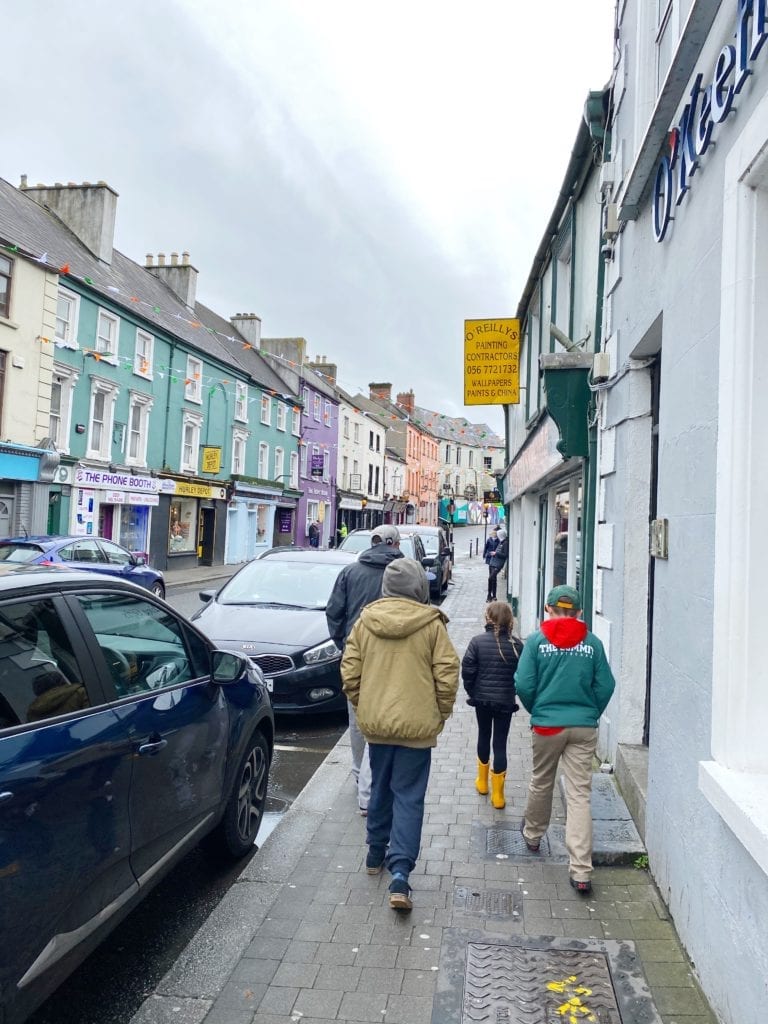
After breakfast we walked down the street to the Kilkenny Castle.
We went inside and took a tour. This was my 7 year old daughters favorite castle. Because crowds were light we were able to buy tickets right when we got there. (check this prior to going, it may change depending on what time of year you go) Every castle was so different and we wanted a variety.
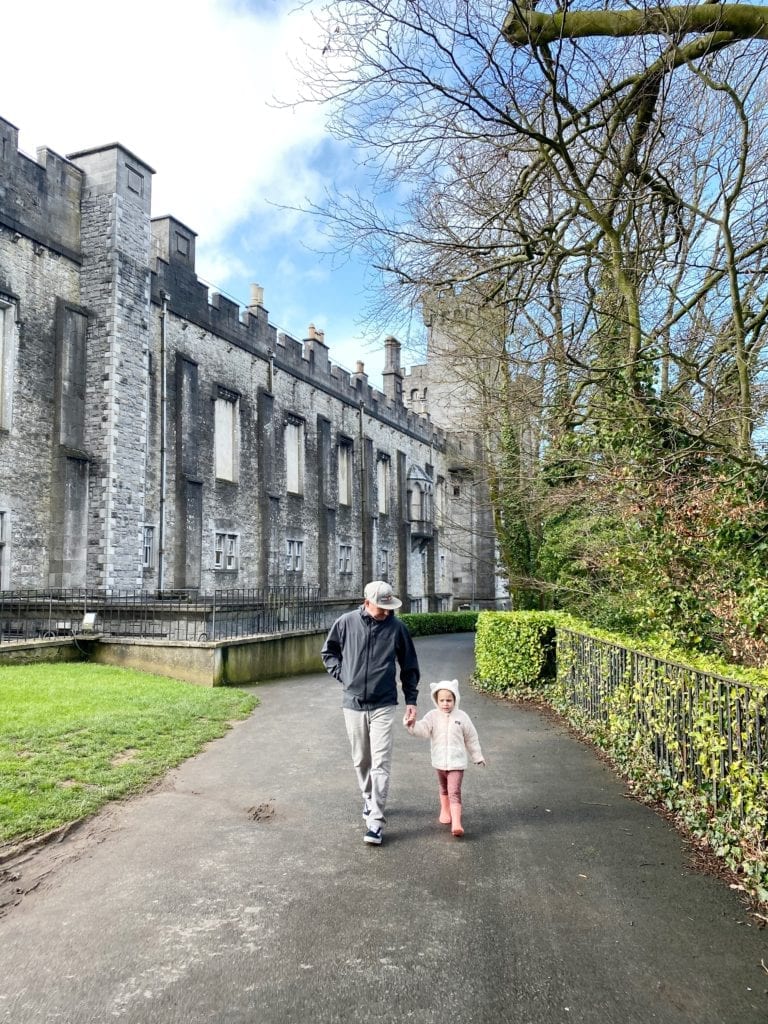
My daughters favorite room was this nursery.
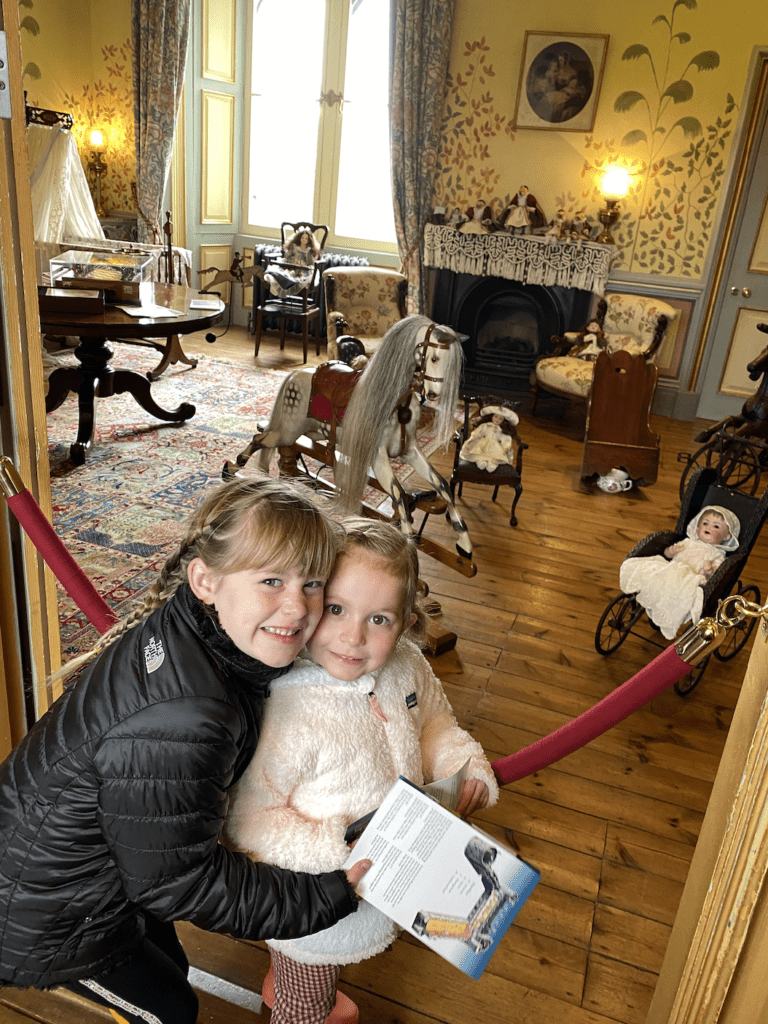
Right after this castle we decided to keep driving. We wanted to go down to Waterford. We headed that way and then went on a Ferry with the RV. It was a funny experience that my kids still laugh about. We took the passage east to Arthurstown, Kilhile, Coleman, Cuncannon, Fethard on Sea and we headed to the Hook lighthouse in Churchtown.
I made it a point to hit places that were kid friendly. I didn’t want to just see castles. So going into the oldest working lighthouse in the world was so much fun for the kids! They have ships to play in, playground, a shop, ice cream, and a tour. We decided to go on the lighthouse tour and it was definitely worth it. We all learned a ton and the views were amazing.
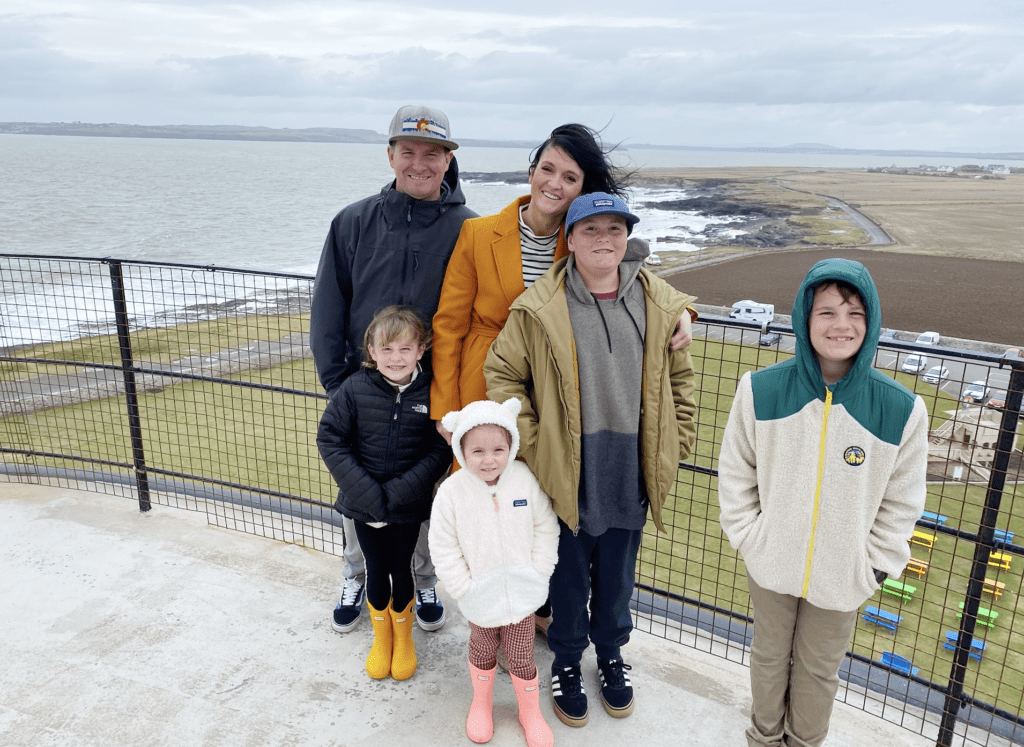
We stopped in a playground in Waterford next to Duncannon beach and then walked down to the beach.
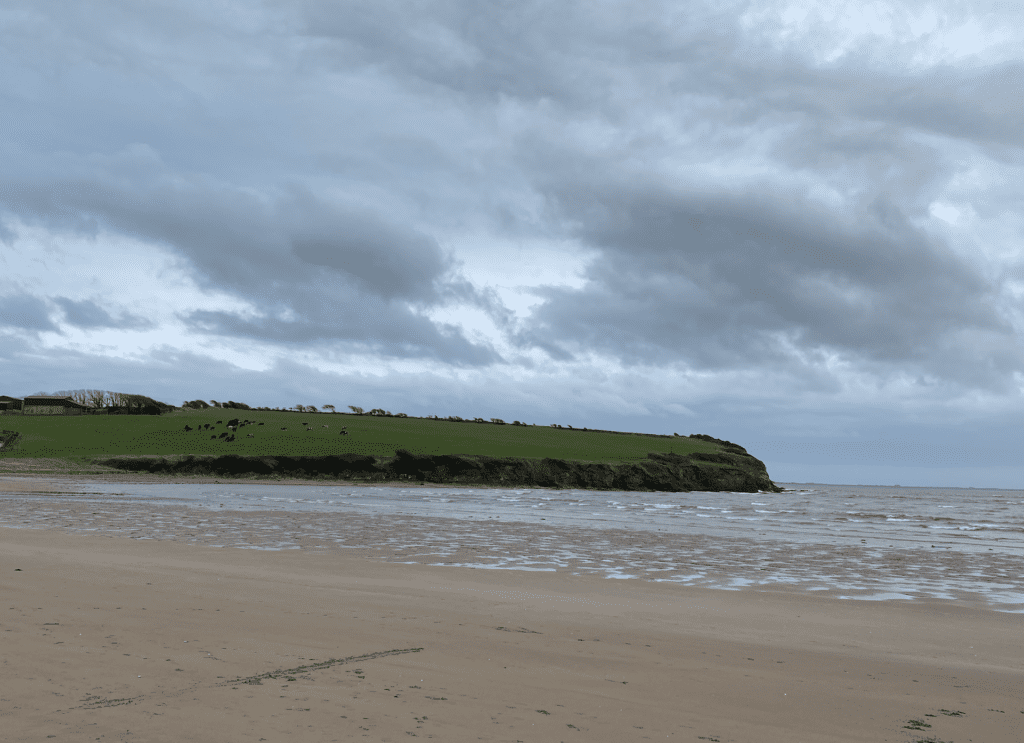
We then started the drive to Cork where we would stay the night. On the way to Cork we called RV parks around and asked if any availability. (It was off season so the map that the RV place gave us let us know which ones were open on off season, so we called around just to double check if they had room. Every single RV park we stayed in was almost empty because it was off season) If you are going during busy season you can book your campsites prior to going on your trip
We parked the RV in Cork and decided to go into town for dinner. We found Market Lane through google and looks on ratings. It was a yummy steak and chicken place and we had their creme brûlée and ice cream for dessert.
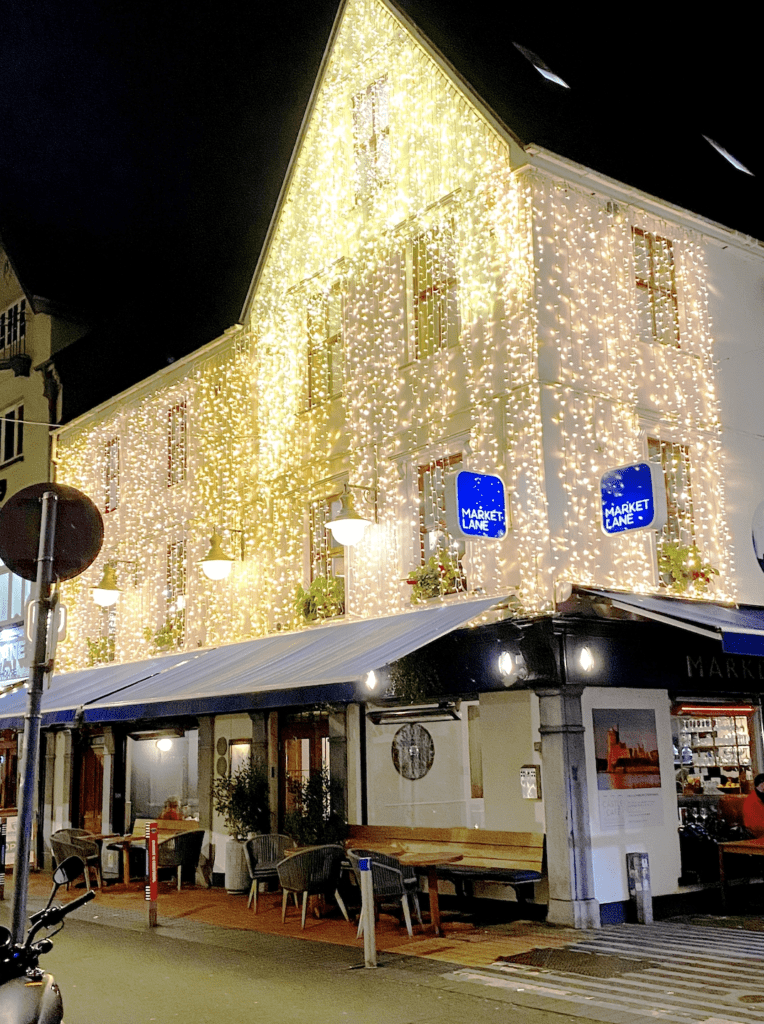
We stayed in the RV park and woke up and took showers in the RV park. They have plug ins where you can plug in your RV so you can put your heater or air conditioner on, bathrooms to brush your teeth and get ready and shower. As a family of 6 we never had to use our shower in our RV to get ready because the RV parks had showers to use. Some of them you have to pay with tokens.
That next morning we went into the town of Cork and had breakfast at Scoozi and walked around Cork. We visited Sant Fin Barre’s Cathedral and went clothes shopping. Then we went to the English Market. This is where they have all kinds of food items to buy. From desserts, to vegetables, olives, breads, and everything in between.
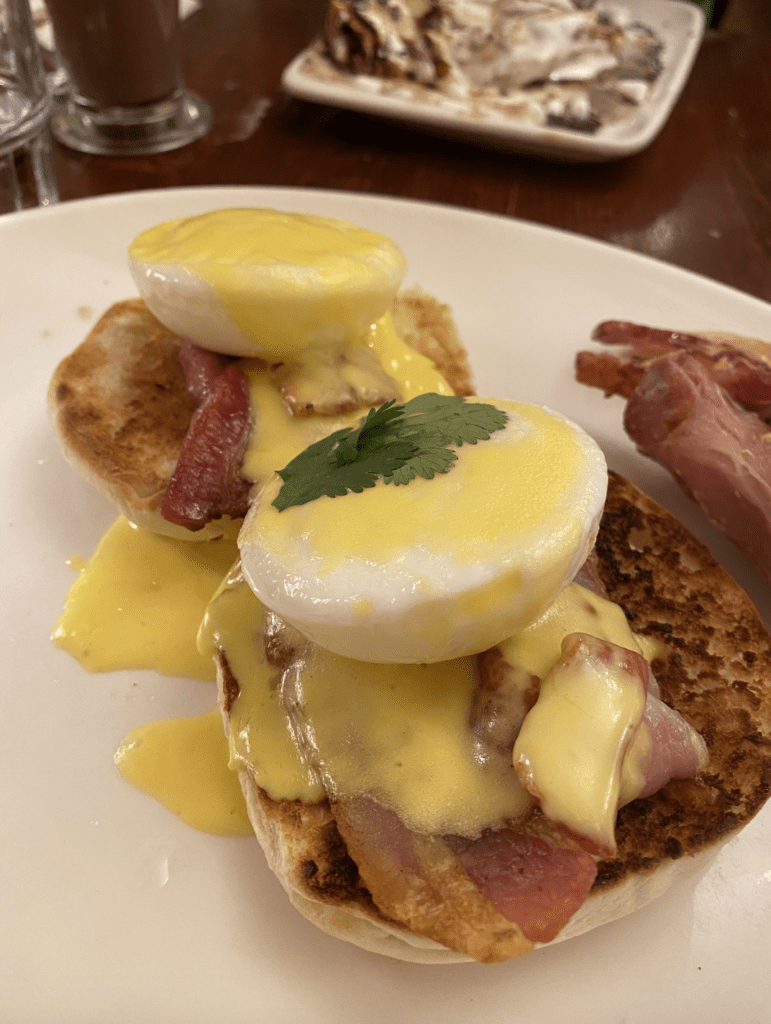
After the market and breakfast we headed to Blarney Castle . We spent 4 hours exploring this castle. The grounds are absolutely amazing! We kissed the Blarney Stone, explored every room in the castle, and spent time on the grounds after running around and exploring. This was a highlight of the trip for me personally.
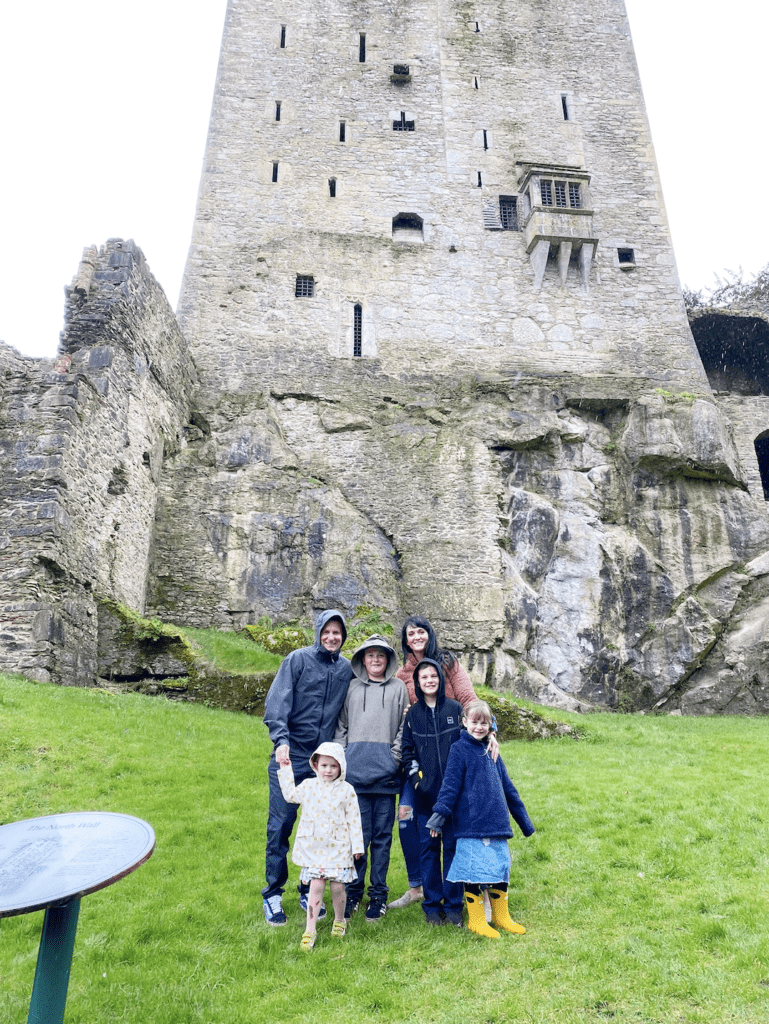
Then after the castle we headed to Kinsale . Kinsale is a fishing town. It was so beautiful. We enjoyed fish and chips right on the water and loved walking through the streets of town exploring. I wanted to see a variety of places and this fishing town wasn’t like the rest of Ireland. We ate lunch at Dino’s fish and chips .
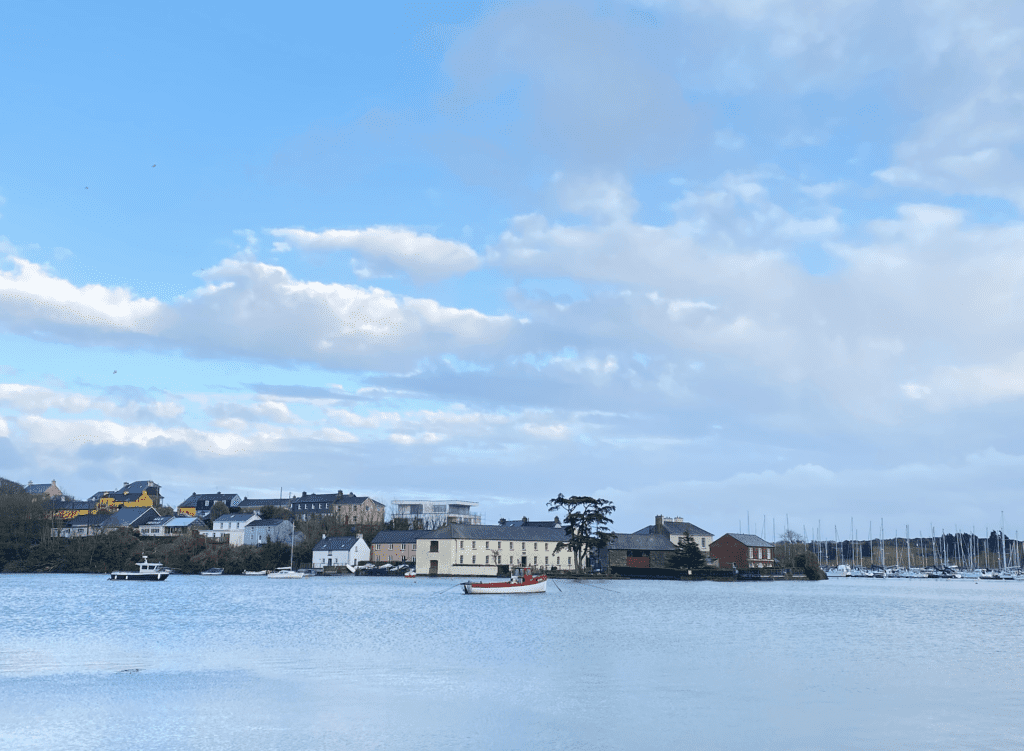
After that we took a beautiful drive to Killarney where we stayed the night at an RV park. We called around again to see which was open.
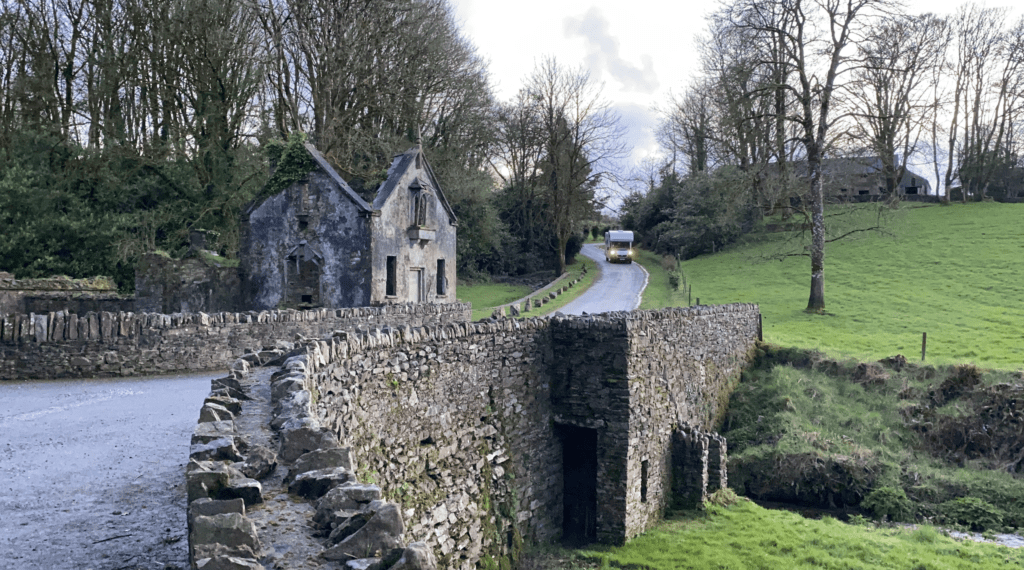
First stop in town was Murphys Ice Cream . We all fell in love with this ice cream place and stopped a few more times at different locations.
We started the day by heading to Muckross House in Killarney . We wanted to give our children the expierence of an Estate and how homes were run and this place was amazing. We bought tickets at the door and did the whole tour and we loved it.

On the way out we stopped at Murphys for ice cream again and then headed in Inch Beach . It was a little cold and windy but during warmer months this is a hot spot. We were on our way to Dingle Peninsula. This was probably one of my favorite drives of the whole trip. Absolutely beautiful. There was ocean views, mountains, hills, and green pastures. We stopped and rolled down the hills and ran around and enjoyed the beauty.
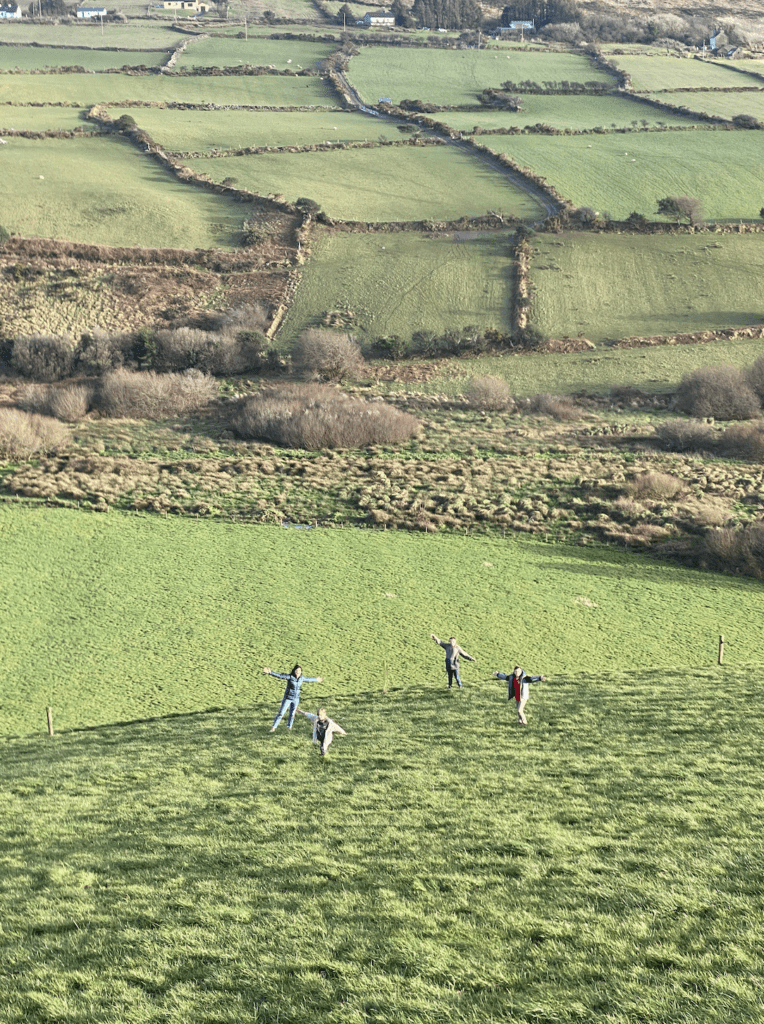
In dingle we went to Rahinnane Castle . This was a old castle with only pieces left of it. This was both of my sons favorite castle. They spent hours climbing, exploring and playing hide and seek together.
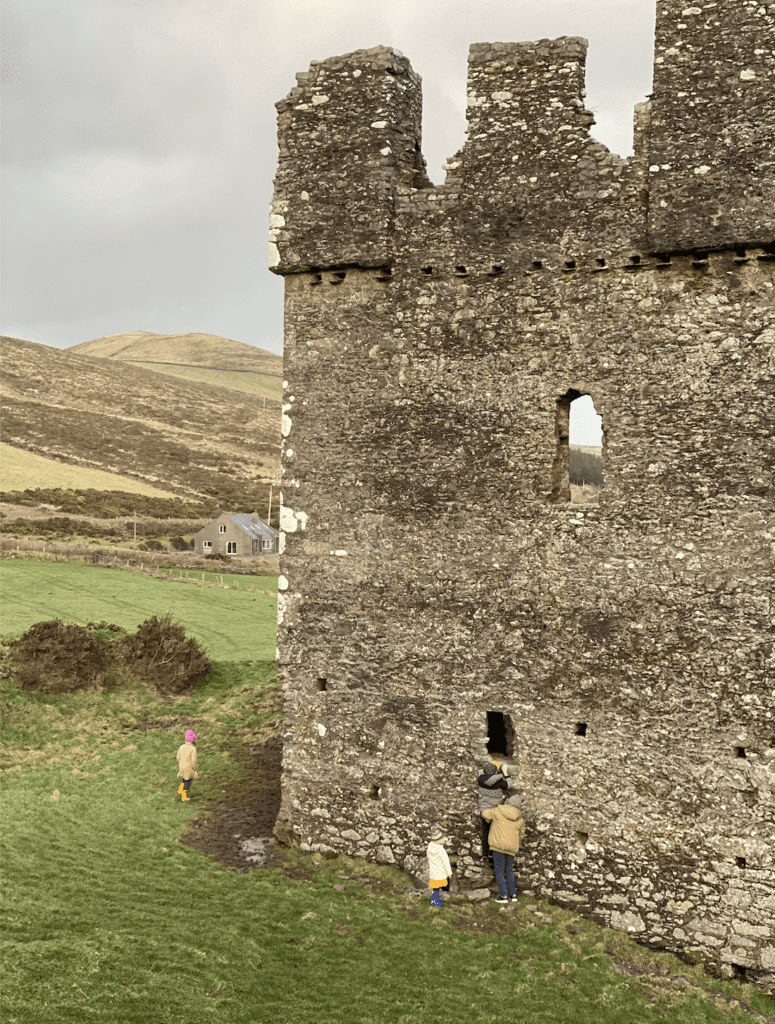
After that my husband and I were not tired so we decided to drive in the night time after it was dark. We took the Conor pass. It was absolutely beautiful and we wish we could have seen all of the drive in the day time. But we were not tired. My husband and I spent that whole drive talking about the memories our kids were making and how good it felt as parents to see our children together, having fun, and creating memories.
We drove to Tralee and spent the night at an RV park there.
We woke up in Tralee ate breakfast and drove to Listowel, Tarbert Island, onto a ferry in Killimer, through Lehinch, onto the Cliffs of Moher.
We spent a few hours exploring the Cliffs of Moher . It was the coldest and windiest day out of all the days. Which was a total bummer. We could have spent way more time exploring there if the weather wasn’t so cold for us Arizonans.

After that we drove to the Kilfenora . Saw a few castles (that were closed) on our way to Galway.
We made it to Galway and found an RV park, parked it and then headed to town for dinner and dessert. We stopped at a candy shop and my kids each picked out a few things for their road trip snacks. And we went to Murphys ice cream.

We woke up and had breakfast in Galway and then headed to northern Ireland. First stop was Londonderry . My kids called this the creepiest castle. We explored it and my kids dared each other to jump in the freezing cold water.
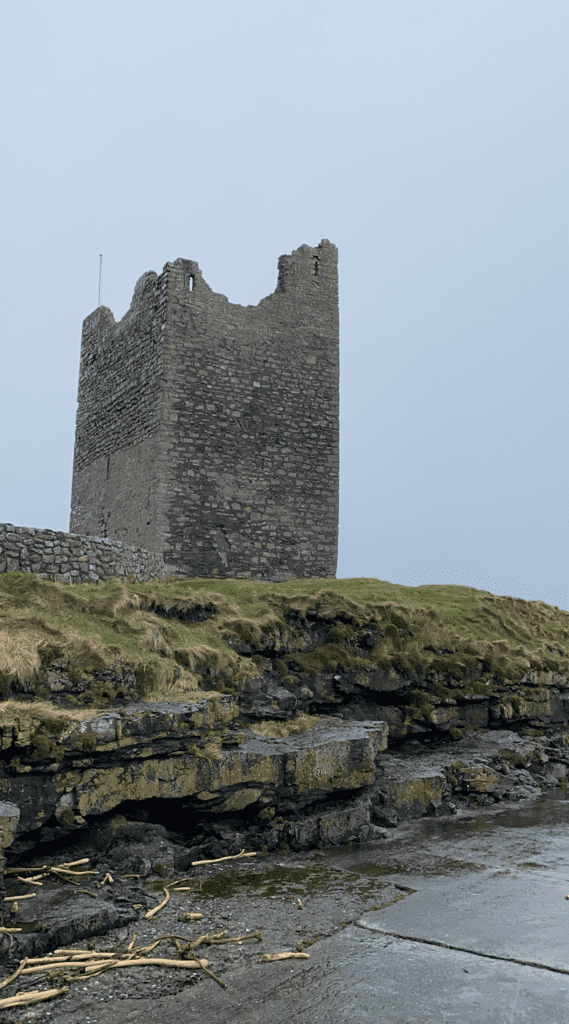
Then we continue to drive around to hit the Dark Hedges. We stopped along the way and enjoyed the view. Northern Ireland does have a different currency and government than Ireland. A lot of people in Ireland throughout our trip told us to stay in Ireland and not go up to Northern Ireland. It could have been that we were at the beginning stages of Covid 19 and they wanted to keep us separate but we did not have any problems and we are so glad we could explore both.

There was some areas to explore right by the Dark hedges parking area. They had little villages and houses in the woods and my children loved exploring it all.
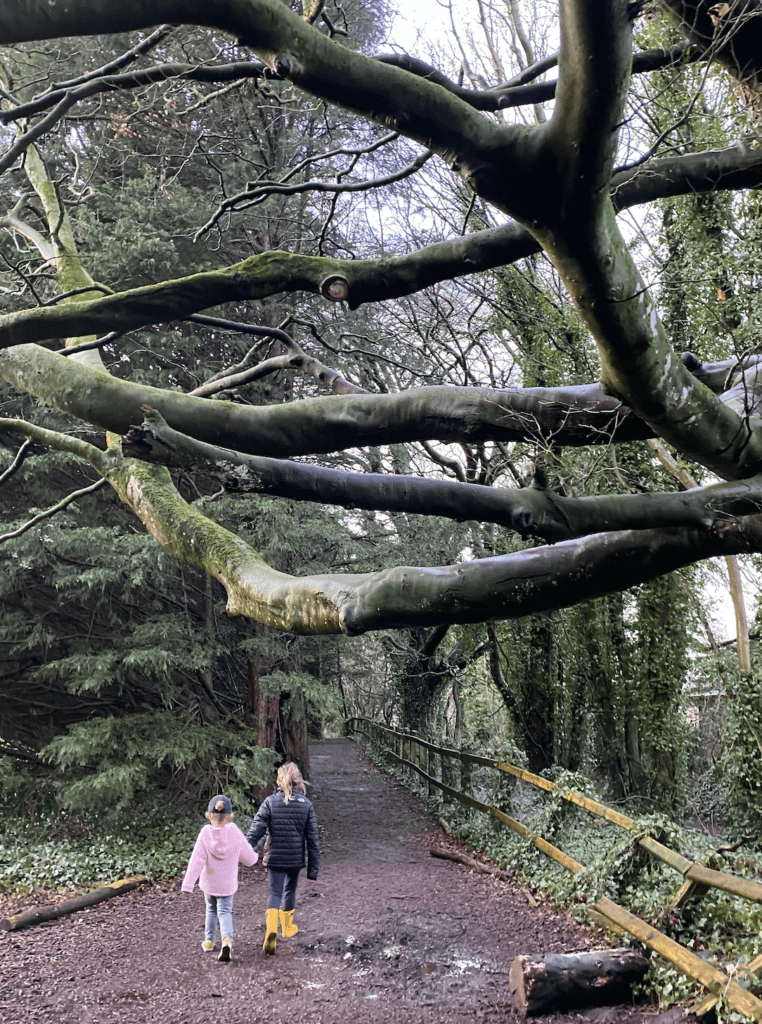
We had plans of staying in Northern Ireland and to spend time in Belfast. And to explore Northern Ireland but out plans had to change. President Trump announced that flights coming in and out of different countries were not going to be allowed in 3 days. We decided that night to get in our RV and drive straight to Dublin and get a hotel and try to get an earlier flight.
Head to Dublin. We ate at a few nice restaurants, shopped in St Stephen Green shopping centre, and stayed at the Westbury hotel . We walked around Grafton Street. There wasn’t much open because of the pandemic so we were limited in Dublin.
We ate at the Fire Steakhouse, Kokoro Ramen, Ferno 500 and at the Westbury Hotel.
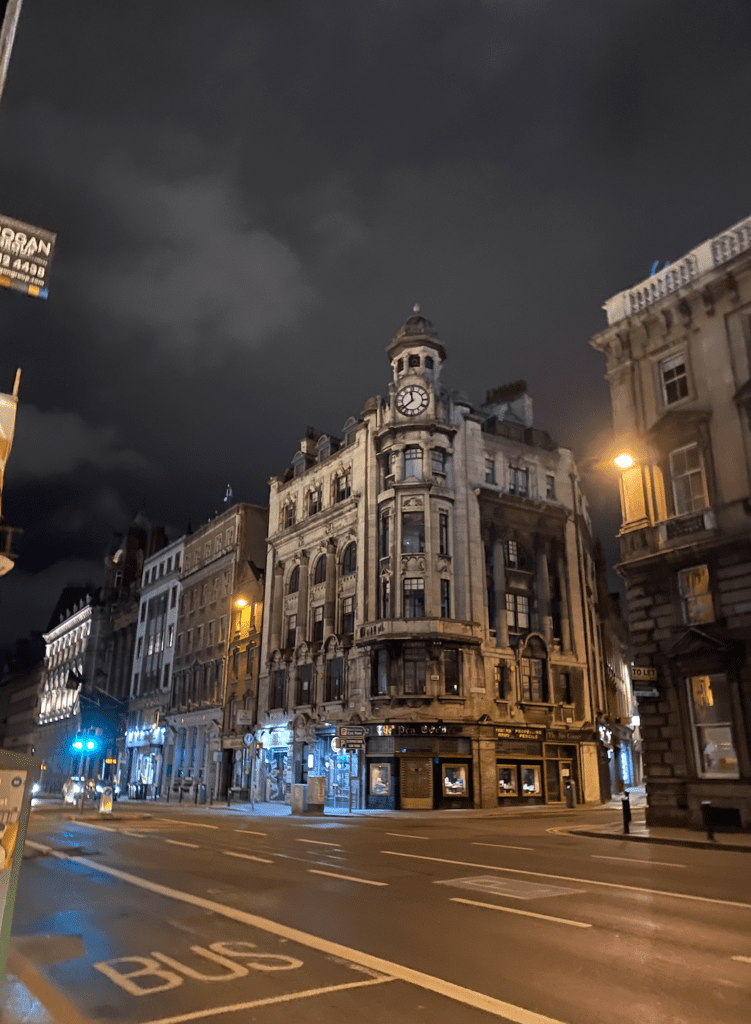
Our trip had 10 days so we decided to stay in Dublin until our flight took off. We were planning on taking Northern Ireland slow and spending day 7 and day 8 in Northern Ireland.
Then day 9 we would drive to Dublin and return the RV and get a hotel for the night to get situated before a long flight home.
Here is the entire loop that we did and the direction we drove
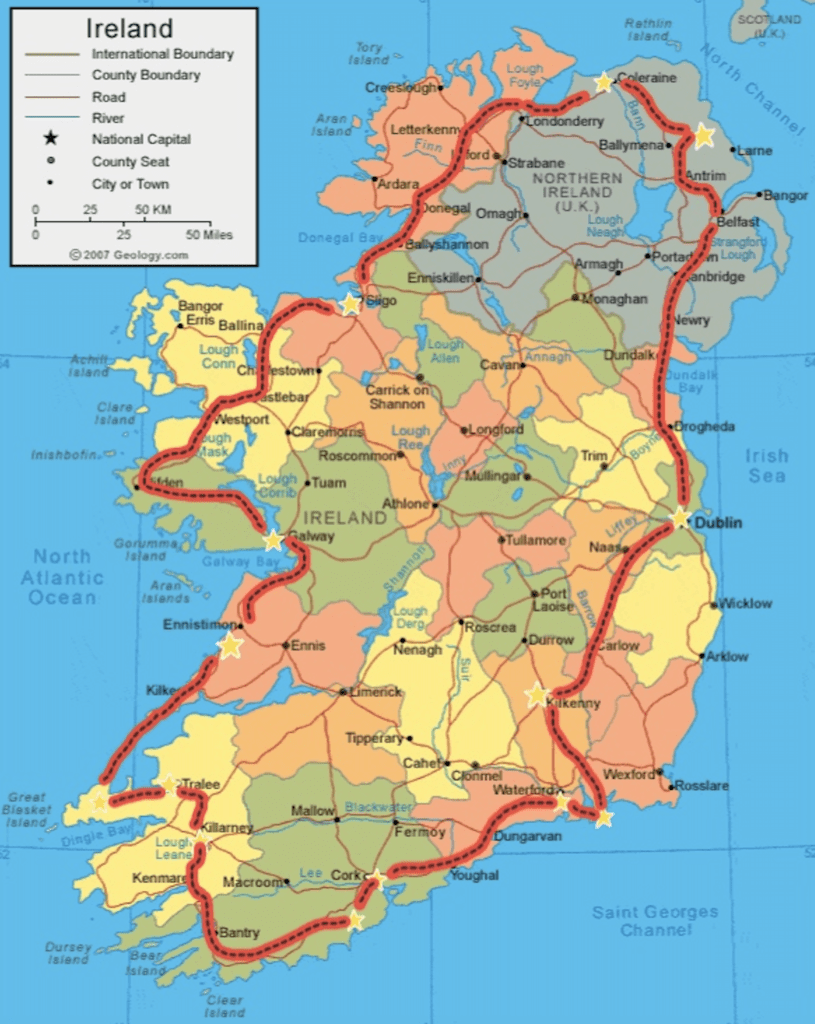
Similar Posts

Fire Torched Oatmeal and the perfect Arizona Vacation
Scottsdale is one of my favorite places to visit in Arizona. The shopping, food and activities are amazing. Top it off with some of the best pools and resorts in Arizona and you have got it made. My husband and I were able to visit a Four Seasons Resort that was about 45 minutes from…
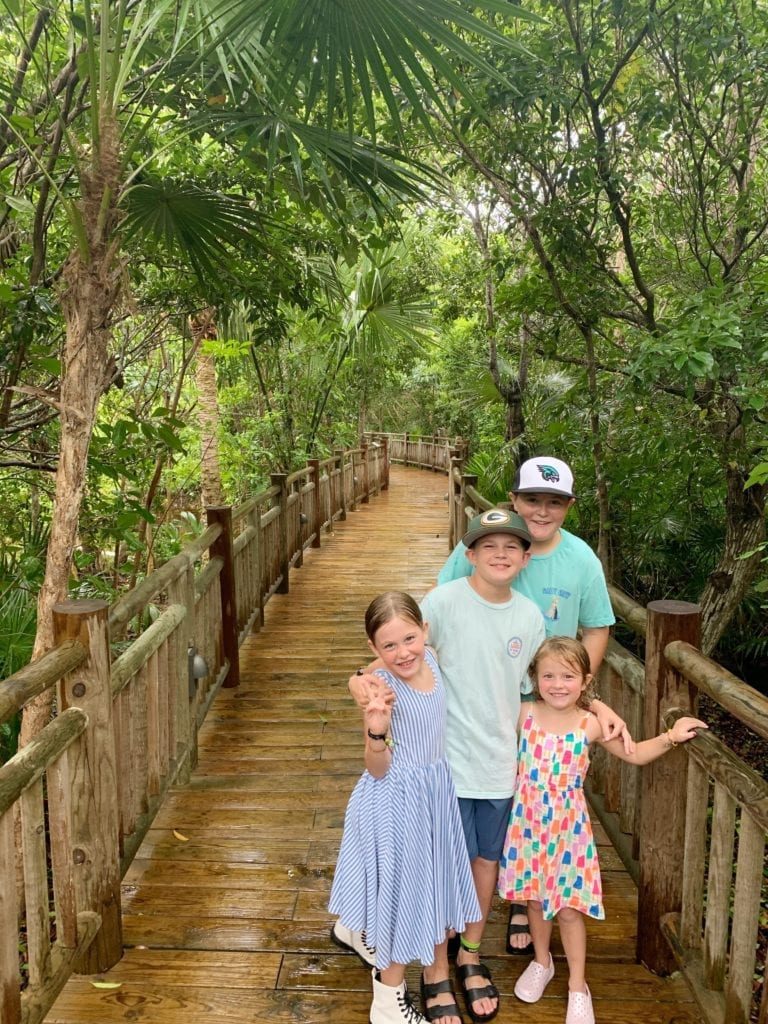
Best Cancun Resort for Children
Best Cancun Resort for Children Looking for the best resort to travel with your children to in Cancun Mexico? I have got it for you! Vidanta is an amazing resort with hundreds of acres of property to explore. I have 4 kids ranging from 12 to 5 years old. We have taken our children to…
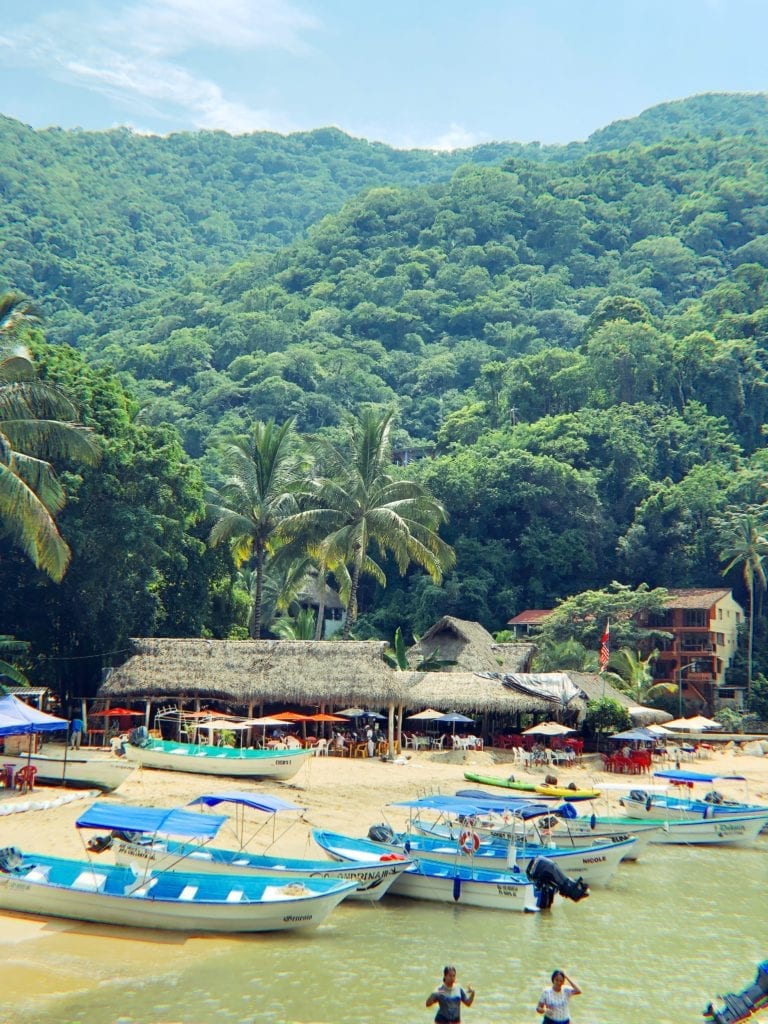
Traveling to Mexico with Children
Puerto Vallarta, Mexico with Children Traveling with children into Mexico can make some people nervous. I am here to give you confidence in planning an amazing and safe vacation with your family. For other traveling tips and tricks check out these posts: My Travel Essentials New York City Travel San Fransisco Travel Foods Best Cancun…
International Food Bloggers Conference
First off I want to announce the winner of the Flatbread GIVEAWAY! CONGRATS DENISE ELMER! Next I wanted to thank Krusteaz for such an amazing trip to Seattle! I had so much fun that I wanted to share my experience with you all! I was able to attend the International Food Bloggers Conference…
New York City Travel
I am a person who absolutely loves to travel. I travel at least once a month. So far this year I am averaging 2-3 trips a month. haha I know that may be a little excessive but I believe in creating memories on trips. Besides the blog conferences I attend a majority of these trips…
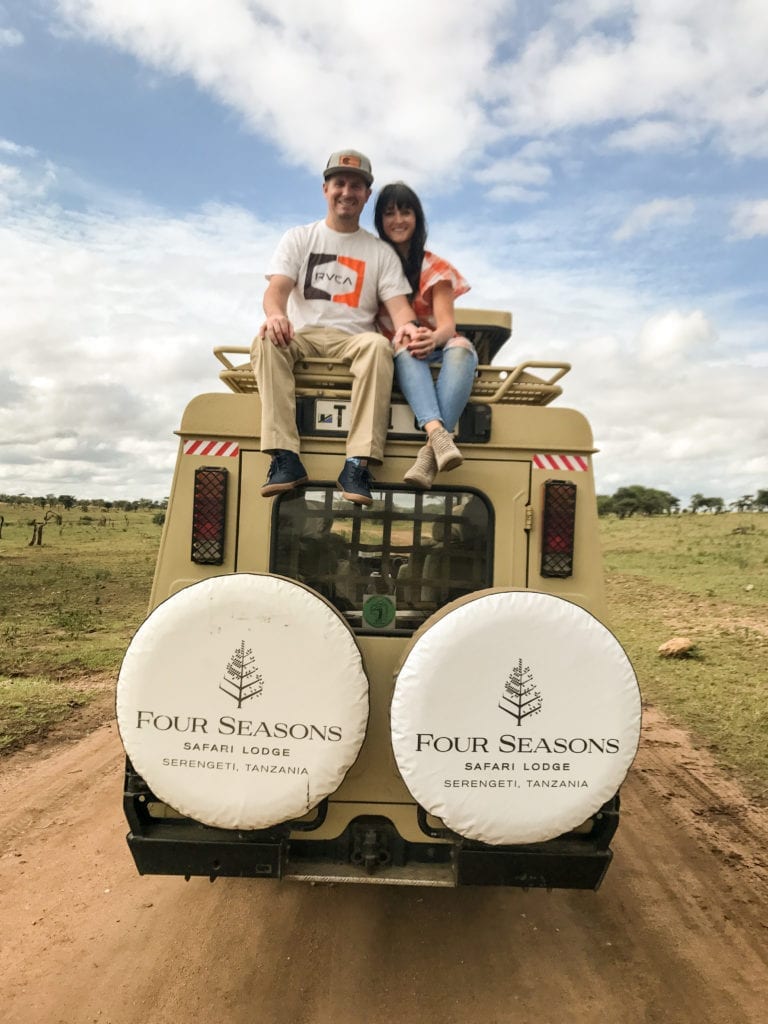
The Ultimate Africa Safari Trip
Bucket List Trip Here is my #1 bucket list item. An African Safari. Guess what my husband and I checked off for our 10th anniversary? You guessed it an African Safari. Here is the itinerary we did! The flight was so long and far away and we needed to have a layover. So I searched…
Leave a Reply Cancel reply
Your email address will not be published. Required fields are marked *
One Comment
So glad I found this! We are spending 8 weeks in Europe this summer and 1 of those weeks is in Ireland. We also have 4 kids 2 boys and 2 girls ages 11, 9, 7, 5 and its been a challenge trying to find anything that fits us. There are zero rental cars and airbnbs in Ireland are obscenely expensive! People kept telling us that RVing Ireland isn’t “a thing” but with kids this age we don’t want to be stuck on tour buses or in lines or paying an arm and a leg for everything. We want open spaces, ancient ruins, and the chance to explore in the unconventional giant-family-that-insists-on-traveling-anyway sort of way that many people don’t seem to get. This blog gave me all the assurance and confidence I needed to know that this was the right choice for us! Thanks!

COMMENTS
Travel & Explore with Indie Campers. Compare & Find The Best Campervan For Your Roadtrip! Book with the World's Nº1 Campervan Rental. Easy and Fast Booking Online!
Find & Book the Best Things to Do in Ireland. Tours, Activities, Excursions in Ireland. Quick & Easy Purchase Process! Full Refund Available up to 24 Hours Before Your Tour Date
Some of the best places to visit in Ireland with a campervan or motorhome include: Cliffs of Moher - unbelievably dramatic. The Wild Atlantic Way- 1700 miles of dramatic coastline and traditional Irish culture. Giants Causeway (Northern Ireland) Dark Hedges road- famous as a Game of Thrones filming location.
Motorhome & Campervan Travel in Ireland. Ireland is a fantastic non-Schengen option for motorhome travel. Easily accessible from the UK or Northern Ireland, this understated country packs a punch of lush rolling hills, dramatic coastlines, rich heritage and entertaining cities.
The Wild Atlantic Way is a 2,500 km route along the west coast of Ireland, offering total immersion in the country's unspoilt wilderness. Starting from the Inishowen Peninsula in County Donegal, this route takes you past isolated peninsulas, deserted beaches and impressive cliffs.
Motorhoming in Ireland - A Complete Guide Motorhome & Campervan Travel in Ireland. Ireland is a viable non-Schengen destination for motorhome travel. It can be easily reached from the UK or Northern Ireland and offers a blend of scenic landscapes, cultural heritage, and urban centres.
If you're planning a motorhome trip on the west coast of Ireland, there is an infinite list of things to do and places to see. In fact, the Ring of Kerry is close to many of these: Derrynane, Rossbeigh, and St Finian's Bay beaches. Lakes of Killarney. Killarney National Park. Muckross House and Gardens. Galleries and old-fashioned pubs in ...
20 day tour of Ireland in our motorhome. We went clockwise from Dublin around to Westport before we worked our way back to Dublin. Total miles from Wakefield...
From the coast to the mountains, some of the best road trips Ireland has to offer include: • The Copper Coast - Tramore to Dungarvan. • The Wild Atlantic Way - Inishowen Peninsula to Kinsale. • The Ring of Kerry - Killarney. • Mayo coastal road trip - Ballina to Killary.
Roam contemporary art galleries in Athlone and Leitrim, sip a Guinness in Sean's Bar in Athlone (Ireland's oldest), marvel at stunning decorated high crosses at the ruined abbey at Clonmacnoise, and tour Ireland's spiritual heartland, The Hill of Uisneach near Lough Ree. Stay at the motorhome overnight stop at Portumna.
The Wild Atlantic Way stretches 2500 kilometres along the rugged coastline and is the longest tourist coastal route in the world. The Causeway Coastal Route is also an impressive way to discover Ireland by motorhome. The route goes from Belfast to Londonderry. In addition, the Ring of Kerry is often regarded as one of the country's most scenic ...
Ireland also has a culinary landscape boasting exquisite home-grown ingredients from the sea to the land, which is why Motorhome hire in Ireland is very popular. Tour around Ireland-Belfast Belfast is Northern Ireland's capital and the birthplace of the Titanic which famously struck an iceberg in 1912.
To hire a camper van on the island of Ireland, you must hold a valid driver's licence or an international driving permit. It's a good idea to obtain travel insurance before your trip as well. Rental prices vary by season and vehicle availability, so make sure you shop around to get the best deal! Expect to find them from about €245/£215 per ...
Tour the Republic of Ireland in your caravan or motorhome for a magical mystery tour of ancient landscape, mysterious castles and lively cities. It's compact enough to explore it all. Your first stop should be Dublin, enjoy a Guinness or two in the lively city centre and then take the short drive south to the Wicklow Mountains - be sure to ...
Motorhome Ireland: 8 Things We Learned. We're recently back from a cracking four-week, self-guided motorhome tour of the Republic of Ireland. We focussed on the south-west of the country, taking our time to explore the southern end of the Wild Atlantic Way. Although we've travelled across much of Europe, this is the first time we've ...
Ireland is a country that needs to be explored by a campervan for many reasons. There are so many amazing campsites scattered around Ireland making it an idyllic place to camp. ... It is recommended if you are in a campervan/small RV to travel in the same direction as the tour buses. All the tour buses have to travel in an anti-clockwise direction.
The Fermanagh Lakelands are a relaxed area to explore by campervan any time of the year, with scenic drives and viewpoints around the waterways of Lower and Upper Lough Erne, as well as natural wonders, forest parks and stately homes. Visit the Marble Arch Caves for an underground boat trip through limestone caves formed 330 million years ago ...
Suggested activity for the day: Dublin Guinness factory. Night 2:From Dublin - Galway. Campsite: Salthill Caravan Camping. Pricing: Motorhome with 2 adults €28 + €6 for electricity. Suggested activity for the day: Sail in a 120 year old Galway Hooker, Out to Galway bay to view the coasts. Night 3:Galway - Kilkenny.
Here is home to the famous Bushmills Distillery and the natural phenomenon of the Giants Causeway. We then make the leisurely journey all around Ireland, returning to the North again at the end, having competed a full circle. This tour offers wonderful travel in your own motorhome, in lovely locations whilst remaining socially distanced as ...
The most important traffic rules for motorhomes and caravans in Ireland. Left-hand traffic: most visitors from mainland Europe often need a few days' driving practice in Ireland before they are comfortable with left-hand traffic.Therefore, given the weight and size of your motorhome or car/caravan combination, careful driving is a must.
Welcome to Ireland's wild west coast, where land meets sea in a remarkable union of natural beauty and mystery. It's also home to the world's longest coastal route, the Wild Atlantic Way. Motorhome travellers have been traversing the boundary of Ireland's outermost peninsulas for as long as motorhomes have had wheels. This drive is up there with the world's best coastal road trips ...
RV rental in Ireland. Start your RV tour in Dublin and discover Ireland with a rental RV from Campanda. Check out RVs for rental in Ireland! i. Help center. How it works FAQ. Write us email at [email protected]. Login. List your RV. Distance - up to 276 km. 25 km. 276 km. Travel period. Seats. 0+ Sleeps. 1+
St Patrick's Heritage Trail. 1. The Wild Atlantic Way. You can start this route at either Donegal or Cork. The driving route is over 1600 miles (2600 km) and can last between 7-21 days. The Wild Atlantic Way is an unmissable driving route in Ireland, and arguably the pinnacle of Irish road trips. Stretching 2600 km in length along Ireland's ...
We ate at the Fire Steakhouse, Kokoro Ramen, Ferno 500 and at the Westbury Hotel. Our trip had 10 days so we decided to stay in Dublin until our flight took off. We were planning on taking Northern Ireland slow and spending day 7 and day 8 in Northern Ireland. Then day 9 we would drive to Dublin and return the RV and get a hotel for the night ...
IRISH MOTORHOME CLUB. Welcomes all Motorhome enthusiasts. Updated April 2024. Click this button Renew Existing Membership. Irish Motorhome Club, welcomes all Motorhome enthusiasts to our Club, We are a family friendly group who meet for Rally Get Togethers, Motorhome Tours at regular intervals in Ireland and Europe throughout the year.